Cayman Islands – Founded upon the Seas – and Mahogany

by P. Ann van B. Stafford
The three Cayman Islands are located in the western Caribbean Sea, south of Cuba and some 270 miles NW of Jamaica. Grand Cayman is 76 square miles, Little Cayman 10 square miles and Cayman Brac 14 square miles.
Mahogany, West Indian Mahogany – Swietenia mahagoni is native to Florida and the West Indies, including the three Cayman Islands.
Cayman’s plants and history are woven together, like the wattles of Wattle and Daub houses.
Grand Cayman Land Grants
1734 – 1742
Mahogany – Swietenia mahagoni, Endangered.
1730s – 1740s The first formal land grants were made in Cayman, mainly to cut Mahogany. Mahogany furniture had become popular in Britain and Europe and Mahogany surpassed turtle as Cayman’s most valuable product.

West Indian MahoganySwietenia mahagoni (L.) Jacq.
Native to:
Bahamas, Cayman Is., Cuba, Dominican Republic, Florida, Haiti, Jamaica, Turks-Caicos Is.
Introduced into:
Andaman Is., Assam, Bangladesh, Caroline Is., China South-Central, China Southeast, Hainan, India, Laos, Leeward Is., Lesser Sunda Is., Marianas, Mauritius, Nicobar Is., Puerto Rico, Réunion, Taiwan, Thailand, Trinidad-Tobago, Venezuela, Venezuelan Antilles, Windward Is.

See below for more information about Big-leaf Mahogany, Honduras Mahogany – Swietenia macrophylla
The first Land Grants, made by the Governor of Jamaica in Spanish Town, Jamaica (1734 – 1742), were to cut Mahogany for export to Jamaica and thence to England.
1734 The first land grant was to Daniel Campbell, Mary Campbell (probably Daniel’s widowed mother) and John Middleton for 3,000 acres in the area between Prospect and North Sound.
House of Campbell and Middleton: between Hog Sty Bay and George Town Barcadere, somewhere in the vicinity of the present Butterfield roundabout, junction of North Sound Road and Esterley Tibbetts Highway.
In 1729 Daniel Campbell was granted 3000 acres in Westmoreland, Jamaica.
1734 Dec. 2. Battersby and Foster, two Jamaican merchants, made an agreement with John Bodden of Grand Cayman to take 8 male slaves to Grand Cayman cut Mahogany, in return for a quarter of the profits from the venture. John Bodden asked John Middleton for advice on the best place for lumbering.
1735 Battersby went to Grand Cayman, found the slaves working near the Great Sound at a place called Bodden’s Work. (A History of the Cayman Islands by Neville Williams 1970 p.17-18)
1735-1741 There was considerable informal settlement.
1741 Murray Crymble had a land grant of 1000 acres in Cayman. He was an absentee land patentee, a prominent Jamaican merchant, Receiver-General in Jamaica and extremely wealthy. He seems to have had mercantile dealings with Central America, including Roatán, one of the Bay Islands of Honduras.
1741 Samuel Spofforth, a wealthy absentee merchant, had a land grant of 1000 acres in West Bay. He was a prominent Bermudian shipowner. He cut Logwood (Haematoxylum campechianum), from Central America, for its dye, and also Mahogany, for its timber, from Cayman.
1741 William Foster had a land grant from the present centre of George Town south to Pull-and-Be-Damned Point, South Sound. Foster had become acquainted with this area of S.W. Grand Cayman during the 1730s, when he was in partnership with fellow Jamaican, Benjamin Battersby. They had an agreement to fell and cut Mahogany.
In 1745 William Foster of Kingston was granted 3000 acres alongside the Great River in Westmoreland, Jamaica.
1742 Mary Bodden, the final land grant of land of 1,000 acres, in the Newlands area, dated January 15.
1741-42 Land Grants A codicil stipulated that those who could prove, with two witnesses before a magistrate, that they had occupied, planted or felled trees within the granted land, could retain possession of that land, with 30 acres of adjacent woodland, provided that they took out a patent within two years. (Founded Upon the Seas, p.41)
1741-42 Land Grants – all grantees were to bring ten white servants into their plantation, regardless of how many slaves they owned. Walter / Watler may have come with Foster.
Surveyors:
Richard Jennings, from Bermuda
Thomas Newlands
1741 August Governor Edward Trelawney of Jamaica ordered Richard Jennings to survey Grand Cayman prior to grants of 1000 acres each to Spofforth, Foster and Crymble, to encourage settlement to defend from Spanish attack. Williams p.18
Thomas Newlands was a timber merchant. He surveyed Mary Bodden’s 1000 acres. Timber shipped to Jamaica via North Sound. Williams p.19
Problems of Land Tenure
It was Jamaican merchants who exploited the market for the hard woods in the interior, and the turtle trade.
Williams p.21
1739 -1748 Anglo-Spanish wars – War of Jenkins’ Ear


West Indian Mahogany tree in George Town, Grand Cayman





included Mahogany from Cayman.
Mahogany Furniture
Mahogany changed the British and European furniture industry.
Thomas Chippendale (1718-1779) was one of the leading cabinet-makers of the 18th. Century.
Rococo style was used in Chippendale’s designs of Mahogany chairs with intricately pierced slats and for elaborately carved furniture.
Thomas Chippendale (1718-1779) Biography, Furniture and Facts
What Materials are Used to Make Chippendale Furniture? | Laurel Crown
Probably one of the most distinguished British cabinetmakers of the 18th. Century, Thomas Chippendale launched a furniture style that is still one of the most sought-after antique furniture for collectors and admirers today. …. He was the mastermind behind a furniture style that was named after the artisan rather than the reigning monarch, which at that time was revolutionary.
Chippendale Mahogany Side Chair c.1760

An exceptionally fine 18th Century Mahogany Chippendale Side chair of superb colour and patina. The top rail crisply carved with scrolling leaf work and flowers, with finely carved tassel dropping from the centre. The superbly shaped pierced and carved interlaced splat flanked with roses. The well drawn cabriole legs are finely carved with an abundance of scrolls and curling leafs, terminating with a claw and ball foot. The carving extends from the shaped ear pieces at the top of the legs across the bottom of the front rail in a fine flower and ribbon pattern with punchwork to the background. A masterpiece from the pinnacle of the English chair making tradition,circa 1760

George III Mahogany library desk attritubed to Thomas Chippendale, c.1760. Sold for $168,750. Oct.17, 2017 at Christie’s in New York.
George III Mahogany breakfront bookcase by Thomas Chippendale, 1764. Sold for £2,057,250. on June 17, 2008 at Christie’s in London.
The English Mahogany Trade 1700-1793
by Adam Bowett November 1996
The Jamaica Trade: Gillow and the Use of Mahogany in the Eighteenth Century
By Adam Bowett
Mapping the Mahogany Trade in the 18th and 19th Centuries
Lecture by Adam Bowett, Yale University, November 2018
Furniture historian Adam Bowett outlines the development of the British and American mahogany trade from its tentative beginnings in the early 18th century to its climactic peak 150 years later. Bowett puts particular emphasis on the ways in which British colonial policy, combined with other commercial and economic factors, dictated the geographical spread of the trade, and considers the implications for current research on historic British and American mahogany furniture. Bowett has published widely in academic and popular journals and is the author of two books on English furniture.
Until 1760s over 90% of Mahogany imported to Britain came from Jamaica.
Cayman Exports
Mahogany, Fustic, Logwood, Turtles, Cotton and Silver Thatch rope were exported.


1764 third week of February – Mahogany carriers arrived in Kingston, Jamaica from Grand Caymanoes
50 ton brig Success
30 ton sloop Eagle recently captured and renamed
Together they unloaded 80 tons of timber at Kingston.
Their escort sloop also called Eagle carried 30 tons of Mahogany.
1764 April 15 ton Greyhound to Kingston from Grand Cayman with 15 tons of Mahogany
1765 Royal Navy officers Remark Books provide information about Cayman. HMS Active anchored off Grand Cayman. Captain Robert Carkett noted that there were about 20 families, most of whom cut Mahogany (Swietenia mahagoni) and Fustic (Maclura tinctoria) which were exported to Jamaica.
1768 March 30 30ton sloop Diamond arrived in Kingston from Grand Cayman with 400 ft Mahogany, 260 pieces of timber and 2 tons of Fustic, then set sail for Honduras in ballast.

Fustic – Maclura tinctoria, Family: MORACEAE, is native to the West Indies and continental tropical America. It was exported for its yellowish dye, known as fustic or khaki, which was extracted from the wood.
1765 Cayman – 2 Walter brothers married 2 Bawden sisters in Jamaica, parish unknown.
Waide Walter Snr, mariner, married Rachel Bawden
Stephen Walter, mariner, married Sarah Bawden
1765 William EDEN from Wiltshire, England (b.1737- d.1801), arrived in Grand Cayman from Jamaica
1770s Settlers produced cotton for export, and for their own consumption and passing vessels – corn, yams, sweet potatoes, plantains, melon, limes, oranges and other fruits and vegetables. A few people of considerable property between them owned half a dozen sloops and schooners – for turtling and trafficking to Jamaica
Cotton
Sea-island Cotton, Long-staple Cotton – Gossypium barbadense
Wild Cotton, Short-staple Cotton = Gossypium hirsutum
1773 Gauld survey map and notes, early settlers: population 450: “in all 39 families, consisting of at least 200 white people and above [the] same number of Negroes and Mulattoes.

21 families at Bodden Town (South Side), 13 at West End commonly called Hogsties (present day George Town), 3 at East End and 2 at Spot’s Bay.
Gauld map 1773
https://www.crouchrarebooks.com/maps/cayman-islands
1773 There was a triangular trade between Jamaica, Cayman and British Settlements in Central America, especially British Honduras (Belize) and along the Mosquito Coast.
1783 Memorandum and sketch map seized by Spanish authorities in Cartagena from Robert Hodgson Jr, British Superintendent of Mosquito Shore, who had been captured en route to England.
Reciprocal trade, between the British and Spanish colonies was continued, even though such trade was not formally permitted. Grand Cayman was an important relay station in this indirect trade. Some ships arriving in Kingston carried logwood, cocoa and sarsaparilla.
Cocoa, Chocolate tree – Theobroma cacao wasn’t grown in Cayman. It is native to continental tropical America.
Cocoa arrived in the British Isles in the 1650s, which was more or less at the same time as coffee. With Cromwell’s forces Britain took over the control of Jamaica from the Spanish. At the time cacao plantations were already flourishing there, and these became the main source of British chocolate.
Sarsaparilla – Smilax ornata = S. regelii is native to: Belize, Costa Rica, Guatemala, Honduras, Mexico Gulf, Mexico Northeast, Mexico Southeast, Mexico Southwest, Nicaragua.
It has been introduced into Jamaica.
Sarsaparilla root was used, historically, in the treatment of syphilis.
(Wire Wiss, Wiry Vine – Smilax havanensis is native to the Cayman Islands, Bahamas, Cuba, Florida and Turks-Caicos Islands.)


Wiry Vine – the leaves were crushed and the juice taken for Malaria.
Wilfred Kings, Report on the Botanical Collection: Plants of Reputed Medicinal Value –
1938 Oxford University Biological Expedition to the Cayman Islands.
Miskito Coast / Mosquito Shore of Nicaragua and Honduras
1787 Miskito Coast / Mosquito Shore of Nicaragua and Honduras evacuation by the British, to Grand Cayman via Belize, of 300 or so settlers including 250 slaves. The population was substantially increased and new cotton plantations were established.
Caribbean Mosquito Coast (or Miskito Coast)
Fustic – Maclura tinctoria
Fustic – Maclura tinctoria, is dioecious. Male and female flowers grow on separate trees. Fustic was exported for its khaki dye.



Logwood – Haematoxylum campechianum
1715 Logwood was introduced in to Jamaica by Henry Barham (father of Dr Henry Barham), Mesopotamia Sugar Estate, Westmoreland, Jamaica. The wood is ready to be cut into logs after 11 years, unlike Mahogany, which takes many years to reach maturity.
Logwood was introduced in to Grand Cayman, probably in the mid-eighteen century.

Logwood heartwood is red when freshly cut.

Logwood doesn’t float, Mahogany floats.
It has become invasive.
Description—The name of the genus comes from the Greek and refers to the blood-red colour of the heart-wood. Haematoxylon campeachianum is a crookedly-branched, small tree, the branches spiny and the bark rough and dark. The leaves have four pairs of small, smooth leaflets, each in the shape of a heart with the points towards the short stem. The flowers, small and yellow, with five petals, grow in axillary racemes.
Logwood and Brazilwood: Trees That Spawned 2 Nations
by Wayne P. Armstrong (Spring 1992)
Logwood – Haematoxylum campechianum
Brazilwood – Paubrasilia echinata synonym Caesalpinia echinata
Extract:
Brazilwood (Caesalpinia echinata)
There are European records of true red dyes during the Middle Ages, primarily from the heartwood of an Asian tree called sappanwood (Caesalpinia sappan). Sappanwood is native to India, Malaya and Sri Lanka, and is cultivated throughout the Asian tropics. The wood was imported into Europe since medieval times, but only in limited quantities. The dye was a beautiful red, the color of burning coals (in Old French and English “braise“) and was called bresil or brasil by the early Portuguese traders. In 1500, Portuguese ships discovered and claimed the Atlantic side of South America that straddled the equator and the tropic of Capricorn. This massive land was called “Terra de Brasil” and later Brazil, because of the dyewood trees (Caesalpinia echinata) that grew there in abundance. Like the closely related sappanwood, the valuable dye from brazilwood (called brazilin) became a popular coloring agent for cotton, woolen cloth and red ink. As with precious cargoes of gold and jewels, Portuguese ships loaded with brazilwood were favorite targets of marauding buccaneers on the high seas.
Logwood – Haematoxylum campechianum
Meanwhile, the Spanish had discovered another leguminous tree in Yucatan with a deep red heartwood very similar to brazilwood. The tree became known as logwood (Haematoxylum campechianum), and by the late 1500s Spanish ships were exporting large cargoes of the valuable heartwood from the Yucatan coast. At this time it was common practice for British privateers to attack and destroy the Spanish vessels. In his book British Honduras (1883), A. R. Gibbs describes one such privateer, a Captain James, who discovered that the debarked heartwood sold in England for the enormous price of one hundred pounds sterling per ton. English political economist Sir William Petty estimated that the average value of merchandise a ship of the 1600s could carry in a year was 1000 to 1500 pounds sterling. A single load of 50 tons of logwood was worth more than an entire year’s cargo of other merchandise!
There were other natural red and purple dyes used in medieval Europe, including
madder ,
carmine, Tyrian purple, and the lichen dyes orchil and cudbear. Like sappanwood, they were all imported from faraway lands and were very expensive. Since these animal and vegetable extracts were considered to be superior permanent dyes, many English dyers vigorously opposed the cheaper, imported heartwood dyes from Mexico and Central America. Between 1581 and 1662 an Act of Parliament strictly forbade the use of logwood for dyeing. Although anyone violating this law was subject to imprisonment or the pillory, some dyers apparently discovered the colorfast attributes of logwood and used it under other names.
Red Bay
Red Bay was so-called because the sea water was stained by Mahogany logs floating on the water, awaiting shipment to Jamaica.
The reddish-brown color is produced by carotenoid and anthocyanin pigments which are found in the
roots, stems, flowers, fruit, and rarely, in the leaves.




A Brief History of the Cayman Islands
by David Wells of the West India Committee
for the Government of the Cayman Islands
Big-Leaf Mahogany, Honduras Mahogany –
Swietenia macrophylla
Big-leaf Mahogany Swietenia macrophylla King
Native to:
Belize, Bolivia, Brazil North, Brazil Northeast, Brazil West-Central, Colombia, Costa Rica, Ecuador, Guatemala, Honduras, Mexico Central, Mexico Gulf, Mexico Northeast, Mexico Northwest, Mexico Southeast, Mexico Southwest, Nicaragua, Panamá, Peru
Introduced into:
Andaman Is., Bangladesh, Caroline Is., Cayman Is., Comoros, Cuba, Dominican Republic, El Salvador, French Guiana, Haiti, Jamaica, Laos, Leeward Is., Marianas, Nicobar Is., Puerto Rico, Seychelles, Solomon Is., Thailand, Trinidad-Tobago, Venezuela, Venezuelan Antilles, Vietnam, Windward Is.
Big-leaf Mahogany, Honduras Mahogany – Swietenia macrophylla in the Dart Family Park, Grand Cayman. It was blown down by Hurricane Ivan in Sept. 2004.
Notes, References and Links
Cayman history, architecture, step-wells, house-shaped gravestones (grave markers) in Grand Cayman cemeteries, Cayman traditional arts and crafts. Catboats – local woods used catboat construction, Silver Thatch plaiting, gigs, calavans, paintings, Miss Lassie’s house, Wattle and Daub houses and the woods that were used in their construction.
1802 Lt. Governor Nugent Letters On The Cayman Islands
Corbet Report
1802 Grand Cayman Census
pp. 8-13
1656 Jamaica – The Settlers From Nevis
pp. 14-16, including Bowden
British Honduras, later called Belize
British Honduras: An Historical and Descriptive Account of the Colony From its Settlement, 1670
In the Eye of All Trade: Bermuda, Bermudians, and the Maritime Atlantic World, 1680-1783
by Michael J. Jarvis, 2010
In an exploration of the oceanic connections of the Atlantic world, Michael J. Jarvis recovers a mariner’s view of early America as seen through the eyes of Bermuda’s seafarers. The first social history of eighteenth-century Bermuda, this book profiles how one especially intensive maritime community capitalized on its position “in the eye of all trade.”
Jarvis takes readers aboard small Bermudian sloops and follows white and enslaved sailors as they shuttled cargoes between ports, raked salt, harvested timber, salvaged shipwrecks, hunted whales, captured prizes, and smuggled contraband in an expansive maritime sphere spanning Great Britain’s North American and Caribbean colonies. In doing so, he shows how humble sailors and seafaring slaves operating small family-owned vessels were significant but underappreciated agents of Atlantic integration.
The American Revolution starkly revealed the extent of British America’s integration before 1775 as it shattered interregional links that Bermudians had helped to forge. Reliant on North America for food and customers, Bermudians faced disaster at the conflict’s start. A bold act of treason enabled islanders to continue trade with their rebellious neighbors and helped them to survive and even prosper in an Atlantic world at war. Ultimately, however, the creation of the United States ended Bermuda’s economic independence and doomed the island’s maritime economy.
Merchants and Merchandise in Seventeenth Century Bristol
Bristol Records Society’s Publications
Vol. XIX
Appendix H p.286
Merchandise imported into Bristol 9 Nov. 1654 – 27 Oct. 1655
Cotton wool (Barbados, Nevis)
Fustic (Barbados)
Ginger (Barbados, Nevis)
Indigo (Barbados, Nevis)
Wild Indigo – Indigofera suffruticosa, native to the Cayman Islands
Indigo – Indigofera tinctoria, introduced into the Cayman Islands, native to the Old World, but now naturalized in most warm countries, formally cultivated as a source of Indigo dye.
Indigo was not exported from Cayman.
While used for one reason or another in ancient cultures for thousands of years, the dye became commercially valuable in the Western hemisphere at the same time that the Caribbean islands were being colonized by Europeans in the 17th and 18th centuries.
While short-lived, indigo production, along with tobacco, cocoa, coffee and ginger, dominated the plantation economies from Barbados to Hispaniola a hundred years before sugar and cotton would become the most lucrative crops in the region in the mid 1700s.
…. there is actually no blue color in any of these indigo-bearing plants. The green leaves (and sometimes stems) of “indigo” plants yield a yellow or greenish color that turns blue with the magic of oxidation, especially as induced by man.
Although the growing and harvesting of the plants was not particularly hard work, the processing was neither a pleasant nor healthy enterprise.
Lignum vitae (Barbados, Nevis)
Appendix I p.288
Merchandise imported into Bristol 29 Sept. 1685 – 28 Sept. 1686
From America and the West Indies
The Trade of Bristol in the Eighteenth Century
Bristol Records Society’s Publications
Vol. XX
Glossary p.192
Index of Persons and Places p.195
Index of Selected Subjects p.205
Bristol harbor, published c.1850, with ten sailing ships and rowing boats before the channel was filled in 1892–1938. Black and white etching showing the towers of St Stephen’s Church, St Augustine the Less Church and Bristol Cathedral,
Jamaican Family Search Geneaolgy Research Library Historical Background
Mahogany introduced into India
1795 Mahogany seedlings – Swietenia mahagoni, from Jamaica, were taken by the British to India and planted in the Botanic Gardens of Calcutta. The trees flourished, but several were destroyed in the great cyclone of 1864.
Pimento, Allspice
Pimento, Allspice Tree – Pimenta dioica (L.) Merr.
Family: MYRTACEAE
Native to Mexico, Central American and the Caribbean
Early Spanish explorers found the tree growing in Jamaica. It was identified in about the year 1509 and is closely related to the Bay Tree and to Cloves.
The tree is called Pimento and the berries Allspice. The cured berries combine the flavour qualities of Cinnamon, Cloves, Pepper and Nutmeg.
Pimento in Grand Cayman (Pimenta dioica):
“This species was at first thought to be solely an introduced cultivated plant until the dead remains of several very large old trees were found in a George Town building site. Later, documents were found in the Cayman Archives that recorded the export of significant amounts of Allspice from the Cayman Islands in the early to mid nineteenth century. It appears that groves of Pimento trees formerly grew in the part of Grand Cayman that is now urban George Town, but all original trees have now disappeared. Meanwhile, a few young trees are now developing from seeds or seedlings brought from Jamaica. However, the evidence suggests that the Allspice tree should be considered indigenous to Grand Cayman.”
George R. Proctor, Flora of the Cayman Islands, 2012, p.406
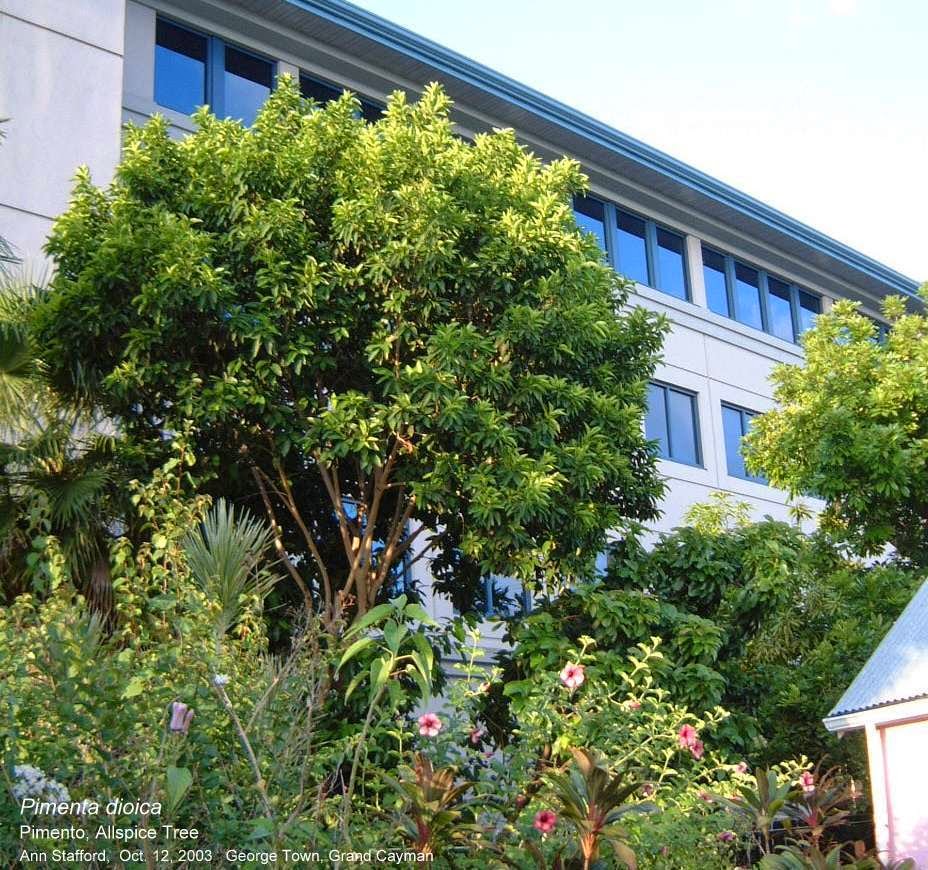
Tree: to 20 m tall; young branches flattened and 4-angled.

Bark: mottled cream, brown and tan, twisting lumpy surface that peels off in flakes

Leaves: Opposite, glandular dots more or less pellucid, strong aroma of pimento (allspice) when crushed

Flowers: inflorescence – panicle 6-12 cm long, many flowered, petals white, stamens numerous.
Individual flowers sometimes unisexual or apparently so.
Fruit: a fleshy, aromatic, 2-seeded berry, black when ripe.
Seeds: tough seed coat; the seeds lose their viability quickly; germination is more likely when the seeds have passed through the gut of a bird.
 The green fruits turn black when ripe. George Town, Grand Cayman, Jan. 15, 2014.
The green fruits turn black when ripe. George Town, Grand Cayman, Jan. 15, 2014.
 3 Pimento trees on School Road, George Town, Grand Cayman July 21, 2003
3 Pimento trees on School Road, George Town, Grand Cayman July 21, 2003
 Pimento trees on School Road, George Town, Grand Cayman after Hurricane Ivan (Sept. 2004)
Pimento trees on School Road, George Town, Grand Cayman after Hurricane Ivan (Sept. 2004)
Uses: the dried fruits (picked full-size when still green) are used as spice, for flavouring numerous foods. Oil extracted from seeds, leaves, and bark is used to scent cosmetics, foods, and many other things. The wood has various uses. Young saplings are used as walking sticks.
 Pimento tree in a garden on South Church St, Grand Cayman, Feb. 6, 2009
Pimento tree in a garden on South Church St, Grand Cayman, Feb. 6, 2009
Pimento Dram is a Jamaican liqueur with a rum base flavoured with Allspice.
Click here for more pictures and information: Jamaican Pimento
Medicinal Plants in the Cayman Islands

Cayman Islands Medicinal and Healing Plants, Bush Medicine
and old-time remedies.
by Ann Stafford, CaymANNature, August 16, 2019
The information is for educational purposes only and is not intended to be an endorsement of any of the old-time remedies. Some parts of a plant, ripe or unripe, may heal, while other parts of the same plant may be poisonous. There may be a fine line between kill and cure.
 Licorice, John Crow Bead, Rosary Pea, Crab’s Eyes – Abrus precatorius, the seeds contain ABRIN and are extremely poisonous.
Licorice, John Crow Bead, Rosary Pea, Crab’s Eyes – Abrus precatorius, the seeds contain ABRIN and are extremely poisonous.
 Castor Oil plant – Ricinus communis, the seeds contain the highly poisonous RICIN and can be fatal if swallowed. Heat inactivates ricin (a protein).
Castor Oil plant – Ricinus communis, the seeds contain the highly poisonous RICIN and can be fatal if swallowed. Heat inactivates ricin (a protein).
“The claims made for some of the plants may occasionally be justified by their chemical constituents. Some of them are, or have been, in the pharmacopoeias. On the other hand, in many cases the claims either have little justification or remain to be substantiated. Many of the doses used are of an unpleasant and even drastic nature. This may account for their popularity in view of the general impression that medicine must be unpleasant to be efficacious.”
Medicinal Plants of Jamaica by G.F. Asprey and Phyllis Thornton. Reprinted from the West Indian Medical Journal. Vol. 2 No. 4. Vol. 3 No. 1. 1953
Medicinal Plants JAMAICA 1953_Asprey, Thornton
MEDlCINAL PLANTS OF JAMAICA. PARTS 1 – IV
By F. Asprey, M.Sc., Ph.D. (B’ham.), Professor of Botany, U.C.W.l. and Phyllis Thornton, B.Sc. (Liverpool), Botanist Vomiting Sickness Survey. Attached to Botany Department, U.C.W.I. Reprinted. 86 pages.

Caribbean Sea
Glossary
decoction – boiled; the liquor resulting from concentrating the essence of a substance by heating or boiling, especially a medicinal preparation made from a plant.
dioecious – male and female flowers grow on separate plants.
infusion – steeped; a drink, remedy, or extract prepared by soaking the leaves of a plant or herb in liquid.
monoecious – separate male and female flowers grow on the same plant.
Cayman Common Names
Different countries have different common names, sometimes more than one for the same plant, or one name may refer to several different plants. Several trees around the world are called Ironwood, but Cayman’s culturally important Ironwood trees are only found in the Cayman Islands – Chionanthus caymanensis. Scientific names avoid confusion of which plant is being referred to.
Rosemary – Croton linearis is a common culturally significant Cayman shrub. It is called Pineland Croton or Granny-Bush in the US). It should not be confused with the culinary woody, perennial herb, Rosemary – Rosmarinus officinalis, native to the Mediterranean region, or the variegated leaf landscaping shrub, Croton – Codiaeum variegatum.

Links:
1938 Oxford University Biological Expedition to the Cayman Islands
Cayman Islands HERBARIUM
Links to photo albums:
Cayman Medicinal Plants and Cultural Uses
Wilfred Kings
Wilfred Kings was invited to join the 1938 Oxford University Biological Expedition to the Cayman Islands by Gemmell Alexander on March 21, 1938 in the capacity of Botanist, as their Botanist was unable to join the Expedition at last moment.
Report on the Botanical Collections
from Grand Cayman, Cayman Brac and Little Cayman
Wilfred Kings Sept. 1938
Grand Cayman May 13 – May 17 and June 11 – Aug.10
Cayman Brac May 18 – May 28
Little Cayman May 28 – June 11

Kings saw Mr Alston at the British Museum (Natural History), explained the situation, and that he was not a Specialist in any capacity. They were satisfied that he should go merely as a Collector.
 Natural History Museum, London, England
Natural History Museum, London, England
Mr Charles Elton and Dr Hobby in a interview at the Hope Department of Entomology, Oxford, were also willing for Kings to work in that capacity. Charles ELTON
Lawrence Sheriff School, Rugby, Governors granted Kings a leave of absence for the term, where he was the Geography Master. Kings eventually joined the party in Grand Cayman on May 13, 1938.
The Collection, as far as the Flowering Plants and Ferns were concerned, was almost entirely in duplicate.
FLORA of the CAYMAN ISLANDS by George R. PROCTOR, 2012 Extracts from p.19 and 21
‘The Oxford University Biological Expedition to the Cayman Islands, a party of five under the leadership of W.G. Alexander, carried out fieldwork from April 17 to August 27, 1938. The primary objects of attention were plants, insects, reptiles, and fishes, but nearly all animal taxa received some attention. The official botanist of this group was Wilfred W. KINGS, who joined the expedition about a month later than the others; he had been especially recruited from Lawrence Sheriff School, Rugby, because Oxford had no available botanist at that time. Before his arrival, some plant-collecting was done by C. Bernard LEWIS, whose interests were otherwise chiefly zoological. Kings gathered a large collection of material from all three islands; until recently, these excellent specimens constituted the major basis of our knowledge of the Cayman flora. The main set of the Kings collection is deposited at the British Museum (Natural History) in London, while duplicate material can be found in several other herbaria.
Lewis, then an Oxford student (a Rhodes Scholar from the United States), later became Director of the Institute of Jamaica in Kingston; he collected further Cayman plant specimens during the 1940s. His continued interest in the Cayman Islands has been a constant source of encouragement during the writing of this book.’
‘Collectors of Cayman Islands plants
Wilfred W. KINGS May-Aug. 1938. 645 specimens seen in Herbaria at British Museum, (Natural History), Gray Herbarium of Harvard University and Missouri Botanical Garden.
Bernard LEWIS Apr. 1938, Dec. 1944, Mar. 1945, Dec. 1945. 45 specimens seen in Herbaria at British Museum and Institute of Jamaica.’
TROPICOS Missouri Botanical Garden, Collector W. Kings 1938
Oxford University Expedition1938
Report on botanical collections from the Cayman Islands
by WILFRED KINGS
extract: Plants of reputed Medicinal Value




Harmful plants

 Maiden Plum – Comocladia dentata. DO NOT TOUCH – poisonous sap, skin irritant
Maiden Plum – Comocladia dentata. DO NOT TOUCH – poisonous sap, skin irritant
Kings GC 115, Lewis 3612.
Flora of the Cayman Islands, Proctor, 2012 p.487. Pl.44.
A to Z Cayman common name
Aloe Vera, Alloways, Bitter Aloes, Sempervivie, Sempervirens, Sinkle Bible – Aloe vera
Kings GC 122
Flora of the Cayman Islands, Proctor, 2012 p.174





Aunt Eliza Bush (Twining Soldierbush) – Myriopus volubilis syn. Tournefortia volubilis
Shrubby vine
GC 140, LC 12.
Flora of the Cayman Islands, Proctor, 2012 p.559



Basil, Tea Basil, Pimento Basil – Ocimum campechianum syn. O. micranthum
Kings GC 213; LC 6.
Flora of the Cayman Islands, Proctor, 2012 p.591



Ocimum campechianum = O. micranthum
Basil, Sweet Basil – Ocimum basilicum
GC 135
 Sweet Basil – Ocimum basilicum, very aromatic, growing in a Cayman garden, Oct.4, 2019
Sweet Basil – Ocimum basilicum, very aromatic, growing in a Cayman garden, Oct.4, 2019


Bay Vine – Ipomoea pes-caprae brasiliensis
A trailing vine, pantropical on sandy seashores.
The sticky upper surfaces of the young leaves were placed between sore toes, Kings 1938.
Kings GC 67; LC 18; CB 19.
Flora of the Cayman Islands, Proctor, 2012 p.552

Birch, Red Birch; (Gumbo Limbo – US) – Bursera simaruba
Flora of the Cayman Islands, Proctor, 2012 p.484




Broadleaf – Cordia sebestena var. caymanensis
Kings GC 63; LC 4; CB 89.
Flora of the Cayman Islands, Proctor, 2012 p.567

 Broadleaf – green, unripe fruits
Broadleaf – green, unripe fruits

 Broadleaf – white, ripe fruits
Broadleaf – white, ripe fruits
Castor-oil Plant, Castor Bean Plant, – Ricinus communis
Kings GC 128, 145; LC 108; CB 80, 81.
Flora of the Cayman Islands, Proctor, 2012 p.457



Castor Bean Plant, Lorna McCubbin 1995
Cat Claw – Volkameria aculeata syn. Clerodendrum aculeatum
A shrub with spiny, arching branches and white flowers. The leaves were boiled as a remedy for coughs.
Kings GC 133, 148.
Flora of the Cayman Islands, Proctor, 2012 p.584.

Caymania, Sweetheart – Desmodium adscendens
The Cayman Islands have several species of Desmodium – D. gangeticum, D. triflorum – Creeping Tick-trefoil, D. incanum – Chick Weed, D. tortuosum – Twisted Tick-trefoil, D. adscendens – Caymania, Sweetheart.
The seedpods have hooked hairs (the inspiration for Velcro) and cling to clothing, humans, animals, birds – hence the name ‘Sweetheart’.
D. adscendens (Sw.) DC. (accepted name) range: tropical South and Central America, the Caribbean and tropical Africa. It is a lawn weed in Cayman.

 Caymania, Sweetheart – Dedsmodium adscendens, showing flowers and seedpods.
Caymania, Sweetheart – Dedsmodium adscendens, showing flowers and seedpods.
Desmodium adscendens – Useful Tropical Plants
‘The plant has become a weed in many areas of the tropics and is often considered to be invasive. Because of the abundant small uncinate hairs on most species, the seedpods cling most tenaciously to clothing, to any part of the human body, and also to the feathers and hair of various animals, thus ensuring a wide dispersal of the plants.
Plants can flower and produce fruit all year round.
This species has a symbiotic relationship with certain soil bacteria; these bacteria form nodules on the roots and fix atmospheric nitrogen. Some of this nitrogen is utilized by the growing plant but some can also be used by other plants growing nearby.
In Cayman, it is marketed as ‘Caymania’.

Caymania – Desmodium adscendens


Cerasee – see Serasee – Momordica charantia

Cochineal, Scotchineal, (Prickly Pear) – Nopalea cochenillifera syn. Opuntia cochenillifera
Kings GC 340; CB 33.
Flora of the Cayman Islands, Proctor, 2012 p.259

Coconut – Cocos nucifera
Kings CB 52, 53.
Flora of the Cayman Islands, Proctor, 2012 p.165



Cow-itch – Mucuna pruriens
Kings GC 228.
Flora of the Cayman Islands, Proctor, 2012 p.371


Cow Tongue, Long Strap Fern – Campyloneurum phyllitidis syn. Polypodium phyllitidis
A fern that grows on trunks or mossy bases of trees, in sheltered woodlands, uncommon in the Cayman Islands. The leaves were boiled for colds.
Kings F 2, F 2a, F 26, F 41, F 42.
Flora of the Cayman Islands, Proctor, 2012 p.53. Fig.11, Pl.3


Cure-For-All – Pluchea carolinensis
A bushy shrub, used as a tea for colds, and hot as a poultice for strains or dislocations. Usage not recorded in Cayman.)
Kings GC 357.
Flora of the Cayman Islands, Proctor, 2012 p.645.

Dandelion – Senna occidentalis syn. Cassia occidentalis
A shrub, the seeds were parched or roasted, ground and used to supplement coffee or as a coffee substitute.
Root dried and used for loss of appetite (Kings 1938)
Kings GC 220.
Flora of the Cayman Islands, Proctor, 2012 p.388.


Dashalong, Ramgoat Dashalong, Cat-bush, (Yellow Alder) – Turnera ulmifolia
Kings GC 391; LC 102; CB 25
Flora of the Cayman Islands, Proctor, 2012 p.320, Fig.113.


Dogwood, (Fish Poison Tree) – Piscidia piscipula
A small tree. The bark, especially of the roots, has narcotic and poisonous properties. In some places, it was used to relieve toothache, and in Jamaica, to cure mange in dogs. The crushed bark and leaves, thrown into water, would stupefy most nearby fish, which floated to the surface.
Kings GC 318.
Flora of the Cayman Islands, Proctor, 2012 p.378, Pl.29.





Eucalyptus, Melaleuca, Paperbark tree – Melaleuca quinquenervia (not Eucalyptus globulus)
They belong to the same Family: MYRTACEAE.
 The tree over-hanging Shedden Road, long thought to be Eucalyptus globulus, has been identified as Melaleuca quinquenervia. Eucalyptus Building on the right.
The tree over-hanging Shedden Road, long thought to be Eucalyptus globulus, has been identified as Melaleuca quinquenervia. Eucalyptus Building on the right.
Cayman Compass Aug. 21, 2018

 Flowers and leaves of Melaleuca quinquenervia.
Flowers and leaves of Melaleuca quinquenervia.

Melaleuca quinquenervia trees are native to New Guinea and Australia; they are widely established in Central and South Florida, where they have become invasive.
Tropical Plants Database, Ken Fern. tropical.theferns.info. 2019-08-30.
‘Edible Uses
The essential oil obtained from the leaves is used as a flavour component in foods such as baked goods, candy, condiments, dairy desserts, meat and meat products, non-alcoholic beverages and relishes.
Medicinal
Cajeput oil obtained from leaves and twigs of this and related species by steam distillation is used in medicine and local remedies.
The foliar leaf oils of M. Quinquenervia fall into 2 classes, based on their chemical composition. One chemotype is rich in nerolidol (90%); the other is 1,8-cineole (30-70%) and sometimes viridiflorol (0-60%). It is the cineole-rich chemotype that is the source of niaouli oil, which is produced in New Caledonia. Niaouli oil is similar to cajuput oil in composition and medicinal use.
 Tea Tree Oil (Melaeuca alternifolia), closely related to Melaleuca quinquenervia, and Eucalyptus Oil (Eucalyptus globulus) on the shelf of a local supermarket.
Tea Tree Oil (Melaeuca alternifolia), closely related to Melaleuca quinquenervia, and Eucalyptus Oil (Eucalyptus globulus) on the shelf of a local supermarket.
Cajeput oil is produced by steam distillation of fresh leaves and twigs of the Cajeput tree (Melaleuca leucadendra) and the Paperbark tree (Melaleuca quinquenervia). Don’t confuse cajeput oil with Tea tree oil (Melaleuca alternifolia) or Niauli oil (Melaleuca viridiflora).
Fever Grass, Lemon Grass – Cymbopogon citratus



Tropical Plants Database, Ken Fern. tropical.theferns.info. 2019-08-30.
‘Medicinal
Lemon grass is a bitter, aromatic, cooling herb that increases perspiration and relieves spasms. The essential oil obtained from the plant is an effective antifungal and antibacterial. The essential oil contains about 70% citral, plus citronellal – both of these are markedly sedative.
Internally, the plant is used principally as a tea in the treatment of digestive problems, where it relaxes the muscles of the stomach and gut, relieving cramping pains and flatulence.. It is particularly useful for children, for whom it is also used to treat minor feverish illnesses.
Externally, especially in the form of the extracted essential oil, the plant is a very effective treatment for a range of skin conditions including athlete’s foot, ringworm, lice and scabies. It is also applied to ease the pain of arthritic joints.’
Fowl Berry, Blood Berry – Rivina humilis
A perennial herb, with crimson berries. Fowl Berry leaves were used for treating ringworm. They were heated over the fire, rubbed together and applied to the affected area.
Kings GC 71; CB 47, 75, 101.
Flora of the Cayman Islands, Proctor, 2012 p.248. Pl. 13.

Poisonous – The entire plant is poisonous, especially the leaves. Although birds will eat the berries, they are also somewhat poisonous to humans.
Goatweed – Capraria biflora
Kings GC 65a.
Flora of the Cayman Islands, Proctor, 2012 p.598

Click here: Useful Tropical Plants – Goatweed – Capraria biflora
for uses and cautions.
Headache Bush – Quadrella cynophallophora syn. Capparis cynophallophora
Kings GC 142.
Flora of the Cayman Islands, Proctor, 2012 p.333. Fig.118, Pl. 23.




Heart Plant, Duppy Gun, Minnie Root – Ruellia tuberosa
Herb with numerous tuberous-thickened roots. These were used in a mixed tea for blood disorders.
Kings GC 103.
Flora of the Cayman Islands, Proctor, 2012 p.611, Fig.229.


Duppy Gun – the capsules shoot the seeds out explosively when wet.


Ruellia tuberosa is a Ayurvedic Medicinal Plant
Medicinal applications
In Suriname’s traditional medicine it is used as an anthelmintic, against joint pains and strained muscles; bladder diseases.
Also used as an abortifacient, The root is used against kidney diseases and for whooping cough. An infusion is used for cleansing the blood.
The root and leaf for alleviating retention of urine.
The leaves contain apigenin and luteolin while the seed oil yield myristic, capril and lauric acids.
Horseradish Tree, Maronga – Moringa oleifera
see Moringa
Juniper, Jennifer – Suriana maritima
Kings GC 22, 264; LC 85; CB 57.
Flora of the Cayman Islands, Proctor, 2012 p.475, Fig.172, Pl.42.



Leaf-of-Life, Curiosity Plant – Kalanchoe pinnata syn. Bryophllum pinnatum
Kings GC 35a, 97a, 117, 146; CB 69.
Flora of the Cayman Islands, Proctor, 2012 p.352.




Lemon Grass, see Fever Grass – Cymbopogon citratus
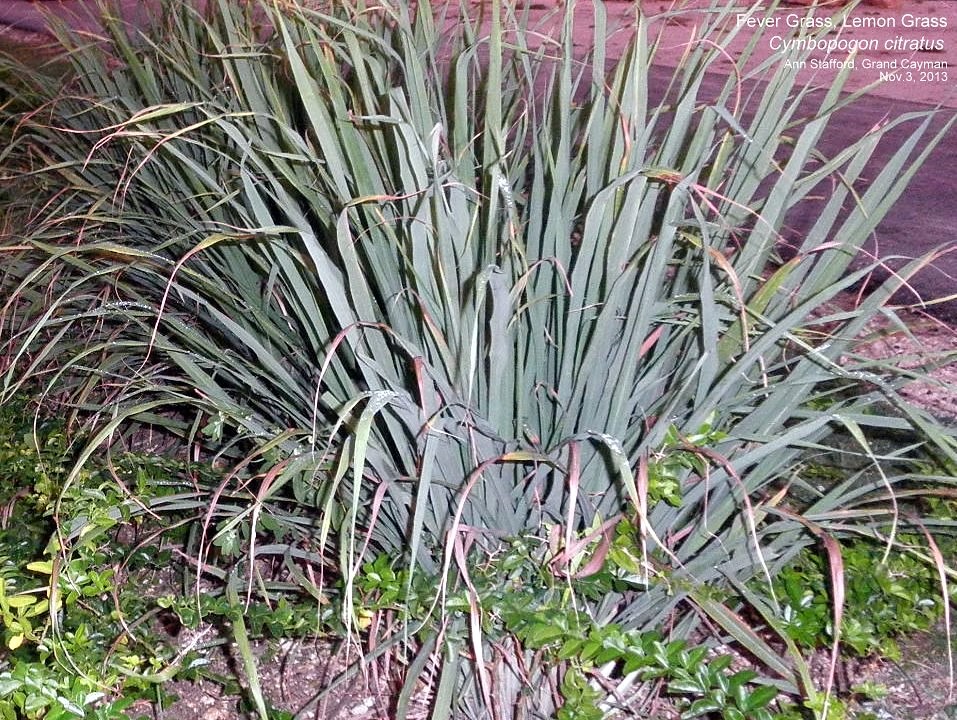
Licorice, John Crow Bead, Rosary Pea, Crab’s Eyes – Abrus precatorius
The roots of this pantropical, sometimes high-climbing vine, with pink flowers, contain glycerrhizin, which also occurs in commercial licorice. The seeds, scarlet with black spot, contain abrin and are extremely poisonous. The poison acts only through the blood stream, a small amount introduced into a wound could be fatal. However, it is destroyed by digestive juices and by boiling.
Kings GC 182a; CB 87.
Flora of the Cayman Islands, Proctor, 2012 p.366, Fig.132, Pl.27.
The seeds were used to make jewelry and as weights by jewel merchants,
2 seeds = 1 carat (1 carat weighs 1/24 oz.)
FLORA of the CAYMAN ISLANDS by George R. Proctor 2012 p.366. Fig.132, Pl.27.


Lime – Citrus X aurantifolia
Flora of the Cayman Islands, Proctor, 2012 p.493.


Moringa, Maronga, Horseradish Tree – Moringa oleifera
Kings GC 231
Flora of the Cayman Islands, Proctor, 2012 p.339
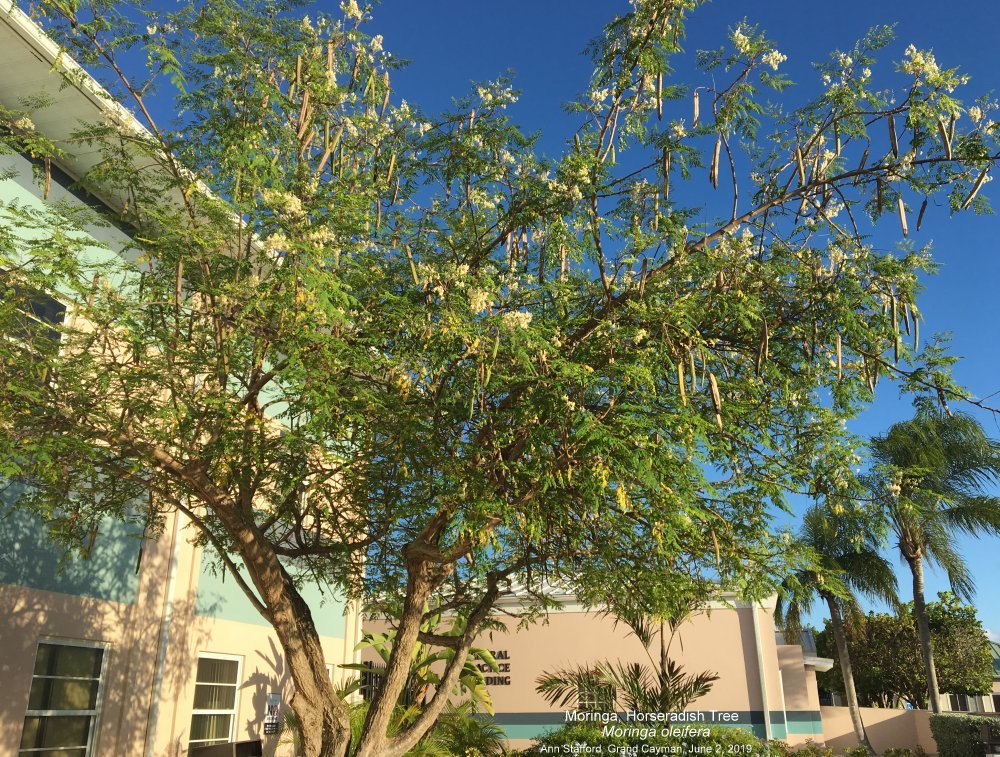


Overview Information
“Moringa is a plant that is native to the sub-Himalayan areas of India, Pakistan, Bangladesh, and Afghanistan. It is also grown in the tropics. The leaves, bark, flowers, fruit, seeds, and root are used to make medicine.
Moringa is used for “tired blood” (anemia); arthritis and other joint pain (rheumatism); asthma; cancer; constipation; diabetes; diarrhea; epilepsy; stomach pain; stomach and intestinal ulcers; intestinal spasms; headache; heart problems; high blood pressure; kidney stones; fluid retention; thyroid disorders; and bacterial, fungal, viral, and parasitic infections.
Moringa is also used to reduce swelling, increase sex drive (as an aphrodisiac), prevent pregnancy, boost the immune system, and increase breast milk production. Some people use it as a nutritional supplement or tonic.
Moringa is sometimes applied directly to the skin as a germ-killer or drying agent (astringent). It is also used topically for treating pockets of infection (abscesses), athlete’s foot, dandruff, gum disease (gingivitis), snakebites, warts, and wounds.
Oil from moringa seeds is used in foods, perfume, and hair care products, and as a machine lubricant.
Side Effects & Safety
Moringa is POSSIBLY SAFE when taken by mouth and used appropriately. The leaves, fruit, and seeds might be safe when eaten as food. However, it’s important to avoid eating the root and its extracts. These parts of the plant may contain a toxic substance that can cause paralysis and death. Moringa has been used safely in doses up to 6 grams daily for up to 3 weeks.”

Mulberry, Hog Apple, Noni – Morinda citrifolia
Kings LC 112.
Flora of the Cayman Islands, Proctor, 2012 p.628.


Naseberry, Neesberry, Sapodilla – Manilkara sapota
Tree with copius white latex. A tea was made from the leaves to treat the common cold.
Kings GC 347.
Flora of the Cayman Islands, Proctor, 2012 p.346.
Manilkara sapota – Useful Tropical Plants
Old Lady Coat Tail – Priva lappulacea
Kings GC 87, 153.
Flora of the Cayman Islands, Proctor, 2012 p.573.

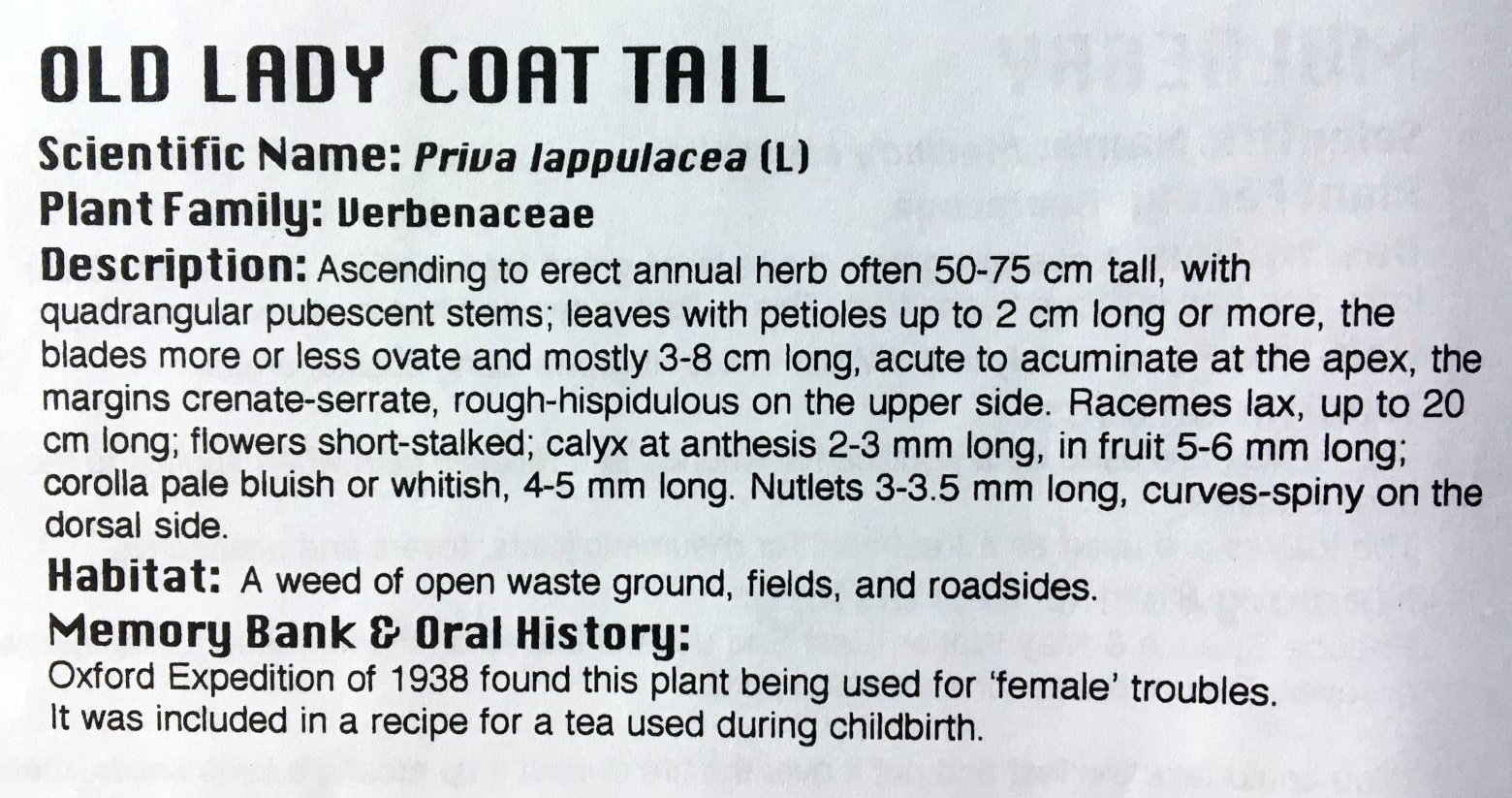
Pepper Cinnamon – Canella winterana
The bark, and silky leaves, when broken, are very pleasantly, distinctively, aromatic.
Critically Endangered, culturally significant, Cayman Islands native tree. The wood was used to make Catboat sculls (oars).
Native to Florida & the West Indies, south to Barbados
Kings LC 15; CB 48.
Flora of the Cayman Islands, Proctor, 2012 p.225. Fig.77, Pl.10


Useful Tropical Plants – Canella winterana
 Pepper Cinnamon – velvety, crimson berries are eaten by birds
Pepper Cinnamon – velvety, crimson berries are eaten by birds
Periwinkle, Burying-Ground Flower, Ramgoat Rose – Catharanthus roseus syn. Vinca rosea
An erect herb, originally described form Madagascar, now cultivated and escaping in nearly all warm countries.
Kings GC 51, 221, 222; CB 60.
Flora of the Cayman Islands, Proctor, 2012 p.519, Fig.191.



Pomegranate – Punica granatum
Not native to the Cayman Islands, it is sometimes planted horticulturally.
Kings GC 295.
Flora of the Cayman Islands, Proctor, 2012 p.411.


Providence Mint, Sage – Lippia alba
Kings CB 51.
Flora of the Cayman Islands, Proctor, 2012 p


Quacori / Quacou, Velvet Leaf – Cissampelos pareira
Dioecious, slender, twining, often high-climing, vine.
Leaves used in cases of fish poisoning (Oxford Expedition).
Velvety leaves used for shining glass lampshades (Boosie Arch).
Pantropical.
Kings GC 120.
Flora of the Cayman Islands, Proctor, 2012 p.235
(Note: Velvet-leaf is the Cayman common name for the shrub Melochia tomentosa.
Kings GC 423; LC 95; CB 15).


Cissampelos pareira – Useful Tropical Plants
Extract: “People take an infusion of the bitter rhizome, and sometimes of leaves and stems, to cure gastro-intestinal complaints such as diarrhoea, dysentery, ulcers, colic, intestinal worms and digestive complaints, and also urogenital problems such as menstrual problems, venereal diseases, infertility, uterine bleeding and threatening miscarriage. rhizome decoction or pounded leaves are also widely taken or externally applied as a febrifuge and stomachic, and is employed against cough, heart trouble, rheumatism, jaundice, snake bites and skin infections such as sores, boils, scabies and childhood eczema.
Juice from macerated leaves and stem is mixed with a little water and used as an anti-conjunctivitis or as a treatment for sore eyes. Leaves and stem are macerated in water an used as an anti-infective agent.”
Red Top, Hippa Cassini, (Scarlet Milkweed, Bloodflower) – Asclepias curassavica
Perennial herb, a wildflower found in pastures, said to be poisonous to livestock. Larval food plant of Milkweed butterflies, Danaus spp – Queens, Monarchs and Soldiers in Cayman.
Kings GC 152, 328.
Flora of the Cayman Islands, Proctor, 2012 p.527, Fig.195.

Asclepias curassavica – Bloodflower
Rosemary (Cayman and Jamaica) Croton linearis ; (Pineland Croton or Granny-Bush – US) Rosemary is a dioecious, pleasantly aromatic shrub, a multipurpose plant. The leaves were steeped to make tea for striction, as a tonic, boiled to make a tea for diabetes or smoked as tobacco to relieve asthma.
Kings GC 52, GC 392; LC 9; CB 49.
FLORA of the CAYMAN ISLANDS by George R. Proctor 2012 p.452. Fig.163. Pl.38. Note: The Cayman shrub, Rosemary, should not be confused with culinary woody, perennial herb, Rosemary (Rosmarinus officinalis), native to the Mediterranean region, or the variegated leaf landscaping shrub, Croton (Codiaeum variegatum).


 Culinary Mediterranean Rosemary – Rosmarinus officinalis, grown in Cayman and for sale in local supermarket.
Culinary Mediterranean Rosemary – Rosmarinus officinalis, grown in Cayman and for sale in local supermarket.
Sage, Black – Varronia bullata ssp. humilis, syn. Cordia globosa var. humilis
A sprawling, much branched shrub. The little, white flowers attract butterflies.
Kings GC 126a.
Flora of the Cayman Islands, Proctor, 2012 p.570.




Sage, White, Sweet Sage – Lantana camara syn. Lantana urticifolia
Kings GC 112, 314.
Flora of the Cayman Islands, Proctor, 2012 p



Scorn-the-Ground, Mistletoe – Phoradendron spp.
Small, parasitic shrubs on broad-leaved, woody plants. There are 3 species in the Cayman Islands: P. quadrangulare, P. trinervium, P. rubrum. Berries (yellow, red or orange) used for female ailments.
 Scorn-the-Ground – Phoradendron sp. on Cabbage Tree (Blolly) – Guapira discolor, in George Town, Grand Cayman.
Scorn-the-Ground – Phoradendron sp. on Cabbage Tree (Blolly) – Guapira discolor, in George Town, Grand Cayman.
Scorn-the-Ground, Mistletoe – Phoradendron quadrangulare
Kings GC 14, 150, 365, 388?; CB 91
Flora of the Cayman Islands, Proctor, 2012 p

Scorn-the-Ground, Mahogany Mistletoe – Phoradendron rubrum
Kings GC 165; LC 36, 43.
Flora of the Cayman Islands, Proctor, 2012 p


Scorpion Tail, Bastard Chelamella – Heliotropium angiospermum White flowers
Lewis 3856; Kings LC 41; CB 67
Flora of the Cayman Islands, Proctor, 2012 p


Scorpion Tail – Heliotropium indicum Annual, blue flowers
Kings GC 275.
Flora of the Cayman Islands, Proctor, 2012 p


Sea Bean – Canavalia rosea
Trailing or twining vine, leaves have 3 leaflets, flowers pink or rose, fading to bluish-purple. Flowers may be used as flavouring.
Pantropical, especially sandy areas near the sea.
Kings GC 68; LC 23; CB 13
Flora of the Cayman Islands, Proctor, 2012 p.372.

Canavalia rosea – Useful Tropical Plants
‘The root is diuretic. It contains a bitter and purgative principle. It is steeped in vinegar and used for gargles.
An infusion of the seed is used as a purgative..
The juice from the petioles is applied to puncture wounds from thorns or other sharp objects.
A decoction of the leaves is used in the treatment of rheumatism.
A paste of the leaves is used as a treatment for boils.’
The dried leaves have been used as an entheogen, a component to some ancient rituals.
The seeds are ingested or smoked with the dried leaves as a marijuana substitute.
There is an increasing in following for its use as a marijuana substitute.
The young seeds and pods are edible when cooked. The mature seeds may be toxic.
Sea Lavender – Tournefortia gnaphalodes syn. Argusia gnaphalodes
Kings GC2 63; LC 56; CB 102.
Flora of the Cayman Islands, Proctor, 2012 p


Sempervivie, Sempervirens, Sinkle Bible – see Aloe Vera, Alloways, Bitter Aloes – Aloe vera

Serasee, Cerasee – Momordica charantia
Climbing vine with tendrils, yellow flowers, fruit bright orange, seeds embedded in crimson pulp.
GC 223.
Flora of the Cayman Islands, Proctor, 2012 p.330



Soursop – Annona muricata
Flora of the Cayman Islands, Proctor, 2012 p.224.


Strong Back, Kidney Bush, Wild Coffee – Psychotria nervosa
Kings GC 316.
Flora of the Cayman Islands, Proctor, 2012 p



Tamarind – Tamarindus indica
Kings GC 81; CB 6.
Flora of the Cayman Islands, Proctor, 2012 p.393.



Tea Banker, Mint – Pectis caymanensis
Critically Endangered mat-like herb with a woody taproot and bright yellow flowers. The leaves have a distinctive, lovely lemony scent.
Kings GC 58
Flora of the Cayman Islands, Proctor, 2012 p.663, Fig.255, Pl.64.


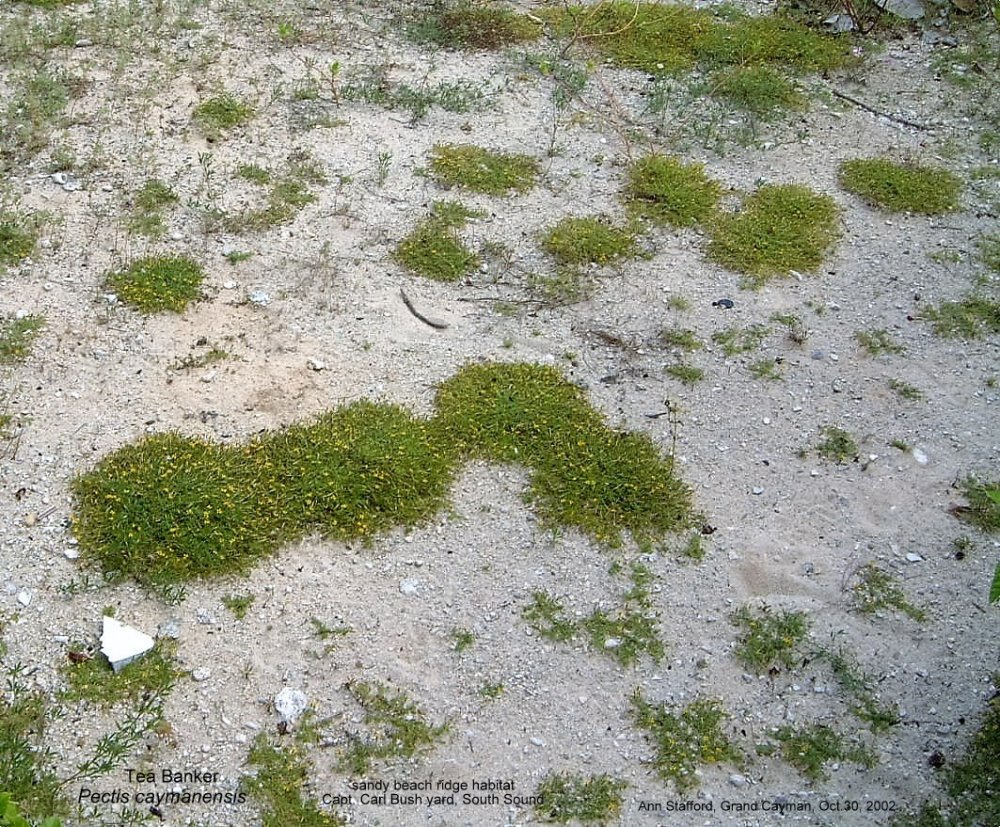
Cayman Islands Department of Environment FLICKER Bulletin No. 4, Dec. 2009, Tea Banker – Pectis caymanenisis pp.4-8:
Click here: Flicker_4 Dec 2009 Pectis
Tea Banker, Mint Pectis caymanensis (Urb.) Rydb. 1916 . Synonyms: Pectis cubensis of Hitchcock, 1893, not Griseb., 1866 Pectis cubensis var. caymanensis Urb.,1907 Family: ASTERACEAE (COMPOSITAE)
History Tea Banker was first recorded in the botanical literature of Grand Cayman in 1899 by Charles F. Millspaugh M.D. Department of Botany Curator, Field Columbian Museum, Chicago, Illinois. Millspaugh was a guest of Allison V. Armour, the Chicago meat-packing millionaire, on a West Indian cruise of the yacht ‘Utowana’; they visited the Cayman Islands during February, 1899. The chief set of Millspaugh’s specimens is in the herbarium of the Field Museum of Natural History in Chicago. Millspaugh published lists of his collection. On February 8, 1899, the ‘Utowana’ stopped at The Creek ,‘Cayman Brae’ (Cayman Brac) A Norther sprang up in the night, so they had to leave for a point further west, where they anchored. They did some more collecting and then sailed on to Little Cayman, but found no safe harbour. They reached Georgetown (sic), Grand Cayman after dark on Feb. 9. The Health Officer forbade them to land as their last port (Port Antonio, Jamaica) was reported to be infected with measles. They were, however, given permission to go ashore elsewhere as long as they kept away from any other person or dwelling. Because of the Norther, they anchored at ‘Spot Bay’ (Spotts). Tea Banker was originally called Pectis cubensis, it had been found in Cuba. Millspaugh found it on Grand Cayman on Feb.14, 1899: ‘Fine full masses of this species were found in the sand of the roadside at Spot Bay, Grand Cayman (1279), but not seen elsewhere on the island. It is called “Flat-weed,” and is used in infusion as a stomachic tonic.’ Critically Endangered Tea Banker occurs in two varieties P. caymanensis var. caymanensis, Cuba, Grand Cayman, Little Cayman and Cayman Brac, near endemic, and P. caymanensis var. robusta, Grand Cayman endemic. Both are Critically Endangered.
Plantae Utowanae 1898-1899
PLANTAE UTOWANAE
The Antillean Cruise of the Yacht Utowanae
Plants collected in Bermuda, Porto Rico, St. Thomas, Culebras, Santo Domingo, Jamaica, Cuba, The Caymans, Cozumel, Yucatan and the Alacran Shoals
by Charles Frederick Millspaugh MD, Curator of Botany, Field Museum, Chicago
Dec. 1898 to March 1899
Pectis p.109



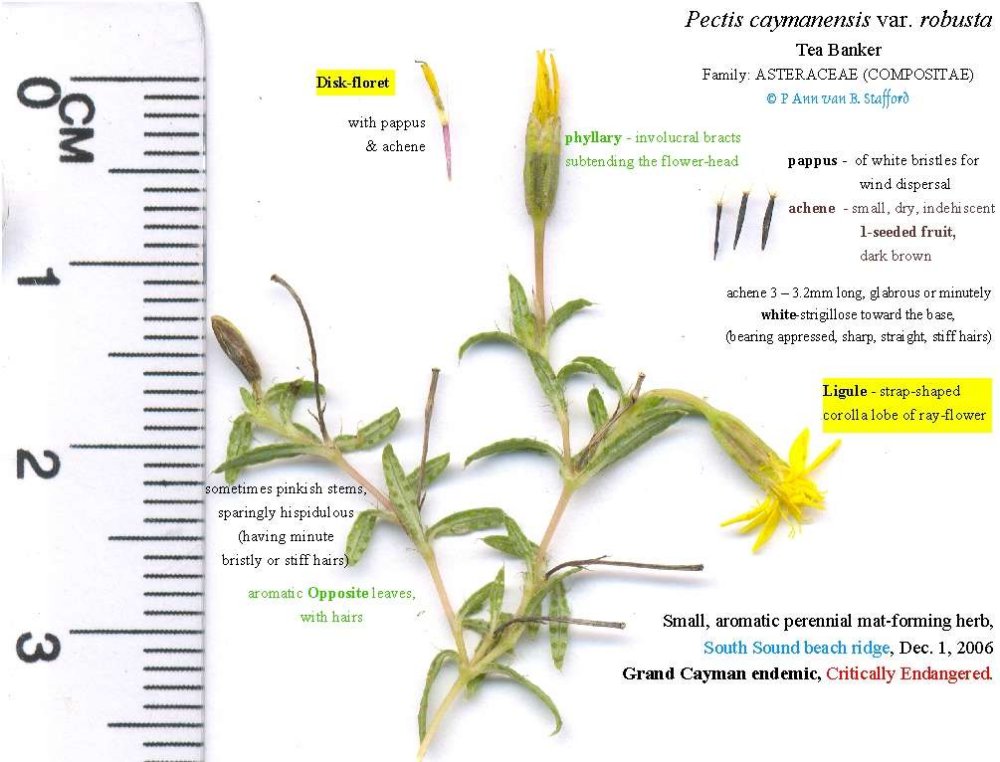
Thistle, Thorn Thistle, Poppy Thistle, Yellow Prickly Poppy – Argemone mexicana
Kings GC 129, 161.
Flora of the Cayman Islands, Proctor, 2012 p. 236



Thorn Apple, Jimsonweed – Datura stramonium
‘Grows as a weed everywhere. The leaves are dried in the sun and smoked as cigarettes by asthmatical subjects. Its medicinal properties have been so frequently demonstrated all over the world that it is unnecessary to enter into further description.’
Notes on the History of the Cayman Islands by George S.S. Hirst, published in 1910, reprinted in 1967, p.373.
George Stephenson Shirt Hirst was born in Sindh, India, in 1872 and died 1912, age 40. He was both Commissioner and Medical Officer of the Cayman Islands from 1907-1912. Hirst Road is named after him.’

Thorn Apple – “leaves dried and smoked by asthmatical subjects; known throughout the world.” An Adventurer’s Guide to the Cayman Islands, the Islands Time Forgot, by George I. Hudson 1967.
Tittie Molly; Coastal Spurge – Euphorbia mesembryanthemifolia syn.Chamaesyce mesembryanthemifolia
A subwoody herb or miniature shrub that grows on sandy seashores or in ironshore pockets. All parts of the plant are poisonous and can be fatal if eaten.
The white latex from a broken stem was used to remove warts.
Kings GC 23, 272; LC 93; CB 26.
Flora of the Cayman Islands, Proctor, 2012 p.468.
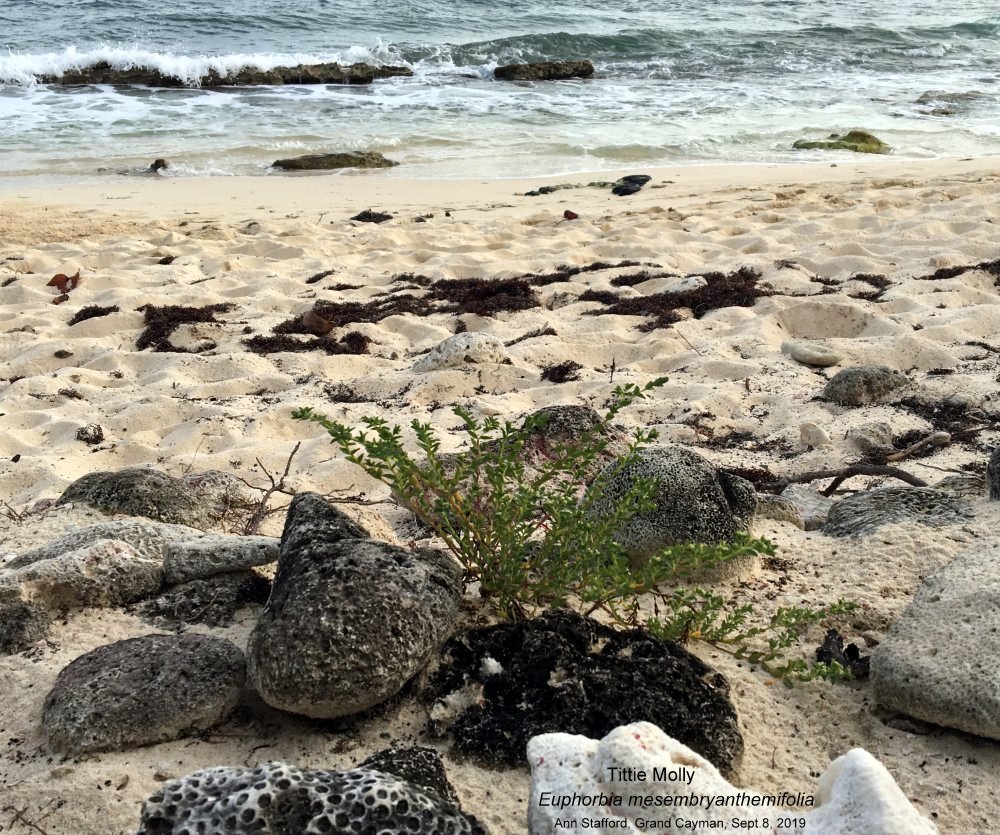


Tobacco Berry, Wild Tobacco, Snake Berry – Crossopetalum rhacoma


Vervine, Worry Vine, (Blue Bush); (Porter Weed) – Stachytarpheta jamaicensis
A tea made from it is said to foam like porter.
Leaves OPPOSITE or whorled, an annual weed of open waste places & dry sandy thickets & clearings. Larval food plant of Caribbean Buckeye butterfly – Junonia genoveva & nectar flower for several butterflies.
Kings GC 121 (Water Vine), GC 290, GC 291.
Flora of the Cayman Islands, Proctor, 2012 p.573, Fig. 213, Pl.55.



Vitex, Chaste Tree, Monk’s Pepper, Lilac Butterfly Bush – Vitex agnus-castus
native to Mediterranean Europe and Central Asia, grown horticulturally in Cayman.
The peppercorn-sized fruits and other parts of the plant are used as a herbal remedy to treat a variety of ailments.The flowers attract butterflies.

 Vitex (Monk’s Pepper) peppercorn-like fruits are sold in Cayman.
Vitex (Monk’s Pepper) peppercorn-like fruits are sold in Cayman.
‘The Vitex agnus-castus fruit, also known as chasteberry or monk’s pepper, is about the size of a peppercorn. It’s produced by the chaste tree, which acquired its name because its fruit was likely used to decrease men’s libido during the Middle Ages.’
‘Overview – Uses – Side effects – Interactions – Dosing
Vitex agnus-castus tree is a shrub that is native to the Mediterranean and Central Asia. The shrub has long, finger-shaped leaves, blue-violet flowers, and dark purple berries. The fruit and seed are used to make medicine.’
 Buckeye butterflies nectaring on Vitex, Lilac Butterfly Bush, after Hurricane Ivan, 2004.
Buckeye butterflies nectaring on Vitex, Lilac Butterfly Bush, after Hurricane Ivan, 2004.
Water Hyssop, Herb of Grace – Bacopa monnieri
Leaves opposite, fleshy; stems creeping, rooting at the nodes, much branched and forming mats. Flowers pale blue, mauve or white. It grows in wet pastures, damp lawns and beside fresh or brackish pools, is widespread in both New and Old World Tropics and has many different common names around the world.
Flora of the Cayman Islands, Proctor, 2012 p.601

Bacopa monnieri hasn’t been recorded as a medicinal plant in Cayman.
It is a known larval food plant of the White Peacock butterfly (Anartia jatrophae), but in the Cayman Islands this butterfly’s larval food plant is unknown.
Bacopa monnieri is used in Ayurvedic traditional medicine to improve memory and to treat various ailments.
Water Vine – (see Vervine)
Leaves used to induce vomiting.
Kings GC 121.
Wiry Vine –
Leaves crushed and juice taken for Malaria.
Kings GC 7.
Wormwood, Running Wormwood, Geranium – Ambrosia hispida
Kings GC 260, 319; LC 25, 26.
Flora of the Cayman Islands, Proctor, 2012 p.647.




Yellow Root, Rhubarb Root – Morinda royoc
Kings LC 112.
Flora of the Cayman Islands, Proctor, 2012 p.628.




Harmful Plants in Cayman
LOOK, DON”T TOUCH




Licorice, John Crow Bead, Rosary Pea, Crab’s Eyes – Abrus precatorius

 Lorna McCubbin in Cousin Cora’s Cottage, Boggy Sand Road, West Bay. She compiled HEALING PLANTS of the CAYMAN ISLANDS, March 15, 1995.
Lorna McCubbin in Cousin Cora’s Cottage, Boggy Sand Road, West Bay. She compiled HEALING PLANTS of the CAYMAN ISLANDS, March 15, 1995.

George R. Proctor


REFERENCES
Adams, C.D., Flowering Plants of Jamaica, (1972), University of the West Indies
Adams, C.D., The Blue Mahoe and Other Bush, (1971), McGaw-Hill
Burton, Frederic J., Threatened Plants of the Cayman Islands The Red List, (2008), Kew
Carrington, Sean, Wild Plants of Barbados (1993), McMillan Caribbean
Cayman Islands Herbarium at the National Trust for the Cayman Islands
Cayman Islands National Archive
Hirst, George S.S., Notes on the History of the Cayman Islands, (1910)
Honychurch, Penelope N., Caribbean Wild Plants and their Uses, (1986), Macmillan Education Ltd
Kings, W., Report on the Botanical Collections, Oxford University Biological Expedition to the Cayman Islands (1938)
Levy, Jewel, Old-time bush medicine a treasured tradition, 2016, Cayman Compass
McCubbin, Lorna, Healing Plants of the Cayman Islands, (1993)
Proctor, George R., Flora of the Cayman Islands, (2012), Kew
Taylor, Walter Kingsley, Florida Wildflowersin Their Natural Communities (1998), University Press of Florida
Tropical Plants Database, Ken Fern. tropical.theferns.info
by P. Ann van B. Stafford, August 16, 2019
Smith Barcadere – Smith Cove, Grand Cayman
by Ann Stafford
Historic area
People came from West Bay by boat to Smith Barcadere. They cut ‘tops’, the new, unopened leaves of the Silver Thatch Palms that were plentiful on the large estate (60 acres) of James Samuel Webster.




Silver Thatch Palm – Coccothinax proctorii, Cayman Islands endemic tree, Cayman Islands National Tree, Endangered, culturally significant.
 Silver Thatch tops – the unopened fronds.
Silver Thatch tops – the unopened fronds.
Tops were cut on the old moon, after the full moon.
Smith was shipwrecked on the Spotts reef. He was the carpenter on the ship that brought Rex Crighton’s ancestor, Alexander McKeith Crighton (1822-1892), to Grand Cayman in the 1850s.
Smith built a sea-going vessel from the salvaged timbers of the ship that wrecked and timber from trees that grew in the heavily-wooded Smith Barcadere area. It is not very far by sea from Spotts to Smith Barcadere.
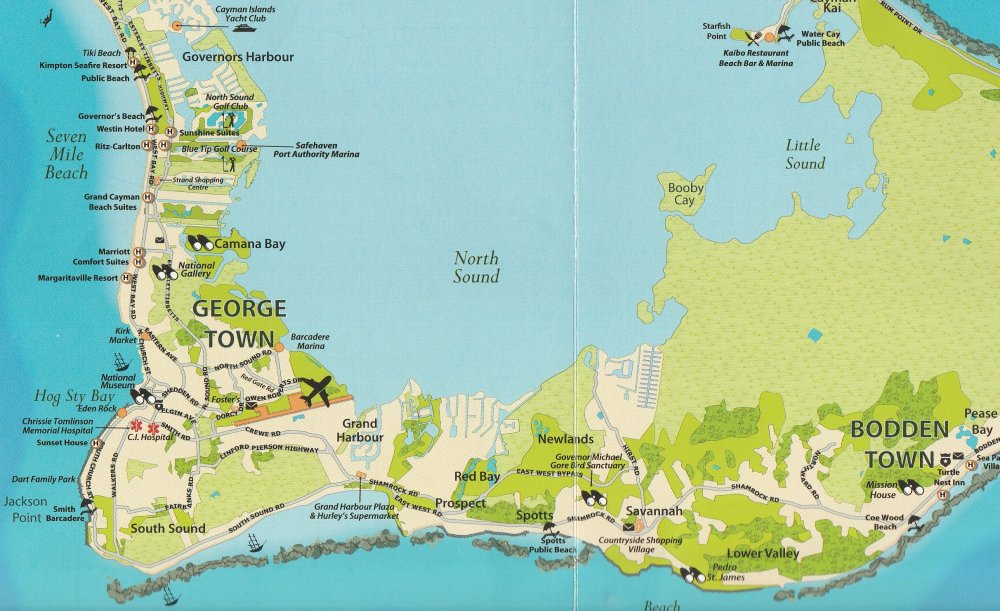
The South Sound reef ends at Sand Cay. Smith Barcadere, a sandy cove where there is a break in the ironshore, is just to the north of it, with water of sufficient depth to launch a ship.
Alexander McKeith Crighton (1822-1982) was born in Glasgow, Scotland.
At the age of 19 (1841) he became chief mate, sailing on clipper ships from England to Australia. He was later transferred to the tea trade and promoted to Captain. He came to Grand Cayman (1850s) after being shipwrecked off the coast of Cuba.
Alexander Crighton was a valuable immigrant because he had a thorough knowledge of navigation, which he was pleased to impart to others. He trained and taught many Caymanian seamen and opened the first navigation school in the islands.
Many men from his school became well-known captains here, and some emigrated to the United States and became captains there.
Alexander Crighton was also a merchant and one of the first surveyors in the Cayman Islands. He married Ann Brett Coe (1832-1899), and together they had six children. They lived at Crighton Square at Spotts.
Wall of Honour book p.24
1868 James Samuel Webster, J.P. was born in Bodden Town, the son of William Bodden Webster, who became Custos (Chief Magistrate) in 1879. James married Antoinette Arabella Eden. They had five sons and one daughter. James, a successful businessman, moved his family to George Town in about 1900.
1891 Jamaica Exhibition
“gave Caymanians an opportunity of showing something of their way of life and their trade to their fellows in the Caribbean……
The exhibits included dyewoods*, mahogany and ironwood, that was as durable as metal, and the beautifully grained manchioneal. There was bulrush starch, a product peculiar to the Caymans, and a full range of baskets, hats, lines and ropes made from the dried leaves of the thatch palm. Though the turtle was pre-eminent in the Cayman section of the exhibition, Edmund Parsons, the custos, hoped that a trade could be established in sponges and sea shells.”
* Fustic (Maclura tinctoria) native, and Logwood (Haematoxylum campechianum) introduced from Central America, naturalized in Cayman.
A History of the Cayman Islands by Neville Williams, 1970
Jamaica International Exhibition 1891

 The Webster House, built in 1894, was the temporary National Trust for the Cayman Islands Visitor Centre, following Hurricane Ivan in September 2004, when the Eastern Avenue / Courts Road Visitor Centre was badly damaged.
The Webster House, built in 1894, was the temporary National Trust for the Cayman Islands Visitor Centre, following Hurricane Ivan in September 2004, when the Eastern Avenue / Courts Road Visitor Centre was badly damaged.
 Webster House, 359 South Church St.
Webster House, 359 South Church St.
Life and Adventure in the West Indies
by Vaquero, 1914
Vaquero was the pseudonym of Dr Richard Keatinge, Cayman Islands Government Medical Officer for most of 1906.
He had a camera.
Chapters II and III In the Cayman Islands
1906 Photographs by Vaquero
 Doctor Richard Keatinge’s house in George Town, his servant and pony.
Doctor Richard Keatinge’s house in George Town, his servant and pony.
 Dr Richard Keatinge, GMO, swam at a small, sandy cove called Smith’s Barcadere, just out of sight of the road, about a mile and a half from his house in George Town.
Dr Richard Keatinge, GMO, swam at a small, sandy cove called Smith’s Barcadere, just out of sight of the road, about a mile and a half from his house in George Town.
 Cottages and people at South Sound, 3 miles from George Town
Cottages and people at South Sound, 3 miles from George Town
 Landing place at George Town, Hog Stye Bay. The large white building is the Court House.
Landing place at George Town, Hog Stye Bay. The large white building is the Court House.
 The old Court House is now the Cayman Islands National Museum. The J. S. Webster building was on the right. It later became the Viking Gallery and then Bayshore Mall.
The old Court House is now the Cayman Islands National Museum. The J. S. Webster building was on the right. It later became the Viking Gallery and then Bayshore Mall.
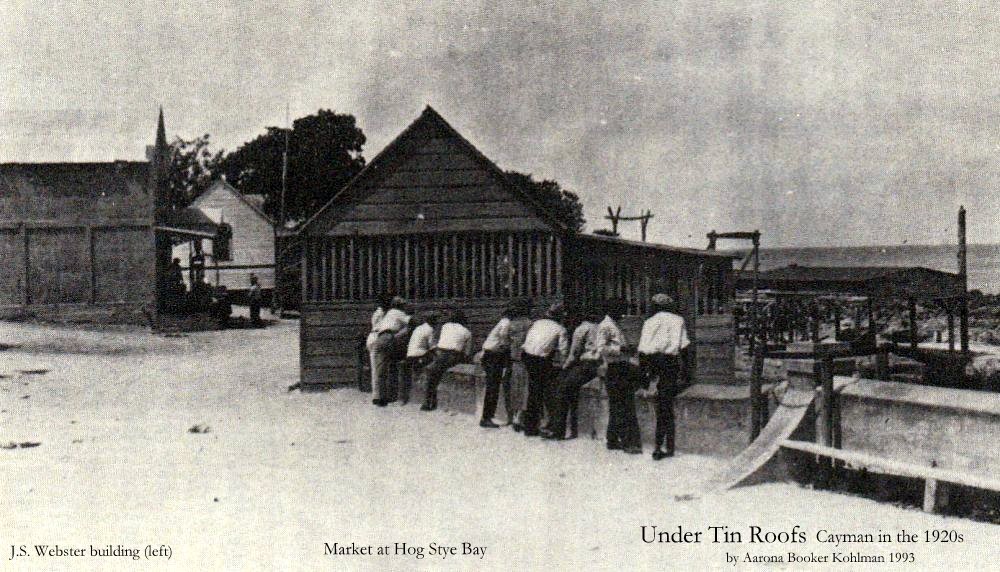 Webster building, left, (later the Viking Gallery, then Bayshore Mall), Goring Avenue, and the Market at Hog Stye Bay, c. 1926. Photo: N.L. Booker, in the book by his daughter, Aarona Booker Kohlman 1993: Under Tin Roofs – Cayman in the 1920s.
Webster building, left, (later the Viking Gallery, then Bayshore Mall), Goring Avenue, and the Market at Hog Stye Bay, c. 1926. Photo: N.L. Booker, in the book by his daughter, Aarona Booker Kohlman 1993: Under Tin Roofs – Cayman in the 1920s.
1916 J. S. Webster moved with his family to Kingston, Jamaica.
An incomplete record and history of the Webster Shipping Line, founded by J. S. Webster, great-grandfather of Alex Webster, in Kingston, Jamaica.

Capt. Charles Christopher Bush (1864-1942) was in partnership with J.S. Webster and in charge of what is known today as Smith Barcadere and Websters Estate.
 People came by the boatload from West Bay. They cut Silver Thatch ‘tops’ (the new unopened fronds) and collected Mangoes. They used to back them down to Smith Barcadere and return to West Bay by boat. They had no money, they paid in rope.
People came by the boatload from West Bay. They cut Silver Thatch ‘tops’ (the new unopened fronds) and collected Mangoes. They used to back them down to Smith Barcadere and return to West Bay by boat. They had no money, they paid in rope.
Rope-makers were paid 25 cents for 100 fathoms of rope (600 feet)
Capt. Malcolm CARL Bush (March 9, 1903 – July 26, 2004), son of Capt. Charles Christopher Bush (1864-1942), Cayman Islands National Archive, Oral History.
 Capt. Carl Bush’s house on South Church St (next to Sand Cay Apartments). Tea Banker – Pectis caymanensis, Critically Endangered little mat-like herb with a lovely, lemony smell, grew plentifully in the sand. The house, built c. 1931, has since been demolished and Tea Banker has disappeareared.
Capt. Carl Bush’s house on South Church St (next to Sand Cay Apartments). Tea Banker – Pectis caymanensis, Critically Endangered little mat-like herb with a lovely, lemony smell, grew plentifully in the sand. The house, built c. 1931, has since been demolished and Tea Banker has disappeareared.
 Silver Thatch Palm – Coccothrinax proctorii, Cayman endemic, Cayman Islands National Tree, and Mango tree – Mangifera indica, naturalized in Cayman, grows wild, (first introduced into Jamaica in 1782).
Silver Thatch Palm – Coccothrinax proctorii, Cayman endemic, Cayman Islands National Tree, and Mango tree – Mangifera indica, naturalized in Cayman, grows wild, (first introduced into Jamaica in 1782).
 Catboats: unloading cargo. Cayman Islands $1.60 stamp, Aug. 31, 2011.
Catboats: unloading cargo. Cayman Islands $1.60 stamp, Aug. 31, 2011.

Thatch rope was made in 3 sizes:
Head-rope – small
Big rope – medium
Hauser – large
It was shipped to Jamaica.

West Bay rope-making lives on
 West Bayer Billy Banker: b.1935
West Bayer Billy Banker: b.1935
Extract:
“There were a few silver thatch palms in West Bay, [but] all that land now is subdivisions, mostly,” he said. “But you really needed a lot of those tops to make rope, which were collected on the full moon, or a few days after.
You would need a lot of land to have enough trees, so many families would take their catboats down to South Sound, or Newlands and other places and cut the tops there, where there were a lot of silver thatch palms growing.”
 The cog holds the three strands together while the rope is twisted.
The cog holds the three strands together while the rope is twisted.
“We would take the rope to the store, where we would exchange it for household supplies. We never sold it for money. The stores would sell the rope on.”
Jamaica needed a lot of rope in 1945 after its fishing fleet was devastated by a hurricane in 1944, making for a huge year for Cayman rope exports which totaled 1.5 million fathoms.
Silver thatch rope, said Mr. Banker, was very good for saltwater due to its resistance to rot, but not well suited for freshwater. The ropes were used for fishing boats and sailing boats, mostly for anchors, sails and tying up.
Eventually, synthetic rope took the place of rope made of natural materials, bringing an end to Cayman’s little domestic industry.
Mr. Banker says he cannot remember any rope being made by the time he left Cayman at 19, in 1954, to go to sea as a messman.
DID YOU KNOW THAT? 58 Tidbits of Cayman’s History….
By Captain Paul Hurlston
The first sea going vessel ever built in Grand Cayman was built at Smith’s Barcadere by a carpenter who was shipwrecked on Spotts Reef. He was the carpenter on the vessel that brought Rex Crighton’s ancestors to Cayman. Tidbit 36
Dolly Well There was a well in South Sound called “Dolly Well” located in Webster’s Estate somewhere in the back of Lemuel Hurlston’s old house on Antoinette Avenue. It was round and not very deep and where all South Sounders got their water. It has since been filled in. Tidbit 13
 South Sounders got their water from the Dolly Well, across the road from Smith Barcadere.
South Sounders got their water from the Dolly Well, across the road from Smith Barcadere.
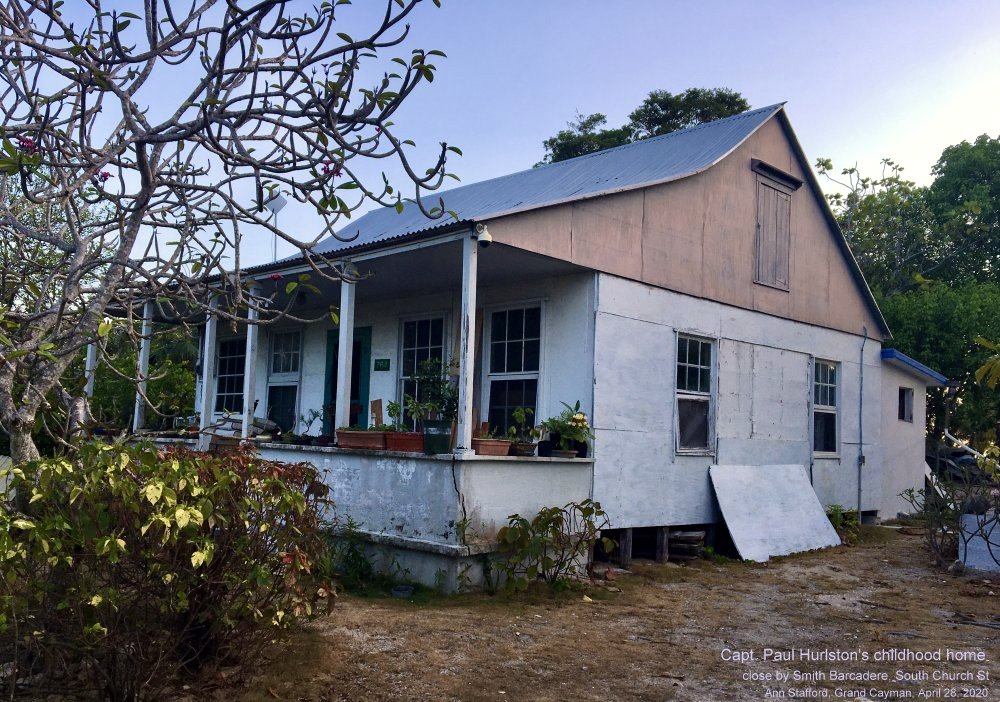 Capt. Paul Hurlston (born 1931) grew up in his family home, close by Smith Barcadere. The house, built c.1922, still stands (764 South Church St).
Capt. Paul Hurlston (born 1931) grew up in his family home, close by Smith Barcadere. The house, built c.1922, still stands (764 South Church St).
 Looking towards Hurlston family home, where Capt. Paul Hurlston grew up.
Looking towards Hurlston family home, where Capt. Paul Hurlston grew up.

Rough seas
 March 3, 2010
March 3, 2010
 Dec. 4, 2010
Dec. 4, 2010
 Jan. 23, 2016
Jan. 23, 2016
 Jan. 23, 2016
Jan. 23, 2016
 Feb. 7, 2016 Smith Barcadere ironshore
Feb. 7, 2016 Smith Barcadere ironshore
Weddings
 Wedding at Smith Barcadere, Oct. 20, 2011
Wedding at Smith Barcadere, Oct. 20, 2011
Plants
Rare, Critically Endangered Trichilia trees (Trichilia havanensis)
Trichilia – an attractive shrub or small tree – is almost extinct in Grand Cayman. A few survive in the George Town area, including Smith Barcadere, and Walkers Road where property owners have preserved them.

A beautiful stand of these trees grew by Burger King on Walkers Road. They were cut down and replaced with common, non-native landscaping plants. They also grew in the airport vicinity, but they too, were cut down.
They haven’t been recorded on Little Cayman or Cayman Brac. Trichilia havanensis is native to Cuba, Jamaica and continental tropical America.

Trichila very rarely flowers and fruits, so propagation by seed hardly happens.

Their main means of reproduction is by root runners, such as at Smith Barcadere, where it is hoped that they will be preserved in their natural habitat for future generations.

Trichilia trees have a distinctive bark.
Trichilia havanensis is protected under Schedule 1 Part 2 of the Cayman Islands National Conservation Law.
 Trichilia trees, Critically Endangered, original growth on Smith Barcadere beach ridge.
Trichilia trees, Critically Endangered, original growth on Smith Barcadere beach ridge.
National-Trust-Position-on-Smith-Cove-development
October 5, 2016 National Trust for the Cayman Islands Statement on the proposed development of the north side of Smith Barcadere (also known as Smith Cove)
Extract:
There is a rare plant on the Smith Cove site (Trichilia havanensis), almost extinct on Grand Cayman and considered critically endangered, growing on the wooded section of the lot that is slated for development. This plant is protected under Schedule 1 Part 2 of the National Conservation Law. It is common elsewhere in the Caribbean and was probably once quite common in the area south of George Town between Walkers Road and South Church.
 Trichilia trees (original growth), conserved, form a hedge for a private property on Walkers Road.
Trichilia trees (original growth), conserved, form a hedge for a private property on Walkers Road.
Silver Thatch Palm – Coccothrinax proctorii Cayman Islands National Tree

Cayman Islands endemic, Endangered
Silver Thatch: Cayman’s Verdant Trees So Fair
Only the newest unopened leaves (“tops”) could be used for making rope.
Extract: Thatching was not always restricted to roofs. Before the days of electricity, kitchens and cookrooms were often separate constructions, to reduce the risk of fire. Some had thatched walls, which created a cool cooking area. With the availability of corrugated zinc roofing in the 1920’s, thatched roofs and thatching skills have now become rare.
Silver Thatch Palm leaves were also used to weave hats, baskets and fans. Shoes known as “wompers” were made with a flat leather sole and held on the foot by straps -like a thong – of thatch rope. Nowadays, hats and baskets are in demand in tourist and craft shops. Many of them are still made by those who were taught their skills over fifty years ago!
Items made from Silver Thatch Palm lasted far longer than similar products made using other materials available at the time. The tree’s real value, however, lies in the ability of its dried leaf to resist the effects of salt water.

This proved particularly important in the rope-making industry. Cayman had relatively few natural resources that could generate income, but the thatch rope was highly prized in Cuba and Jamaica for use in the shipping, fishing and sugar industries. While the men were away at sea, or busy with their farms, the women and children would make rope.

Sea Grape – Coccoloba uvifera (Critically Endangered) and Broadleaf – Cordia sebestena var. caymanensis (Cayman Islands endemic variety) (Vulnerable) at Smith Barcadere. Both are culturally significant native trees.
 Broadleaf – Cordia sebestena var. caymanensis. Cayman Islands endemic shrub or small tree, with rough, Alternate leaves that were traditionally used to polish turtle shells. Versatile Broadleaf grows in varied habitats.
Broadleaf – Cordia sebestena var. caymanensis. Cayman Islands endemic shrub or small tree, with rough, Alternate leaves that were traditionally used to polish turtle shells. Versatile Broadleaf grows in varied habitats.
Cordia sebestena called Geiger Tree (US) or Red Cordia, is widely distributed in coastal thickets in Florida, the West Indies and the eastern coasts of continental tropical America. It is used in landscaping.
Cordia sebestena – Geiger Tree, Florida
 Sea Grape – Coccoloba uvifera (Critically Endangered) and Popnut – Thespesia populnea (Endangered) native trees, both culturally significant.
Sea Grape – Coccoloba uvifera (Critically Endangered) and Popnut – Thespesia populnea (Endangered) native trees, both culturally significant.
 Sea Grape – the large round leaves were used as plates.
Sea Grape – the large round leaves were used as plates.
 Popnut trees were used in boat-building. The trunks and branches often grew already curved.
Popnut trees were used in boat-building. The trunks and branches often grew already curved.
 Popnut / Plopnut, (Seaside Mahoe in Jamaica, Portia Tree in USA) – Thespesia populnea, belongs to the same plant family as Hibiscus. Popnut, an extremely salt-tolerant, fast-growing, pan-tropical tree, has heart-shaped leaves and pretty pale yellow flowers with maroon centres. The whole flower turns maroon later in the day before dying. Popnut was used in Catboat construction in the Cayman Islands, where it is Endangered.
Popnut / Plopnut, (Seaside Mahoe in Jamaica, Portia Tree in USA) – Thespesia populnea, belongs to the same plant family as Hibiscus. Popnut, an extremely salt-tolerant, fast-growing, pan-tropical tree, has heart-shaped leaves and pretty pale yellow flowers with maroon centres. The whole flower turns maroon later in the day before dying. Popnut was used in Catboat construction in the Cayman Islands, where it is Endangered.

Cat Claw – Volkameria aculeata synonym Clerodendron aculeatum, a shrub with showy little white flowers.
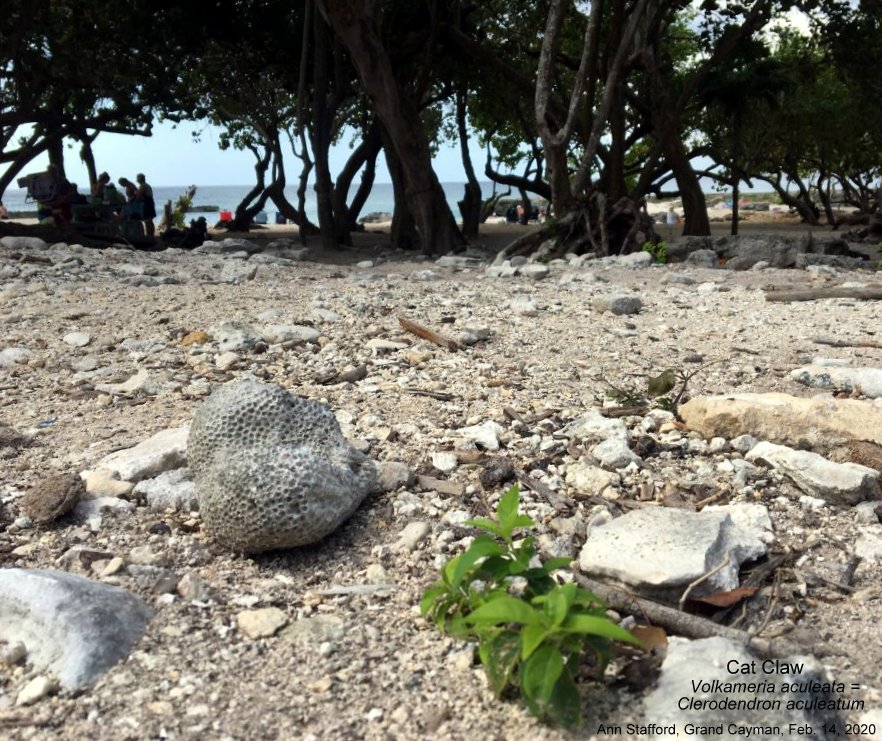 Cat Claw was cut down, but has started growing back, Feb. 14, 2020.
Cat Claw was cut down, but has started growing back, Feb. 14, 2020.
Ironshore plants grow in a harsh, rocky habitat
 Stunted Buttonwood – Conocarpus erectus and Bay Candlewood, Seaside Oxeye – Borrichia arborescens
Stunted Buttonwood – Conocarpus erectus and Bay Candlewood, Seaside Oxeye – Borrichia arborescens

 Juniper, Sandfly Bush – Rhachicallis americana, a little shrub with bright yellow flowers, and Sea Grape – Coccolba uvifera, and Buttonwood – Conocarpus erectus, both stunted, due to the harsh environment of the ironshore, with waves crashing over them when the sea is rough.
Juniper, Sandfly Bush – Rhachicallis americana, a little shrub with bright yellow flowers, and Sea Grape – Coccolba uvifera, and Buttonwood – Conocarpus erectus, both stunted, due to the harsh environment of the ironshore, with waves crashing over them when the sea is rough.
Creatures
 St. Andrew’s Cotton Stainer (Love-bugs) – Dysdercus andreae, on Popnut / Plopnut, (Portia Tree, Seaside Mahoe) – Thespesia populnea.
St. Andrew’s Cotton Stainer (Love-bugs) – Dysdercus andreae, on Popnut / Plopnut, (Portia Tree, Seaside Mahoe) – Thespesia populnea.
Saint Andrew’s Cotton Stainer: Damaging Pest or Colorful Curiosity?
by William M. Ciesla
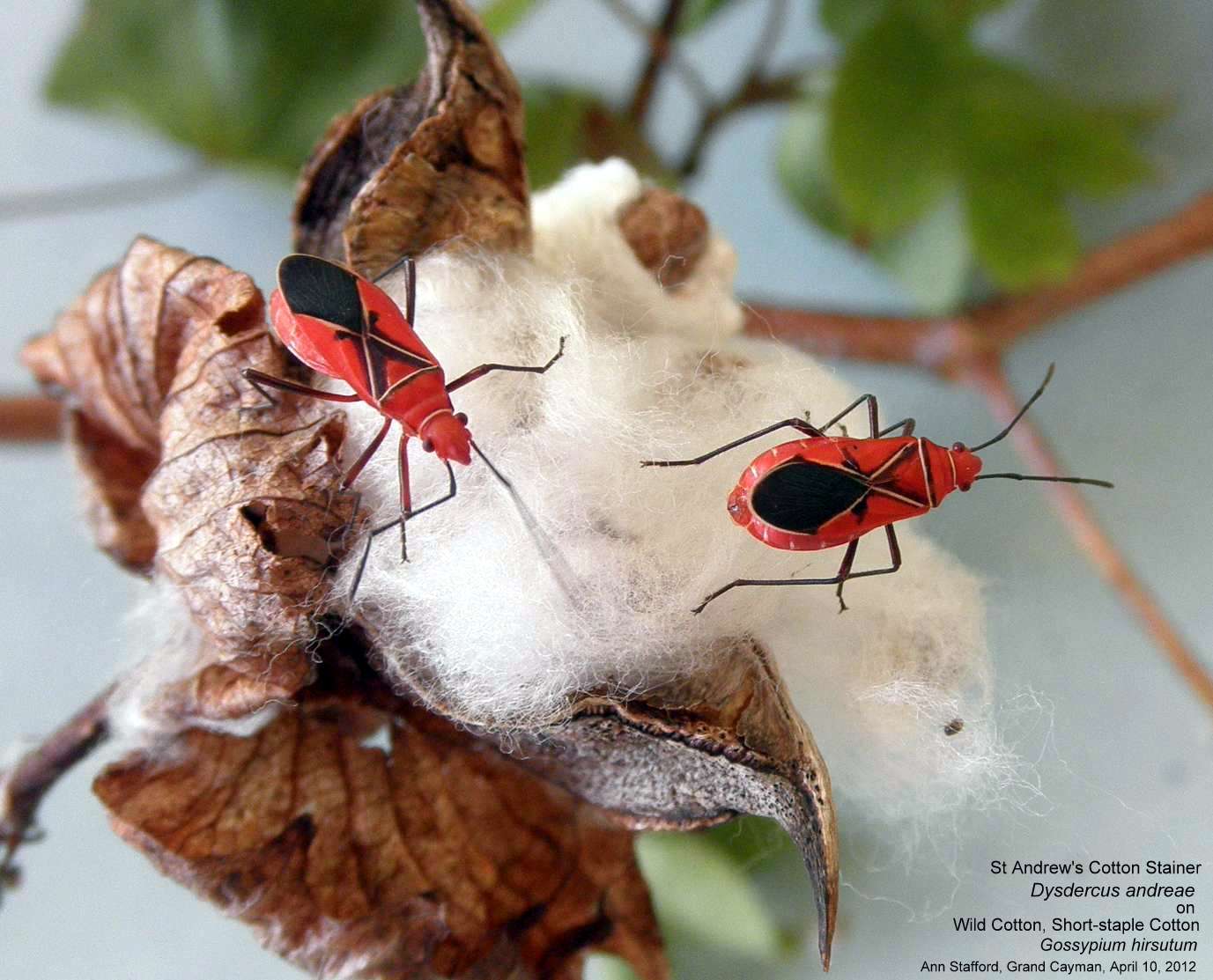 St. Andrew’s Cotton Stainer – Dysdercus andreae on Wild Cotton, Short-staple Cotton – Gossypium hirsutum (which doesn’t grow at Smith Barcadere).
St. Andrew’s Cotton Stainer – Dysdercus andreae on Wild Cotton, Short-staple Cotton – Gossypium hirsutum (which doesn’t grow at Smith Barcadere).
From 1780s cotton was grow in Grand Cayman. 1802 Thirty tons of cotton per year were exported from Cayman, but cotton had peaked by 1810.
Memorial

James Samuel and Antoinette Arabella (née Eden) Webster
(1868-1954) (1866-1939)
James Samuel Webster was the great-grandson of John Webster who was born in Yorkshire, England, in 1777. He arrived in Grand Cayman (Bodden Town) in 1803 and married Elizabeth Bodden, daughter of William ‘Governor’ Bodden II. John died on Jan. 18, 1805, age 28. John and Elizabeth had two sons, William Smith Webster and John Michael Webster.

Inscription: In Memory of James Samuel Webster and his wife Antoinette Arabella (née Eden). This bathing cove, formerly called Smith’s Barcadier, is dedicated by their son William Burnett Webster and their grandsons, James George Eden McMurray and David McMurray to the people of Georgetown and the stranger in their midst.
James Samuel Webster (1868-1954)
Antoinette Arabella Eden Webster (1866-1939)

William Burnett Webster (1909-1992)
(James George Eden McMurray) William George Eden McMurray (1939-1999)
David McMurray aka Jerry Webster (1941-1987)
[William Burnett Webster, George McMurray and Jerry Webster were the Registered Owners of the Webster Estates private roads, Antoinette Avenue and Websters Drive.]

Webster Memorial Sea Grape and Popnut trees in the background.


Smith’s Cove Memorials
South Sound photos
Grand Cayman, Cayman Islands.
South Sound began at Old Crewe Road and ended by Capt. Denham Thompson property, now Pure Art.
Stepwells and old stonewalls, turtle nests and shipwrecks, mangroves and dyke roads, Sand Cay and Pull-and-Be-Damned Point, Grand Old House and Miss Lassie’s House, Smith Barcadere (aka The Cove), the J. S. Webster Estate, Silver Thatch and rope-making, English Point and Portuguese Point, Rugby, Tennis and Squash Clubs, butterflies and bugs, Whistling Ducks and Hickatees, herons and egrets, schools and churches, Valentine’s Mile and Fun Runs …
South Sound area
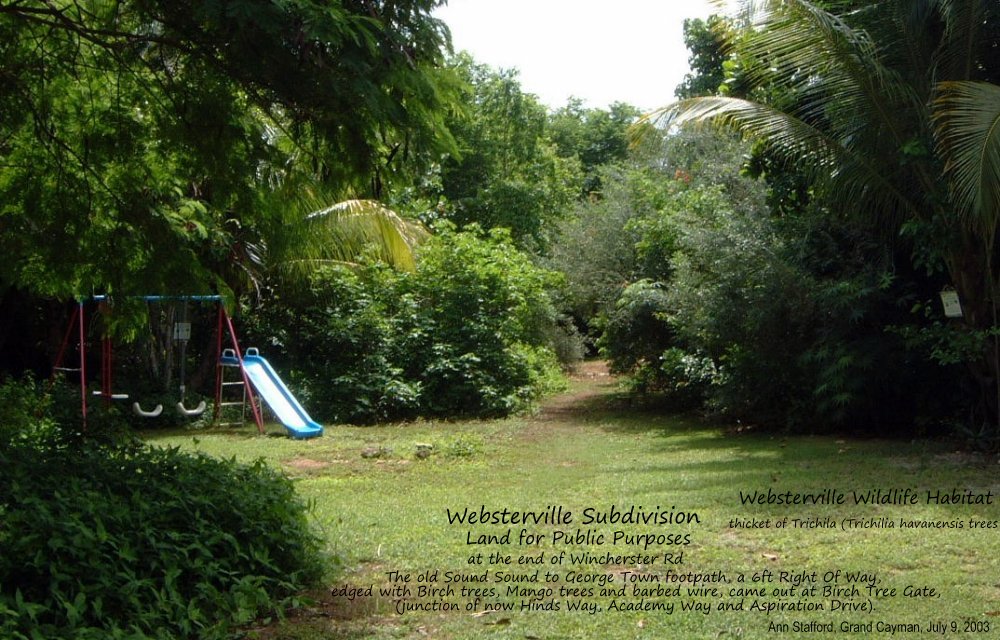
The old South Sound to George Town footpath (a 6ft. Right Of Way that no longer exists), was edged with native Birch trees (Bursera simaruba), naturalized Mango trees and barbed wire, before Walkers Road was built.

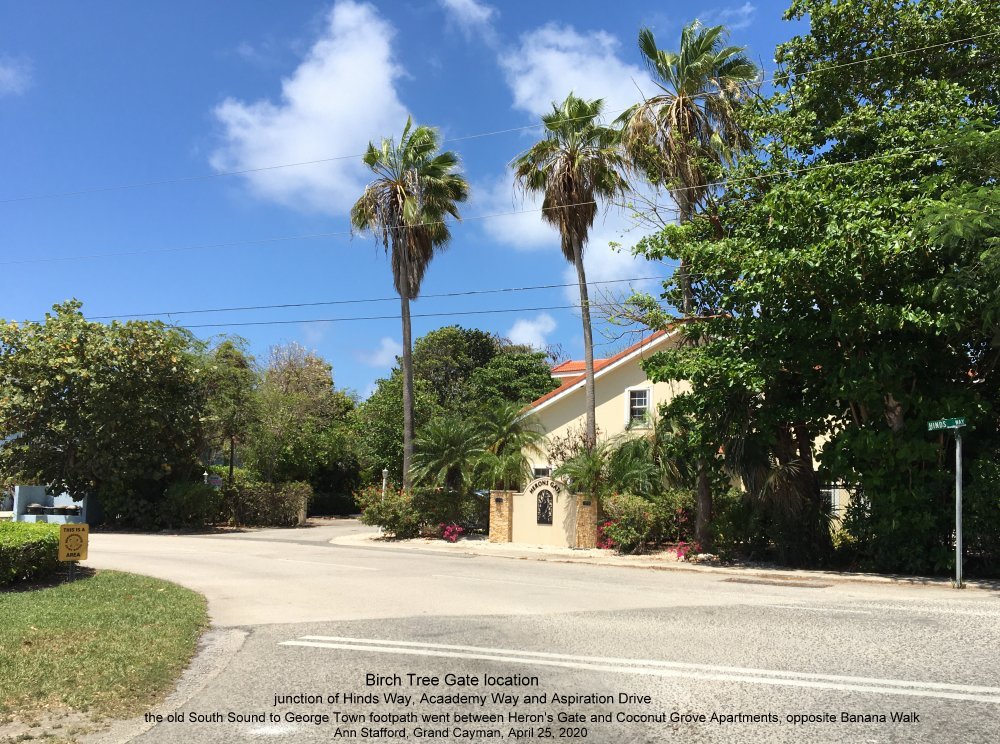
Birch Tree Gate location, on the old South Sound to George Town footpath, at the junction of Hinds Way, Academy Way and Aspiration Drive.
Walkers Road and Smith Road were named after the engineers who built them.
Media links
Emotions run high as government unveils its concept for a redeveloped Smith Barcadere to the public.
Cayman 27 TV News July 12, 2018
Emotions run high as government unveils its concept for a redeveloped Smith Barcadere to the public.
George Town South MLA Barbara Connolly and other officials introduced the nuts and bolts of the plan Tuesday night at a well attended public meeting.
Those in attendance provided no shortage of feedback for their consideration once the floor was turned over to public comment.
“There’s nothing here carved in stone, this is just a concept,” said A.L. Thompson, who chaired the two and a half hour meeting.
The public got its first look at government’s planned redevelopment of Smith Barcadere. …
Community meets to discuss development of Smith Cove
Cayman Compass July 8, 2018
A passionate crowd showed up at the South Sound Community Centre Tuesday night for a meeting about the redevelopment of Smith Cove, also known as Smith Barcadere.
George Town South MLA Barbara Conolly was on hand to share the plans for a refurbished beach site, and the community turned out en masse to provide its feedback….
Acknowledgements
Special thanks to:
Tricia Bodden, Cayman Islands National Archive.
Capt. Paul Hurlston (b. 1931) for his wealth of knowledge, grandson of Capt. Charles Christopher Bush (1864-1942) and nephew of Capt. Malcolm Carl Bush (1903-2004). Capt. Paul grew up next to Smith Barcadere.
References
Life and Adventure in the West Indies (Cayman Islands in 1906), by Vaquero 1914
Notes on the History of the Cayman Islands by George S.S. Hirst, 1910
A History of the Cayman Islands by Neville Williams, 1970
Capt. Malcolm Carl Bush, Oral History, Cayman Islands Native Archive, 1990
Under Tin Roofs – Cayman in the 1920s by Aarona Booker Kohlman, 1993
Wild Trees in the Cayman Islands by Frederick Burton, 1997, 2007
Flora of the Cayman Islands by George R. Proctor, 2012
Founded Upon the Seas – A History of the Cayman Islands and Their People by Michael Craton and the New History Committee, 2003
Wall of Honour, The book, Quincentennial Celebrations Office, 2003
Find A Grave
South Sound Community Cemetery
Note:
When doing the research, I have come across some inconsistencies in facts, names or dates.
Ironwood, Candlewood and Other Cayman Bush
Uses of some Plants that grow in the Cayman Islands
by P. Ann van B. Stafford, January 2018
Ethnobotany is the study of a region’s plants and their practical uses through the traditional knowledge of a local culture and people.

Ironwood – Chionanthus caymanensis, Endangered Cayman Islands endemic
 Ironwood flowers
Ironwood flowers
 Ironwood tree with Old George (Wittmackia caymanensis = Hohenbergia caymanensis), a giant Bromeliad, in its branches, and Silver Thatch palm – three Cayman endemic plants, and Naseberry (Sapodilla) Manilkara zapota naturalized, in a George Town garden.
Ironwood tree with Old George (Wittmackia caymanensis = Hohenbergia caymanensis), a giant Bromeliad, in its branches, and Silver Thatch palm – three Cayman endemic plants, and Naseberry (Sapodilla) Manilkara zapota naturalized, in a George Town garden.
Introduction
The CAYMAN ISLANDS were discovered by Columbus over 500 years ago. Permanent settlement came later. Indigenous plants were used for shelter, food, clothing, healing, everyday utility, boatbuilding, livelihood and export. They are part of the history, culture and identity of the Cayman Islands and what makes them unique. We don’t have large wild animals, but we do have an interesting diversity of wildlife, for which plants provide food and shelter. Native plants and animals are interdependent, and are part of intricate food webs.
Definitions
Cayman Native (Indigenous) Species
A Cayman Islands native species is one that occurs naturally in the Cayman Islands without direct or indirect human actions. Some plants and animals are native to only one or two of the three Cayman Islands. 415 taxa (species and varieties) formed the original, ancient flora of Grand Cayman, Little Cayman and Cayman Brac.
Cayman Endemic Species
An Cayman Islands endemic species is one that originated or evolved in a particular place, and that situation won’t change in the future. The Cayman Islands have 28 endemic taxa (species and varieties) of plant and 5 endemic subspecies of butterfly.
Cayman Common names
Different countries have different common names, sometimes more than one for the same plant, or one name may refer to several different plants. Several trees around the world are called Ironwood, but Cayman’s culturally important Ironwood trees are only found in the Cayman Islands – Chionanthus caymanensis . Scientific names avoid confusion of which plant is being referred to. Even though there are many plants, many don’t have Cayman common names – especially if they didn’t have a use. Some common names reflect how the plants were encountered.

Cayman common name / other common name(s)

Candlewood / Torchwood – Amyris elemifera Endangered
CaymANNature Flora photo album
CaymANNature Flora_2 photoalbum
Cayman Herbarium images album
1938 Oxford University Biological Expedition to the Cayman Islands photo album
Glossary
Dioecious – plant with separate male and female flowers on different plants
Monoecious – plant with separate male and female flowers on the same plant
Polygamous – plant bearing perfect and unisexual flowers on the same plant
Kings – the island and plant collection number (GC Grand Cayman, LC Little Cayman, CB Cayman Brac) of Wilfred Kings, botanist on the 1938 Oxford University Biological Expedition to the Cayman Islands
Cultural and ecological uses
some plants may be in more than one category
- Boatbuilding
- Construction
- Export
- General Utility
- Healing
- Look, Don’t Touch
- Other Cayman Plants
Boatbuilding
Schooners

1938 King George VI 5/- (Five shilling) Cayman Schooner stamp

The Western Union, a schooner launched by Heber Elroy Arch in Key West in 1939, is undergoing a US$900,000 overhaul that will allow it to remain seaworthy for another decade or two. The ship, built and designed by a Caymanian, originally featured Cayman mahogany to round out its frame.
Cayman designed schooner Aug. 1, 2017

Shipbuilder Heber Arch was one of 11 children of James Arch. The family worked together in crafting boats that would traverse the Atlantic.
Catboats
 Cayman Islands Catboat stamps First Day Cover Aug. 31, 2011
Cayman Islands Catboat stamps First Day Cover Aug. 31, 2011

Cayman Catboats at the Cayman Catboat Club, Aug. 2, 2014

Tools used for making Catboats
Bitter Plum – Picrodendron baccatum Endangered
Flowers dioecious, without petals. The wood is very hard.
Cayman Islands, Bahamas, Cuba, Hispaniola, Jamaica and the Swan Islands.
Kings GC 131, LC 77.
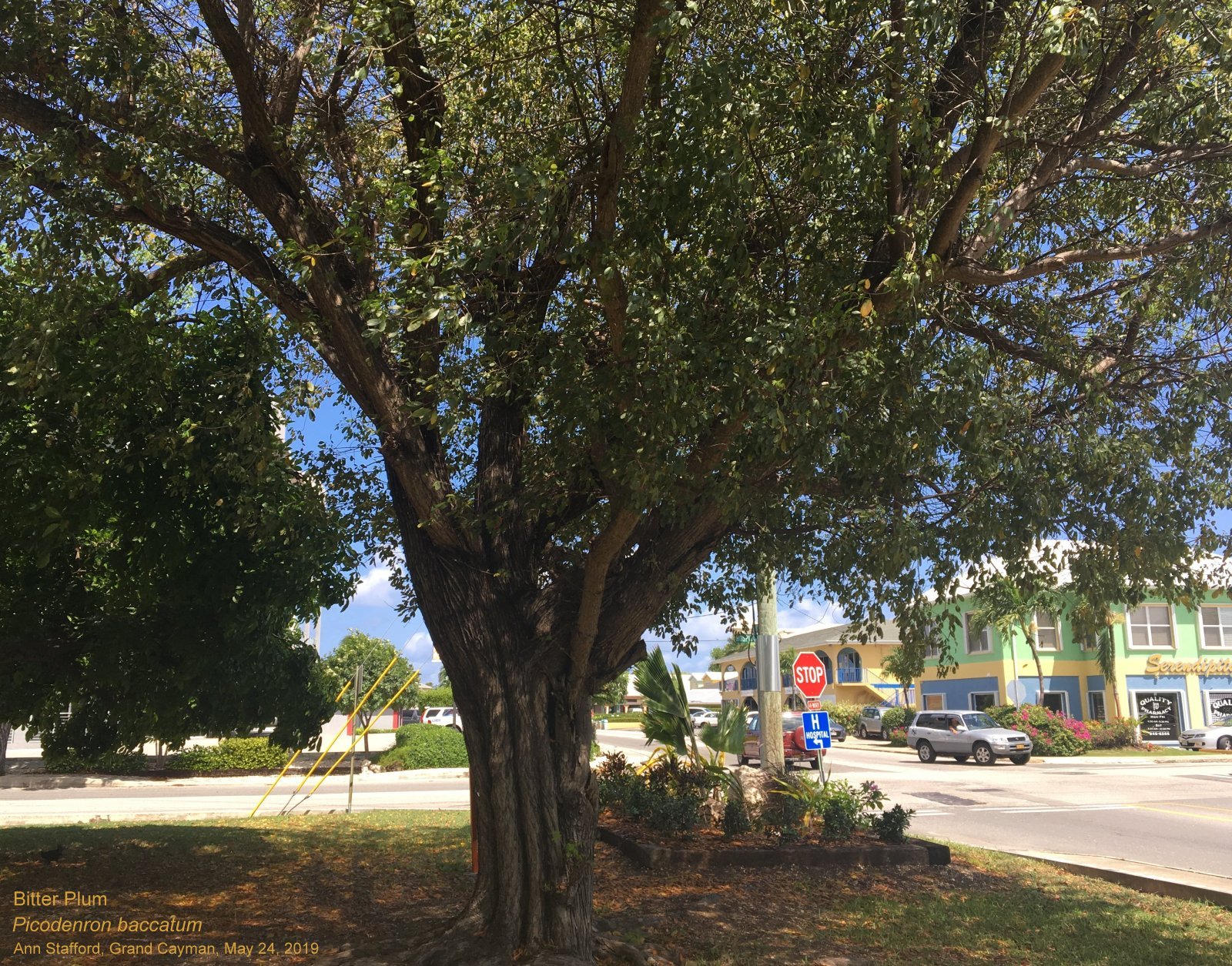 Bitter Plum tree in George Town by the Hospital crossroads
Bitter Plum tree in George Town by the Hospital crossroads


Cayman Islands, Bahamas, Cuba, Hispaniola, Jamaica and Swan Islands.
 Bitter Plum has a compound leaf with 3 distinctively-shaped leaflets.
Bitter Plum has a compound leaf with 3 distinctively-shaped leaflets.
Cedar, West Indian Cedar – Cedrela odorata Critically Endangered
West Indian Cedar is related to Mahogany, and should not be confused with the evergreen conifer Cedars of the genus Cedrus, such as the magnificent spreading Cedar of Lebanon (Cedrus libani).
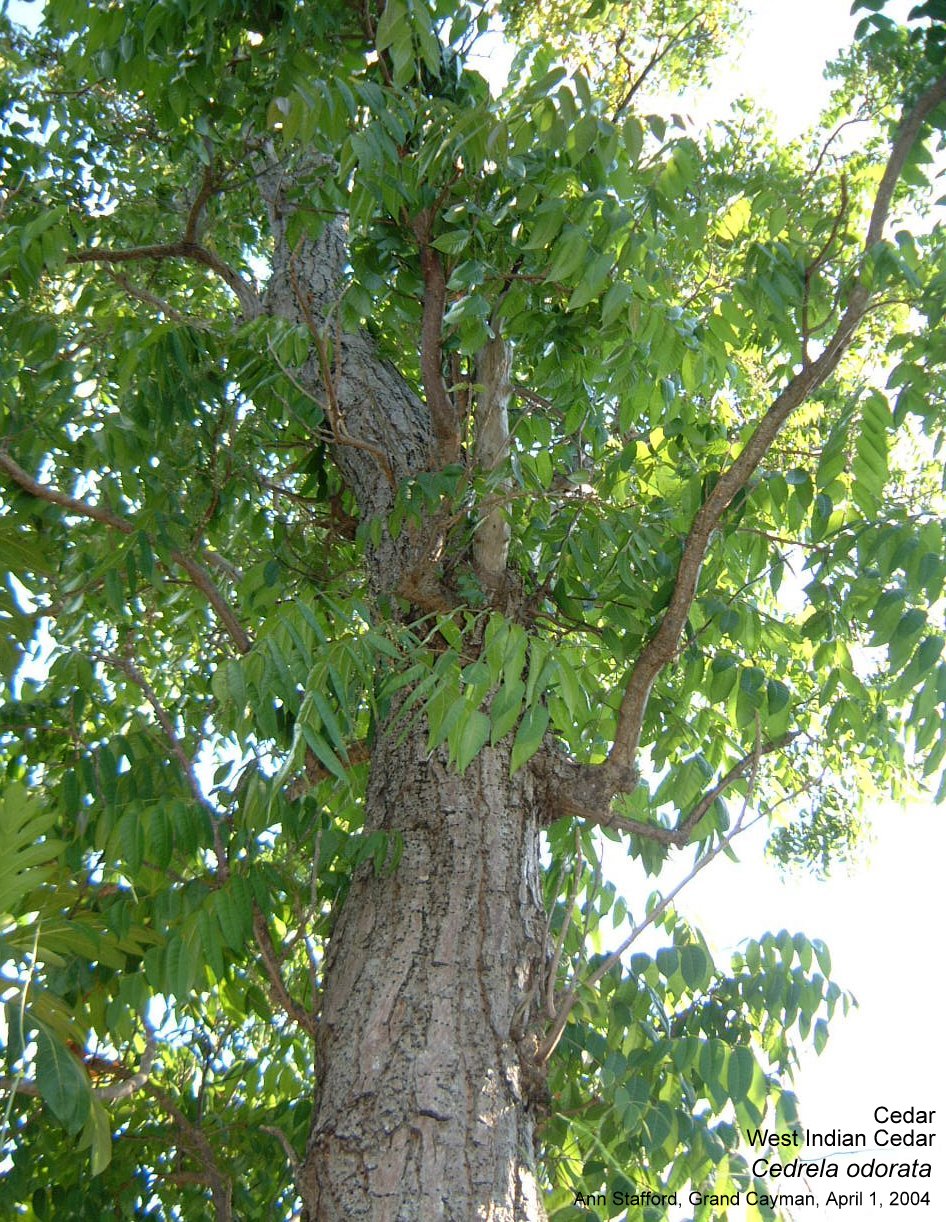 Cedar tree in George Town, April 1, 2004
Cedar tree in George Town, April 1, 2004
 Cedar, West Indian Cedar – Cedrela odorata, mature woody capsule fruits and wind-dispersed winged seeds
Cedar, West Indian Cedar – Cedrela odorata, mature woody capsule fruits and wind-dispersed winged seeds
Fiddlewood – Petitia domingensis, Family: VERBENACEAE (LAMIACEAE), Endangered. OPPOSITE leaves. Birds love to eat the fruits, particularly Mockingbirds and White-crowned Pigeons. The wood is heavy and very hard and was used for making fence posts and in shipbuilding. Flora of the Cayman Islands, Proctor 2012 p.584, Plate 56.

Fiddlewood – Petitia domingensis
Mahogany – Swietenia mahagoni
Mastic, Yellow Mastic – Sideroxylon foetidissimum Critically Endangered
Mastic, one of Cayman’s largest native trees, is the English common name used within its range – Central America, the West Indies (Mastic Ironwood, Mastic-bully – Bahamas) and US (southern Florida – False Mastic, Wild Mastic, Jungle Plum). It is very unusual for the Cayman common name to be the same as that in other countries, particularly the US. Mastic was used for boat-building, construction and furniture. The wood is hard, heavy, strong and durable. The heartwood is bright orange, surrounded by a yellowish band of sapwood.
 The buttressed trunk of the mighty Mastic tree, afterwhich the Mastic Trail is named
The buttressed trunk of the mighty Mastic tree, afterwhich the Mastic Trail is named
Pepper Cinnamon – Canella winterana
Pompero – Hypelate trifoliata Endangered
Pompero is an extremely slow-growing shrub or small tree and has a short, thick trunk with low, wide-spreading branches.
 It has a compound leaf with 3 distinctive leaflets, and small white flowers.
It has a compound leaf with 3 distinctive leaflets, and small white flowers.

The wood very hard, heavy, close-grained, a rich dark brown and a hard timber to work. It was used for posts, shipbuilding – ribs, mostly in large vessels, and Catboat keel and keelson and tool handles.

Pompero has other names: Plumperra and Wild Cherry. It is called White Ironwood in the US.
Pompero is sometimes infected with Witches’ Broom fungus in Cayman – Moniliophthora perniciosa (= Crinipellis perniciosa).

Popnut, Plopnut – Thespesia populnea


Sea Grape – Coccoloba uvifera Critically Endangered


Spanish Elm – Cordia gerascanthus
Construction
Candlewood / Torchwood – Amyris elemifera Endangered


Cabbage Tree – Guapira discolor

Cabbage Tree / Blolly, Beefwood – Guapira discolor


Blolly, Beeftree – Guapira discolor
Cherry – Myrcianthes fragrans, Endangered

Cherry / Twinberry, Simpson’s Stopper – Myrcianthes fragrans, attractive, pinkish bark, opposite leaves, strongly aromatic when crushed. Cherry was used for wattles.

Myrcianthes fragans – Twinberry, Simpson’s Stopper
Ironwood – Chionanthus caymanensis, Endangered Cayman Islands endemic, Family: OLEACEAE, leaves arranged in exactly Opposite pairs. The heavy wood is very hard, strong, termite and water-rot resistant, not inclined to warp. It was traditionally used for the foundation posts of houses. It grows only on Grand Cayman, Little Cayman and Cayman Brac and nowhere else in the world, in rocky woodlands, close to a fresh water table.

 Ironwood flowers
Ironwood flowers
 Ironwood posts, Cousin Cora’s Cottage, Boggy Sand Road, West Bay.
Ironwood posts, Cousin Cora’s Cottage, Boggy Sand Road, West Bay.
Mastic, Yellow Mastic – Sideroxylon foetidissimum Critically Endangered
 Mastic leaves have a long stalk and a minute inrolled pocket at the base of blade on upper side. The small, strongly scented flowers are yellowish.
Mastic leaves have a long stalk and a minute inrolled pocket at the base of blade on upper side. The small, strongly scented flowers are yellowish.
 Mastic fruit, a yellow drupe, has a large single seed covered with a thin, fleshy pulp.
Mastic fruit, a yellow drupe, has a large single seed covered with a thin, fleshy pulp.
Sea Grape – Coccoloba uvifera, Critically Endangered
Silver Thatch – Coccothrinax proctorii, Endangered Cayman Islands endemic
 Silver Thatch trees growing on Pedro St James bluff. They grow extremely slowing, about one inch per year. The underside of the fronds are silvery.
Silver Thatch trees growing on Pedro St James bluff. They grow extremely slowing, about one inch per year. The underside of the fronds are silvery.
Spanish Elm – Cordia gerascanthus, Family: BORAGINACEAE, Endangered.
In the Cayman Islands, Spanish Elm was used in general construction and for making oars.
Greater Antilles, Mexico, Central America and Columbia.

Strawberry, (White Stopper – US) – Eugenia axillaris
Shrub or small tree with aromatic leaves, difficult to distinguish from Bastard Strawberry, (Pale Lidflower – US) – Calyptranthes pallens Endangered, except when flowering or fruiting. Strawberry wood was used to make wattles for traditional Cayman Wattle and Daub houses, and for fish pots. It also makes a good walking stick.
Florida, West Indies, Mexico and northern Central America in sandy or rocky thickets and woodlands.
Kings GC 285

 Strawberry fruits, black when ripe, are edible, but not particularly paletable.
Strawberry fruits, black when ripe, are edible, but not particularly paletable.

Wattle and Daub construction, Cayman Catboat Club

Export
Coconut Palm – Cocos nucifera.
There was a thriving Coconut industry on the Sister Islands – Cayman Brac and Little Cayman, in the late 1800s and early 1900s. The coconuts were husked before being exported. The trees succumbed to a disease – lethal yellowing.

Cotton, Wild Cotton, Short-staple Cotton – Gossypium hirsutum var. punctatum
Cotton was exported from 1780s. It was the most valuable cargo between 1802 and 1804. All of the cotton plantations were in south central Grand Cayman, averaging about 100 acres.
Cayman’s cotton industry declined after 1810.

Wild Cotton, Short-staple Cotton – Gossypium hirsutum
Fustic – Maclura tinctoria (dye wood), Critically Endangered, Family: MORACEAE

Fustic wood is tough and close-grained. It was exported from mid-1700’s to early 1800’s for khaki or fustic, a yellowish dye extracted from the wood, which was used for dyeing cloth for military uniforms and schoolboys clothing. It grows in Grand Cayman, Cayman Brac, the West Indies and continental tropical America.
Flora of the Cayman Islands, Proctor 2012 p.241, Fig.84.
Kings GC 408
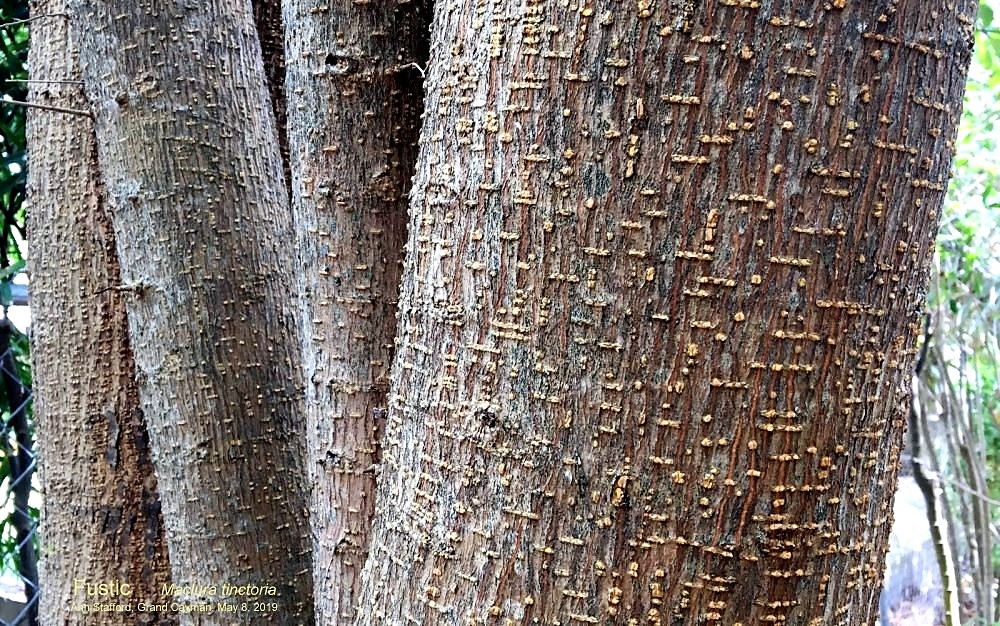
Fustic is DIOECIOUS – male and female flowers grow on separate trees, fruits form from female (pistillate) flowers only.


Logwood – Haematoxylum campechianum (dye wood), introduced from Central America. Logwood is a small, thorny tree with a deeply fluted trunk and wide spreading branches. It grows fast and aggressively colonizes in low-lying damp ground, that is not too salty. The wood is hard, heavy and slow to rot and is still used for fence posts.


Bees make honey from Logwood flowers. Logwood, native to Central America, is naturalized in the West Indies, where it was introduced early in the 18th. century as an export for its bluish-black dye from the red heartwood. It was a source of dye formerly used for textiles and which is still highly valued as a bacteriological and cytological stain.
Logwood is invasive in Cayman
Mahogany – Swietenia mahagoni, Endangered. 1730s – 1740s The first formal land grants were made in Cayman, mainly to cut Mahogany. Mahogany furniture had become popular in Britain and Europe and Mahogany surpassed turtle as Cayman’s most valuable product.

The same huge Mahogany tree in East End, before and after Hurricane Ivan (Sept. 2004)

Red Mangrove – Rhizoraphora mangle Near Threatened
Red Mangrove trees contains tannins and were barked from the early 1900s to 1930s in Cayman. This was shipped to Jamaica and thence to Europe for tanning leather. The barked trees died afterwards.

 Red Mangrove flowers – 4 white petals, 4 yellow sepals
Red Mangrove flowers – 4 white petals, 4 yellow sepals
 Red Mangrove propagules – elongated torpedo-like seedlings that develop from brown, oval fruits while they are still attached to the tree.
Red Mangrove propagules – elongated torpedo-like seedlings that develop from brown, oval fruits while they are still attached to the tree.
Satinwood, Yellow Sanders – Zanthoxylum flavum Critically Endangered
Dioecious or polygamous (bearing perfect or inisexual flowers on the same plant) tree, Florida, Bermuda, West Indies, extremely rare on all three Cayman Islands. Satinwood was highly prized for its yellow, satiny lustre that took a high polish and was used in cabinetry and furniture.

The compound leaves have pellucid dots with oil glands.


Satinwood is a larval food plant of the endemic Grand Cayman Swallowtail butterfly – Papilio andraemon tailori (two caterpillars in the photo).
Satinwood – Zanthoxylum flavum
‘The tree has an excellent, ornamental timber that was highly desired for inlay, fine furniture etc. It was so heavily exploited that large trees are now almost unheard of.’
Silver Thatch – Coccothrinax proctorii (rope), Endangered Cayman Islands endemic
Cayman Islands National Tree
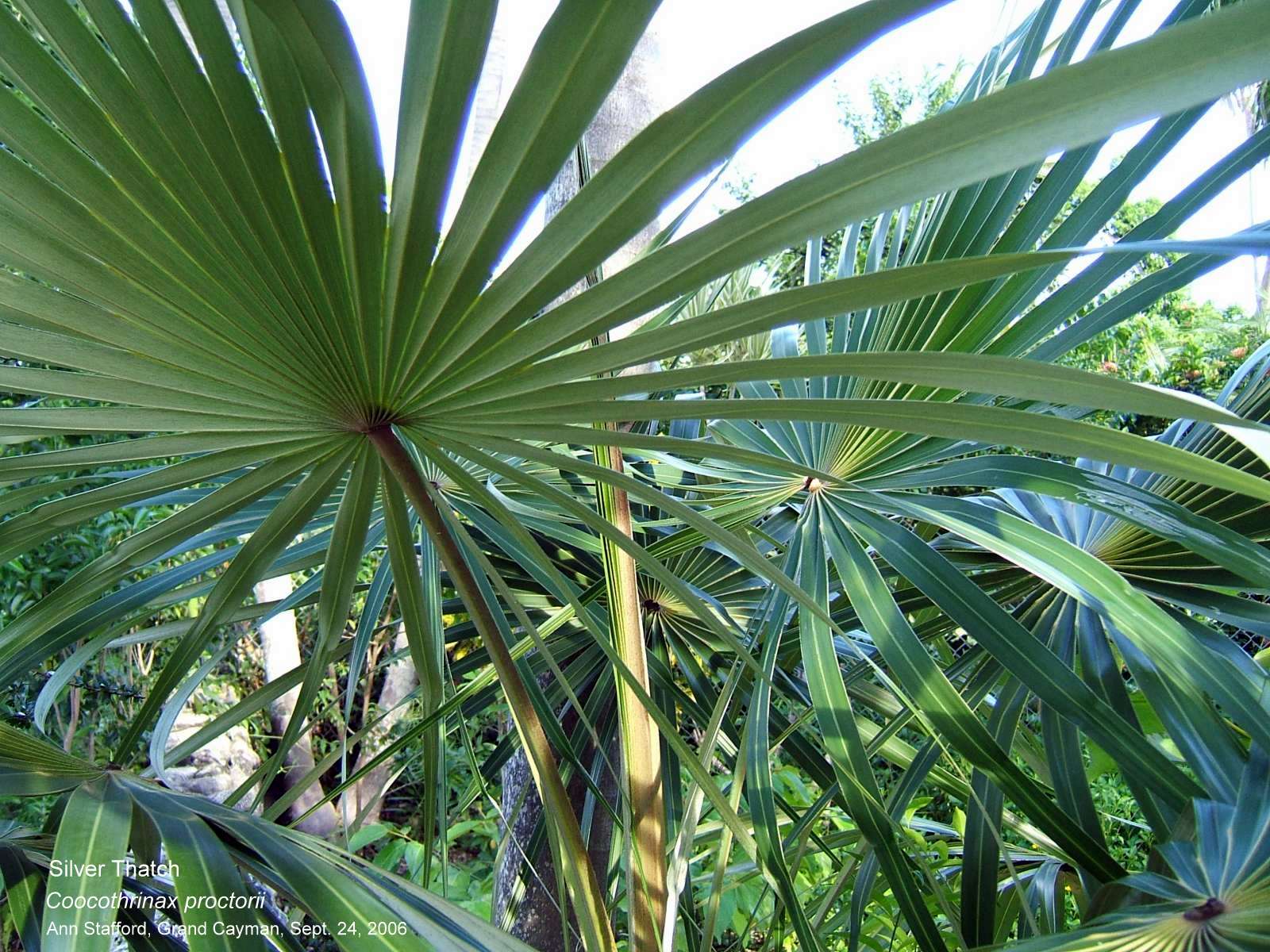

 Rope made from the ‘tops’ Silver Thatch palm was exported to Jamaica.
Rope made from the ‘tops’ Silver Thatch palm was exported to Jamaica.
General Utility
Banana Orchid – Mymecophila thomsoniana
Cayman Islands National Flower


Calabash (or Gourd) tree – Crescentia cujete, Family: BIGNONIACEAE. The sprawling tree bears large green fruits, gourds (up to 25 cm in diameter) – the woody outer shells were traditionally used to make water containers, soup bowls, plates and for bailing boats. Florida, West Indies and continental tropical America.

 Calabash, Gourd tree, has trumpet-shaped flowers that sprout directly from the branches and trunk and are pollinated by Buffy Flower bats.
Calabash, Gourd tree, has trumpet-shaped flowers that sprout directly from the branches and trunk and are pollinated by Buffy Flower bats.
Cedar, West Indian Cedar – Cedrela odorata Critically Endangered
Cedar has large, compound leaves (similar to Maiden Plum) and aromatic, reddish wood, soft but durable, resistant to attack by insects. In addition to boat-building, Cedar was used for cigar boxes, musical instruments, light construction, veneer and plywood.
Grand Cayman, Cayman Brac, West Indies and continental tropical America.
Kings GC 337
 Cedar tree growing through a fence in George Town.
Cedar tree growing through a fence in George Town.
Cedrela odorata: Useful Tropical Plants
Coconut Palm – Cocos nucifera
 Coconut Palm trees by the Lake at the Queen Elizabeth II Botanic Park
Coconut Palm trees by the Lake at the Queen Elizabeth II Botanic Park
Corato, Cordo, Corto – Agave caymanensis* Vulnerable Cayman Islands endemic to the three Cayman Islands
Corato grows in dry shrubland, especially at the drier eastern ends of each island. Corato is a large, fleshy, rosette plant with massive, succulent, spine-tipped leaves. It develops a woody trunk at maturity. The flowers are yellow, and small vegetative bulbils, miniature plants, are produced on the inflorescence after flowering.

Like all Agaves, it is monocarpic, flowers only once in its lifetime and dies afterwards.

Corato leaves were dried and used for scrubbing floors. People didn’t have soap powder. The leaves were cut and pounded, to make them soft. Ashes and water were poured on them to make LYE water for doing laundry.

Guava – Psidium guajava
Shrub or small tree, naturalized in Cayman, has 4-angled branchlets and leaves with numerous pellucid dots. The fruit is a pinkish or yellowish edible berry with numerous small seeds. Gigs (spinning tops) were made from Guava wood.
Guava grows in the American tropics; it is grown for its edible fruits and becomes naturalized.
Kings 385

 Gigs (spinning tops) made from Mahogany and Guava wood
Gigs (spinning tops) made from Mahogany and Guava wood
Mastic, Yellow Mastic – Sideroxylon foetidissimum Critically Endangered
Mastic was used for boat-building, construction and furniture
 Mastic tree, flowering, at Health City, Grand Cayman, May 17, 2019
Mastic tree, flowering, at Health City, Grand Cayman, May 17, 2019
Naseberry, Sapodilla – Manilkara zapota
Kings GC 347
Sapodilla, Naseberry – Manilkara zapota – Useful Tropical Plants
Silver Thatch – Coccothrinax proctorii (rope), Endangered Cayman Islands endemic

Sisal, Sisal Hemp – Agave sisalana – introduced, naturalized, invasive
Dark brown, very sharp pointed spine at the tips of the leaves. Edgar Samuel McCoy (born in 1851) was a pioneer of the Sisal industry in Grand Cayman.
1910 Hirst’s Notes on the History of the Cayman Islands: Many acres have been laid out in Agave sisalana and many more will be laid out shortly …… Sisal bears after 3 years, whereas coconut bears after at least 6 years. The Sisal plant is unaffected by drought or hurricanes, while the coconut is seriously affected by both.
 Sisal tends to persist after cultivation.
Sisal tends to persist after cultivation.
Slingshot, Wild Jasmine – Tabernaemontana laurifolia Endangered
White latex
Dry rocky thickets and woodlands
Grand Cayman and Jamaica only


Smoke Wood – two species grow in Cayman, one is common, the other is rarer. They have similar leaves, white flowers and red fruits (a drupe). Smoke Wood was one of the woods burnt in smoke pots, cans filled with smouldering wood to ward off mosquitoes, an introduced menace. There was no mention of mosquitoes in early records. None of the three species of Erythroxylum in Cayman contains cocaine, which is obtained from the leaves of Erythroxylum coca that grows in the Andean region of South America.
Smoke Wood – Erythroxylum areolatum
Cayman Islands, Bahamas, Greater Antilles, Mexico, and northern Central America, in rocky woodlands.
Kings GC 204a, GC 333
 The wood is hard, heavy, fine-textured and very durable. It was used for fence posts.
The wood is hard, heavy, fine-textured and very durable. It was used for fence posts.
 Two faint parallel lines can be seen on either side of the main vein on the underside of the leaf. A beetle pollinates the white flowers.
Two faint parallel lines can be seen on either side of the main vein on the underside of the leaf. A beetle pollinates the white flowers.

 Smoke Wood fruits of both species are bright red when ripe.
Smoke Wood fruits of both species are bright red when ripe.
Smoke Wood – Erythroxylum confusum Critically Endangered
grows in seasonally flooded sinkholes.
Grand Cayman, Bahamas, Cuba and Jamaica.
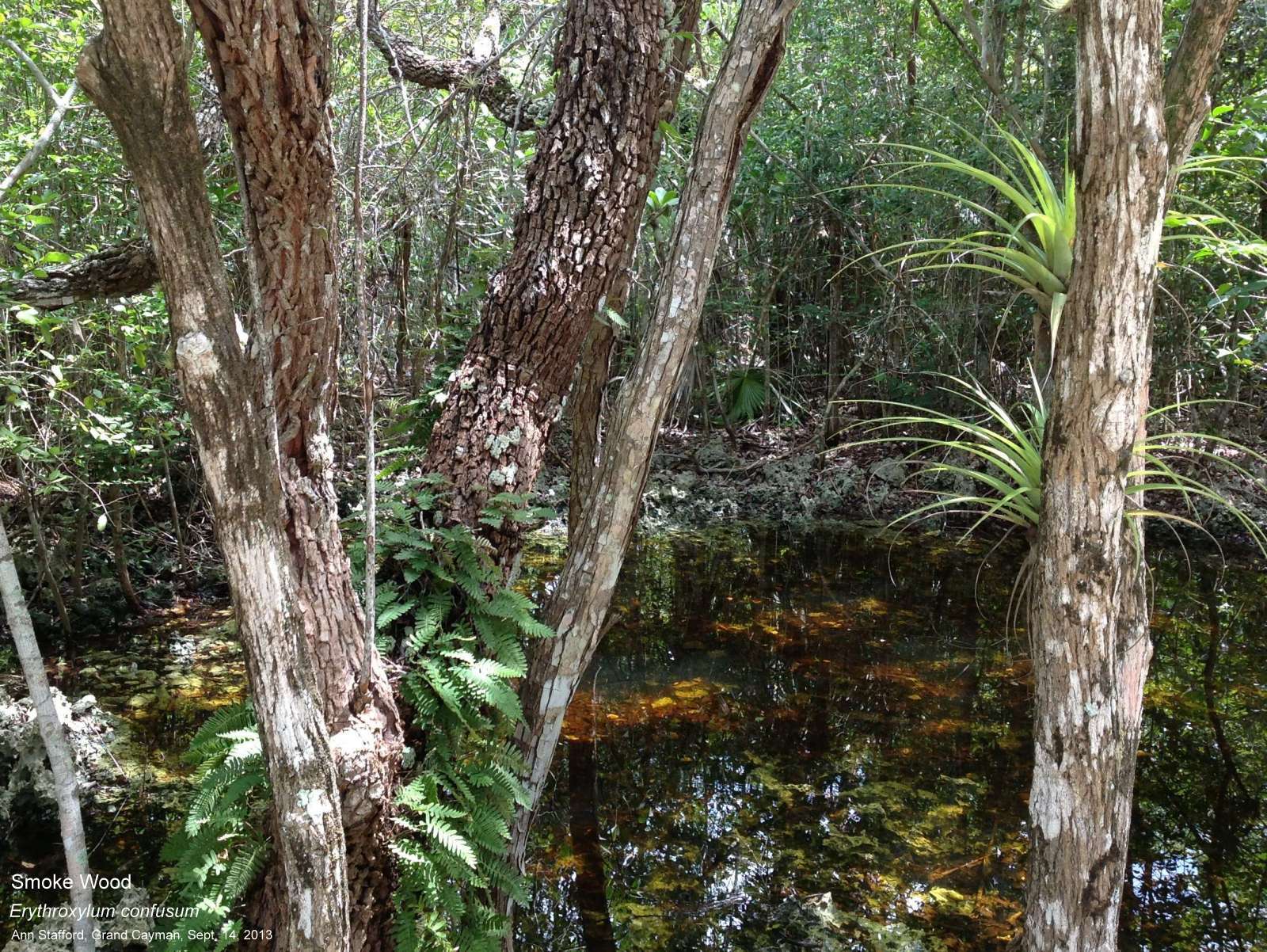 Smoke Wood (Erythroxylum confusum) with Resurrection Fern (Polypodium polypodioides) growing on the corky-looking bark of its trunk at the Queen Elizabeth II Botanic Park on the Woodland Trail.
Smoke Wood (Erythroxylum confusum) with Resurrection Fern (Polypodium polypodioides) growing on the corky-looking bark of its trunk at the Queen Elizabeth II Botanic Park on the Woodland Trail.
Resurrection Fern fronds curl up in dry weather and look dead, but open up and become green after rain.
Kings F 32, F 32-a, F 36, F 45
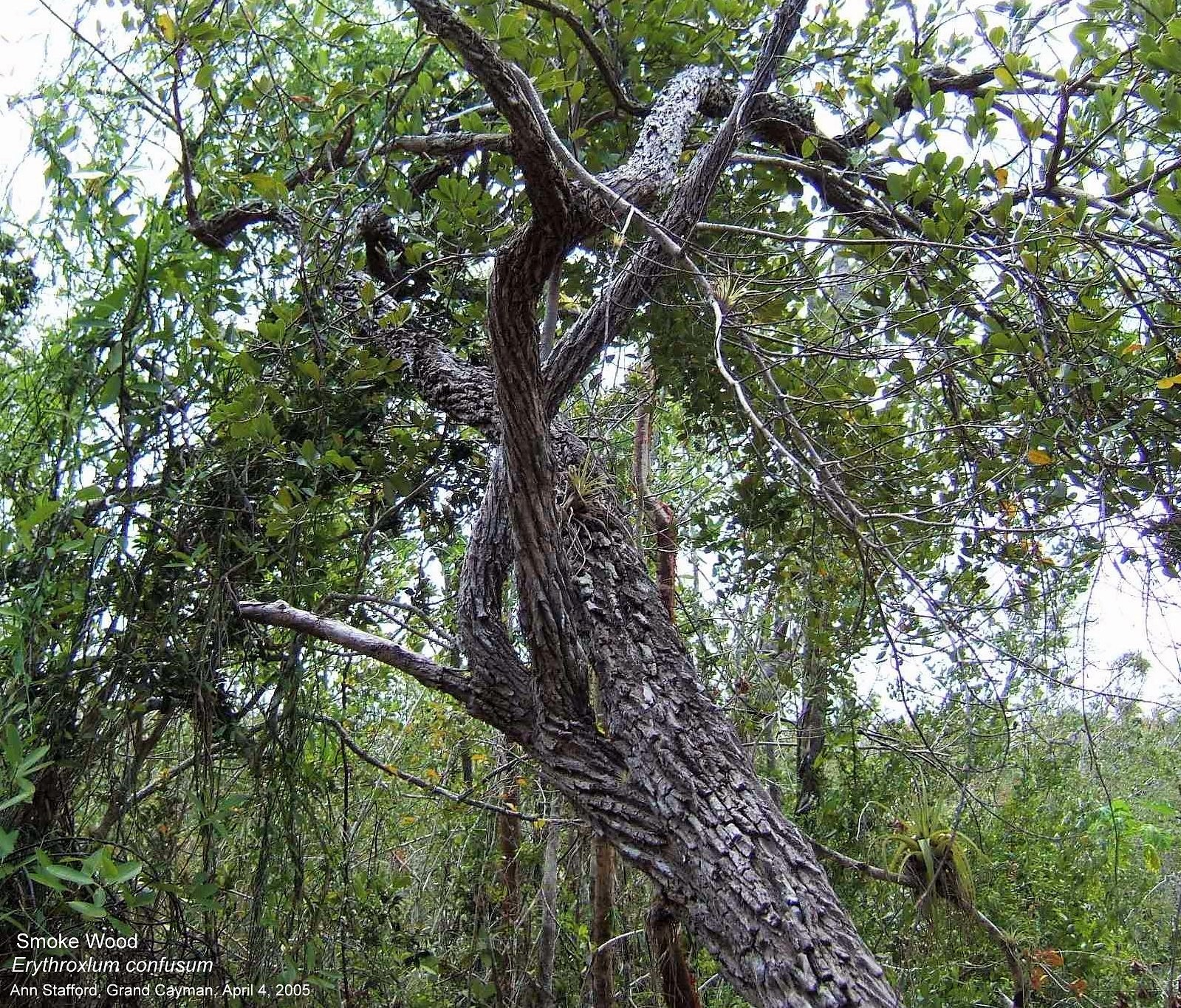
Strawberry (White Stopper – US) – Eugenia axillaris
 Calavans (traps) were made from trees with straight, durable limbs such as Strawberry, Cabbage or Shamrock. The new, young leaves of Strawberry are pinkish-red.
Calavans (traps) were made from trees with straight, durable limbs such as Strawberry, Cabbage or Shamrock. The new, young leaves of Strawberry are pinkish-red.
 Calavan (trap) made by Deal Ebanks
Calavan (trap) made by Deal Ebanks
Wash Wood – Jacquinia keyensis Endangered
Wash Wood (called Joewood in the US), extremely slow-growing and salt-tolerant, was used to wash clothes. The bark was scraped off, the trunk chopped – tapped, and a container used to collect the beige sap. The sap was mixed with lye water – well-water which had been mixed with ashes, allowed to stand & strained off.

Grand Cayman, Cayman Brac, Florida, the Bahamas, Cuba, and Jamaica, in coastal scrub-lands and thickets.
Kings GC 172
 Wash Wood habitat, North Sound, West Bay
Wash Wood habitat, North Sound, West Bay
Cayman Cultural Trees – Stamps
 Wash Wood – Jacquinia keyensis 15 cent stamp, release date Feb. 23, 2006
Wash Wood – Jacquinia keyensis 15 cent stamp, release date Feb. 23, 2006

Wash Wood, Proctor’s Jacquinia – Jacquinia proctorii Critically Endangered
Cayman Islands and Jamaica
Kings GC 334

Wild Cinnamon – Croton nitens Endangered
Aromatic leaves, minutely pellucid dotted, (not to be confused with Pepper Cinnamon – Canella winterana, which also has aromatic leaves).
Dry rocky woodlands
Jamaica, Swan Islands, Mexico and Central America
 Flowers, fruits and bright orange dying leaf
Flowers, fruits and bright orange dying leaf

Wild Cinnamon wood used for making fish-pot frames, the wood sinks and is durable in salt water.
Healing
The information is for educational purposes only and is not intended to be an endorsement of any of the old-time remedies. Some parts of a plant, ripe or unripe, may heal, while other parts of the same plant may be poisonous. There may be a fine line between kill and cure.
decoction – boiled; the liquor resulting from concentrating the essence of a substance by heating or boiling, especially a medicinal preparation made from a plant.
infusion – steeped; a drink, remedy, or extract prepared by soaking the leaves of a plant or herb in liquid.
Medicinal Plants and Cultural Uses photo album
Aunt Eliza Bush, (Twining Soldierbush) – Myriopus volubilis = Tournefortia volubilis
Kings GC140, LC 12
Aloe Vera “Sempervivie”, ‘Alloways” – Aloe vera
Basil “Tea Basil” , Pimento Basil, (Least Basil) – Ocimum campechianum = O. micranthum
Kings GC 213; LC 6.
Basil “Sweet” – Ocimim basilicum
Birch – Bursera simaruba
Broadleaf – Cordia sebestena var. caymanensis
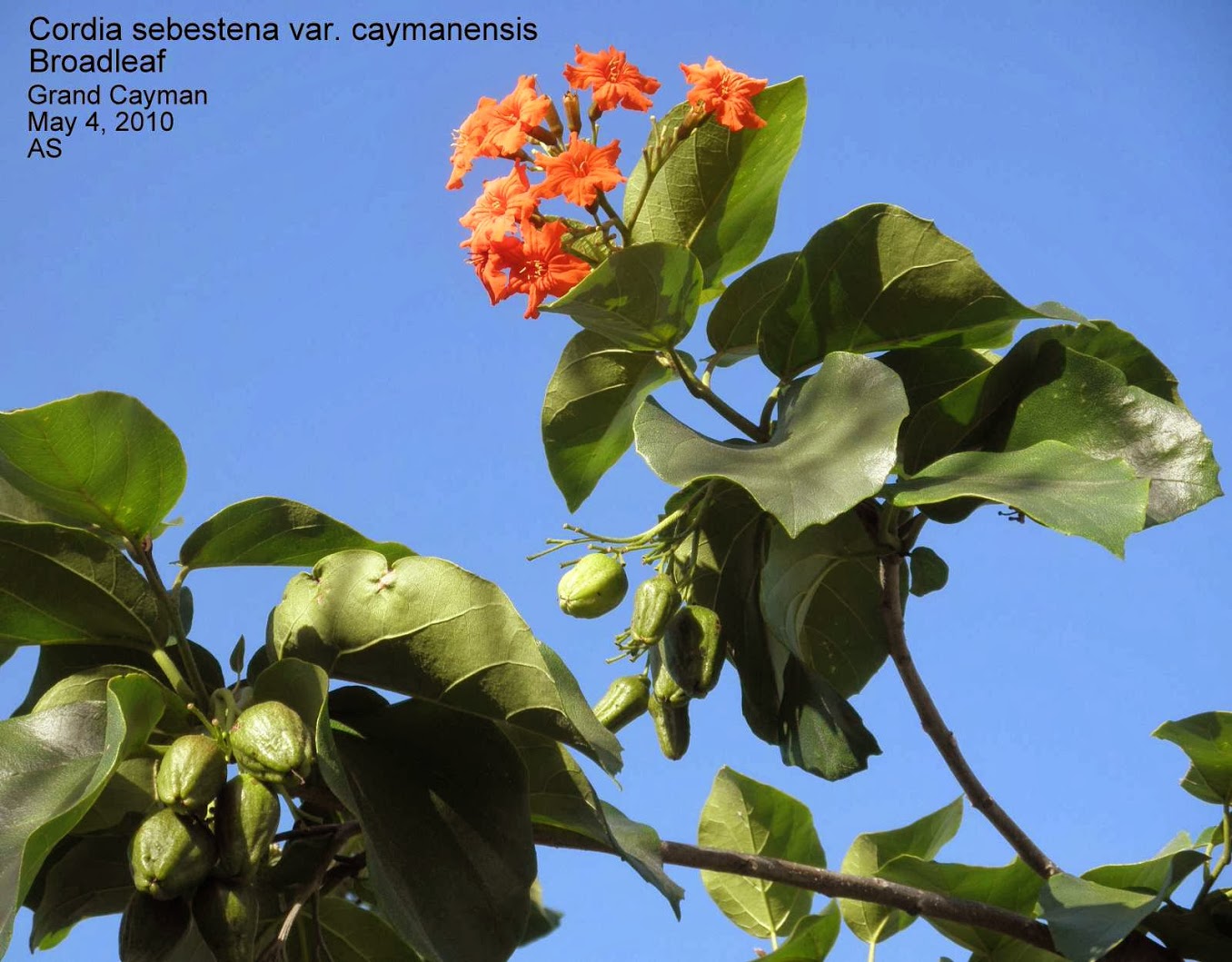
Castor Oil Plant, Castor Bean – Ricinus communis. Family: EUPHORBIACEAE.
A wide-branching shrub 2-5 m tall, with watery sap and ALTERNATE leaves, native to Africa. It is monoecious: separate female (upper) and male (lower) flowers are borne on the same plant. The fruit, a capsule, is usually spiny and the seeds mottled. The seeds and leaves have been used since ancient times as a purgative and emollient. It was one of the most popular and revered plants in Cayman. Habitat: old fields, roadsides, open waste ground, gardens.
Warning: the seeds contain the highly POISONOUS phytotoxin RICIN and can be fatal if swallowed. Heat inactivates ricin (a protein).


Castor Oil Plant, Castor Bean – Ricinus communis
Castor Oil Plant – Ricinus communis
Cochineal, “Scotchineal” – Nopalea cochenillifera (syn. Opuntia cochenillifera)
A cactus naturalized in Cayman, edible fruits.

Kings GC 340; CB 33.
Coconut – Cocos nucifera
Kings CB 52, CB 53
 Coconut Palm on South Sound beach, looking across to Prospet Point, an area of early settlement.
Coconut Palm on South Sound beach, looking across to Prospet Point, an area of early settlement.
Cowitch – Mucuna pruriens
A herbaceous vine that grows over other vegetation.
 The distinctive compound leaf has 3 leaflets, the mid-veins of the 2 side leaflets are off-center.
The distinctive compound leaf has 3 leaflets, the mid-veins of the 2 side leaflets are off-center.
 Flowers are a dull dark purple. The velvety-brown seed pods are covered with stinging hairs which cause intense itching. They cannot be washed off. Naturalized in Cayman, pantropical
Flowers are a dull dark purple. The velvety-brown seed pods are covered with stinging hairs which cause intense itching. They cannot be washed off. Naturalized in Cayman, pantropical
Applying flour to the affected area relieves the itching.

Cow-itch – Bush Medicine – Cayman Islands National Museum
The hairs of the pods were used to get rid of intestinal worms. This remedy was dreaded by Cayman children. “We were dosed with this thing made by scraping the pods on the cow-itch plants. That was mixed with green banana which had been boiled in milk with some sugar in it. We would have to eat the wretched thing.”

Kings GC 228
Dandelion – Senna occidentalis
Dandelion, Coffee Senna, Stinking Bush, Septic Weed – Senna occidentalis (syn. Cassia occidentalis), Family: FABACEAE (LEGUMINOSAE, subfamily: CAESALPINIOIDAE).
An erect shrubby annual herb, to about 1 m tall, often subwoody near the base.
Compound leaves that have an unpleasant odour when crushed, flowers yellow, pods oblong-linear, slightly curved. The dried root was used for loss of apetite. The roasted and pulverized brown seeds were used as a substitute for coffee. It is the larval food plant of the Cloudless Sulphur butterfly – Phoebis sennae.
Kings GC 220

Dandelion – Senna occidentalis
Dashalong – Turnera ulmifolia, Family: TURNERACEAE.
 Dashalong leaves were boiled to make a tonic tea, for liver and kidney trouble and for coughs and colds. It is the larval food plant of the Mexican Fritillary butterfly (Euptoieta hegesia).
Dashalong leaves were boiled to make a tonic tea, for liver and kidney trouble and for coughs and colds. It is the larval food plant of the Mexican Fritillary butterfly (Euptoieta hegesia).
Dogwood, Jamaica Dogwood, Fishfuddle Tree, Fish Poison Tree – Piscidia piscipula, Family: FABACEAE, Endangered. Leaves Alternate, compound, odd-pinnate. Pink flowers in panicles, pod greenish-yellow, straw-coloured at maturity, with papery wings.

The bark, especially of the roots, is well-known for its narcotic and poisonous properties. It has been used to relieve toothache and for curing mange in DOGS. If the bark and leaves are crushed and thrown into water, most nearby fish will become stupified and will float on the surface. The fruit has been used in South America for arrow poison.
 Dogwood – Piscidia piscipula Note: Care must be taken with the use of this plant. Cayman Islands National Archive Oral History: A tea made from bark and leaves was ‘just nice”. Sap will draw a prickle from a finger.
Dogwood – Piscidia piscipula Note: Care must be taken with the use of this plant. Cayman Islands National Archive Oral History: A tea made from bark and leaves was ‘just nice”. Sap will draw a prickle from a finger.
Jamaica Dogwood, Florida Fishpoison tree – Piscidia piscipula
Eucalyptus – Eucalyptus globulus, Family: MYRTACEAE. used as a balsamic, a hypoglycaemic and an antiseptic. The terpenoid volatile oil, cineol, is an expectorant and has a stimulating effect. Used as an inhalant.
Leaves of Eucalyptus “were made into a tea and the leaves were steeped in the bath and that was used to bathe you and steam you, for bad cold or pneumonia”. Eucalyptus oil is one of the active ingredients of Vicks VapoRub.
The bark was burned to ward off mosquitotes.
Eucalyptus, Blue Gum – Eucalyptus globulus, KEW
 Eucalyptus – Eucalyptus globulus, Shedden Road, opposite the Eucalyptus Building. The tree pictured above has been misidentified and is probably the Paperbark tree – Melaleuca quinquenervia, in the same family: MRYTACEAE.
Eucalyptus – Eucalyptus globulus, Shedden Road, opposite the Eucalyptus Building. The tree pictured above has been misidentified and is probably the Paperbark tree – Melaleuca quinquenervia, in the same family: MRYTACEAE.
A tree of another name is still as sweet
Fever Grass – Cymbopogon citratus
Headache Bush – Quadrella cynophallophora syn. Capparis cynophallophora

Headache Bush leaves were chopped, crushed, put in a bottle and used as smelling salts for headaches. Crushed leaves were applied externally for toothache.
Kings GC 142


Headache Bush is a larval food plant of the Great Southern White butterfly – Ascia monuste.
Heart Plant – Ruellia tuberosa
Juniper, Jennifer (Bay Cedar – US) – Suriana maritima
An attractive bushy pantropical seashore shrub. In Cayman, the bark was rubbed off to make a poultice to deaden the pain of toothache.
Kings GC 22, LC 85, CB 57


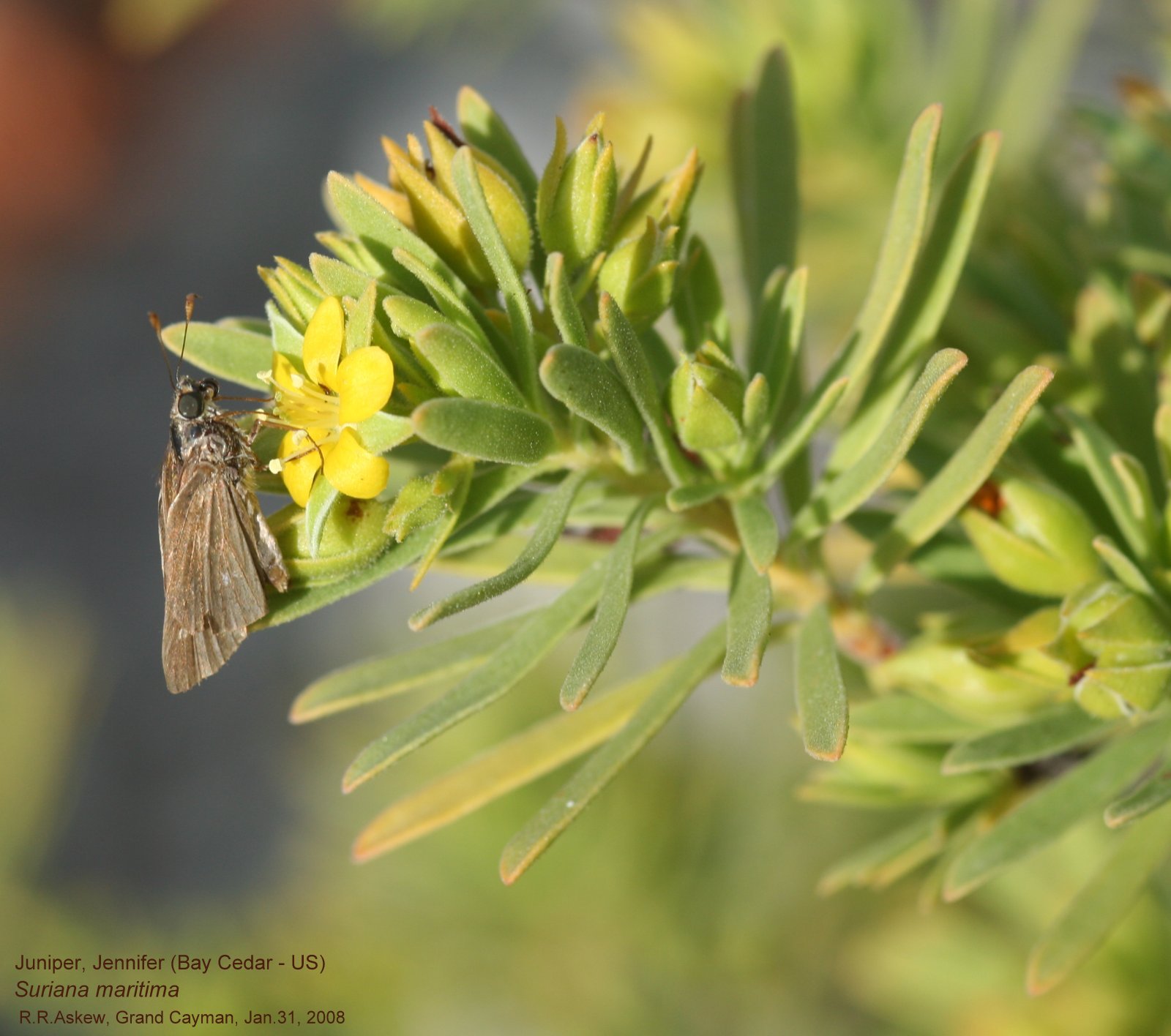 Juniper, Jennifer (Bay Cedar) is a larval food plant of the Cuban Grey Hairstreak (Strymon martialis) and Drury’s Hairstreak (S. istapa) butterflies and a nectar plant for several butterflies.
Juniper, Jennifer (Bay Cedar) is a larval food plant of the Cuban Grey Hairstreak (Strymon martialis) and Drury’s Hairstreak (S. istapa) butterflies and a nectar plant for several butterflies.
Bay Cedar – Suriana maritima – Natives for Your Neigh(borhood
Lavender, Sea Lavender – Tournefortia gnaphalodes (syn. Argusia gnaphalodes) Family: BORAGINACEAE. Dense, mound-like shrub, narrow leaves ALTERNATE, fleshy, velvety, silvery-grey. The fragrant white flowers attract butterflies. Seacoasts and saline shores, particularly sandy beaches. Bermuda, Florida, West Indies, and coasts of Yucatan, Cozumel, Belize and Venezuela. Photo: Ann Stafford, Pedro bluff, Grand Cayman, Feb.16, 2014. FLORA of the CAYMAN ISLANDS by George R. Proctor 2012 p.559, Fig.208, Pl.52.
In Cayman, a tea was made from boiled leaves for stomach problems and nerves

Sea Lavender – Tournefortia gnaphalodes (syn. Argusia gnaphalodes)
Sea Lavender – Tournefortia gnaphalodes
Leaf-of-Life, Curiosity Plant, (Cathedral Bells) – Kalanchoe pinnata (syn. Bryophyllum pinnatum), Family: CRASSULACEAE. Succulent perennial herb to 1m tall, leaves have scalloped edges, native to Madagascar, naturalized throughout the tropics.
In Cayman, the leaves were used to treat coughs, colds and sore throats, and to bathe swellings, sprains and bruises. It is called Leaf-of-Life, because when leaves fall on the ground, new plants sprout from the scalloped edges and take root.

Leaf-of-Life, Curiosity Plant – Kalanchoe pinnata
Lime – Citrus X aurantifolia
Liquorice, Wild, “John Crow Bean” – Abrus precatorius
Mulberry / Noni – Morinda citrifolia
Mulberry, Hog Apple, Noni, Duppy Soursop; Indian Mulberry – Morinda citrifolia is a shrub or small tree, naturalized in Cayman, leaves Opposite, flowers white. Fruit a fleshy, compound berry (synocarp), irregular shape, creamy-translucent when ripe, with a foetid odour. Native to tropical Asia and Australia, naturalized in the American tropics.
Mulberry / Noni leaves were used as a poultice for wounds to relieve pain, and as a treatment for rheumatic joints, fevers and headaches.
Kings LC 112.

Old Lady Coat Tail – Priva lappulacea
Naseberry, Sapodilla – Manilkara sapota
Pepper Cinnamon – Canella winterana CANELLACEEAE Canella Family
Critically endangered. Florida and the West Indies south to Barbados
Canella bark was used as an aromatic stimulant and tonic. In the 1700s, the inner bark was exported from the West Indies to Europe as a substitute for cinnamon. The outer bark is toxic.
The wood was used for Catboat sculls (oars).
Flora of the Cayman Islands by George R. Proctor, 2012 p.225, Fig.77, Plate 10.

The tree provides food and cover for wildlife.

Pepper Cinnamon – Canella winterana
Periwinkle – Catharanthus roseus
Pomegranate – Punica granatum
Providence Mint – Lippia alba
Rhubarb Root – Morinda royoc
Rosemary – Croton linearis
Note: The Cayman shrub, Rosemary, should not be confused with culinary woody, perennial herb, Rosemary (Rosmarinus officinalis), native to the Mediterranean region, or the variegated leaf landscaping shrub, Croton (Codiaeum variegatum).
A dioecious, pleasantly aromatic shrub, Rosemary (Pineland Croton or Granny-Bush – US) is a multipurpose plant. The leaves were steeped to make tea for striction, as a tonic, boiled to make a tea for diabetes or smoked as tobacco to relieve asthma.

Rosemary brooms were made to sweep the interior of the house.
Rosemary is the larval food plant of the Cuban Red Leaf butterfly – Anaea troglodyta and Drury’s Hairstreak butterfly – Strymon acis and is a butterfly nectar plant.
Sage, Black – Cordia globosa var. humilis
Sage, White – Lantana camara
Scorn-the-Ground – Phoradendron quadrangulare and P. rubrum Mistletoe-like parasitic plants that grow on Cabbage Trees (Guapira discolor) in Grand Cayman, Rosemary (Croton linearis) in Little Cayman and Bull Hoof (Bauhinia divaricata) in Cayman Brac. P. rubrum grows on Cabbage Trees (G. discolor) and also on Mahogany.
The berries were used for women’s ailments (1938 Oxford University Biological Expedition).
 Scorn-the-Ground – Phoradendron quadrangulare, Kings GC 14, GC 150, GC 365, GC 388, CB 91
Scorn-the-Ground – Phoradendron quadrangulare, Kings GC 14, GC 150, GC 365, GC 388, CB 91
Scorn-the-Ground – Phoradendron rubrum, Kings GC 165, GC388, Lewis GC 14, LC 36, LC 43

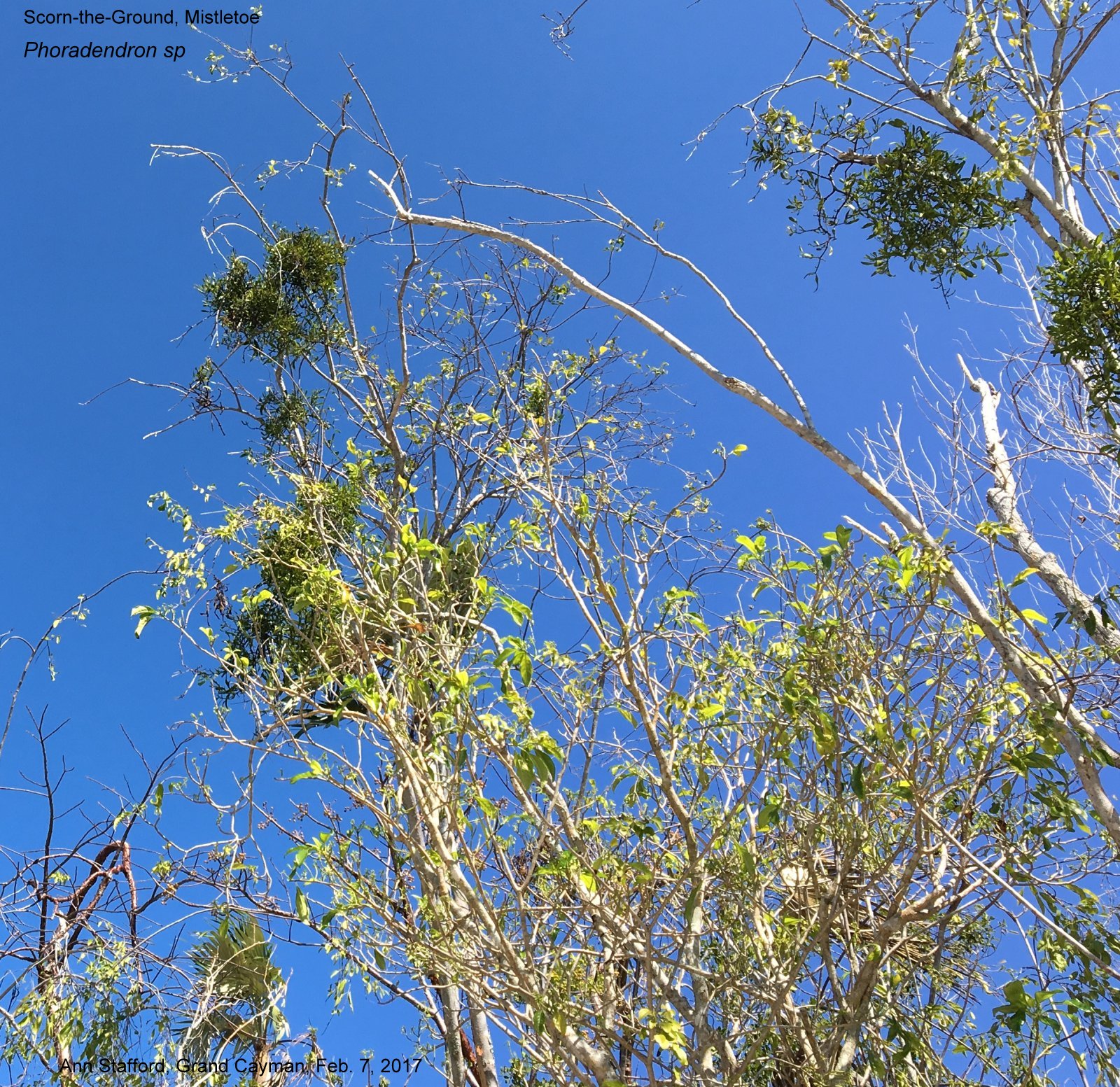 Scorn-the-Ground – Phoradendron sp, Colliers Wilderness Reserve Trail
Scorn-the-Ground – Phoradendron sp, Colliers Wilderness Reserve Trail
Scorpion Tail – Heliotropium indicum
Serasee – Momordica charantia

Soursop – Annona muricata
Strong Back, Kidney Bush, (Shiny-leaved Wild Coffee) – Psychotria nervosa, Family: RUBIACEAE, Vulnerable. Shrub up to 2.5m tall. Butterflies nectar on the white flowers, birds eat the fruit – red drupe. The leaves were used as a medicine for back trouble, a tea was made for kidneys and as a tonic.
Florida, the West Indies and continental America, variable.
Cayman plants grow is rocky woodlands. Culturally significant plant, suitable for use in landscaping.
Wild Coffee (Florida) does not contain caffeine. Seeds used as coffee substitute resulted in “only bad taste and terrible headaches”.
Flora of the Cayman Islands 2012 by George R. Proctor, p.629, Fig.240, Pl.62 Kings GC 316, Lewis GC 33a


Strong Back, Kidney Bush / Wild Coffee – Psychotria nervosa
Wild Coffee – Psychotria nervosa
Tamarind – Tamarindus indica
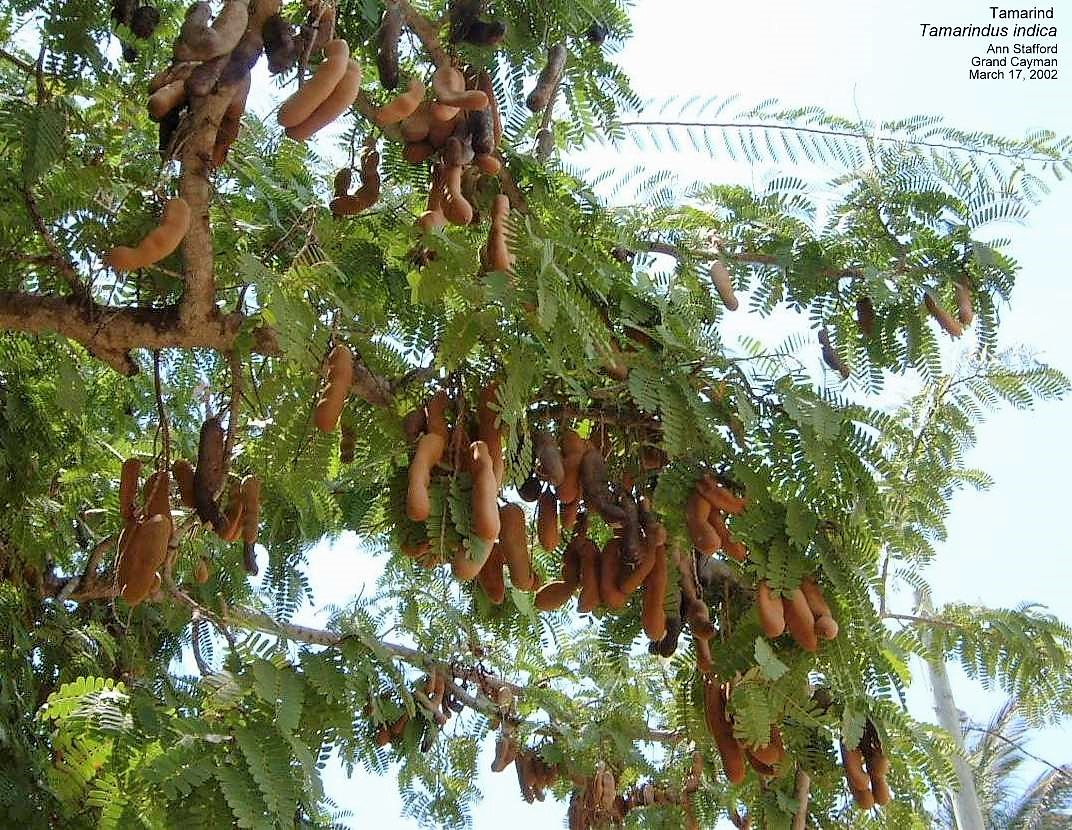
Tea Banker – Pectis caymanensis Critically Endangered
P. c. var. caymanensis Cuba and the Cayman Islands
P. c. var. robusta Grand Cayman endemic


Tea Banker – Pectis caymanensis
History It was first recorded in the botanical literature of Grand Cayman in 1899 by Charles F. Millspaugh M.D. Department of Botany Curator, Field Columbian Museum, Chicago, Illinois. Millspaugh was a guest of Allison V. Armour, the Chicago meat-packing millionaire, on a West Indian cruise of the yacht ‘Utowana’; they visited the Cayman Islands during February, 1899. The chief set of Millspaugh’s specimens is in the herbarium of the Field Museum of Natural History in Chicago. Millspaugh published lists of his collection.
On February 8, 1899, the ‘Utowana’ stopped at The Creek ,‘Cayman Brae’ (Cayman Brac) A Norther sprang up in the night, so they had to leave for a point further west, where they anchored. They did some more collecting and then sailed on to Little Cayman, but found no safe harbour. They reached Georgetown (sic), Grand Cayman after dark on Feb. 9. The Health Officer forbade them to land as their last port (Port Antonio, Jamaica) was reported to be infected with measles. They were, however, given permission to go ashore elsewhere as long as they kept away from any other person or dwelling. Because of the Norther, they anchored at ‘Spot Bay’ (Spotts).
Tea Banker was originally called Pectis cubensis, it had been found in Cuba. Millspaugh found it on Grand Cayman on Feb.14, 1899: ‘Fine full masses of this species were found in the sand of the roadside at Spot Bay, Grand Cayman (1279), but not seen elsewhere on the island. It is called “Flat-weed,” and is used in infusion as a stomachic tonic.’ (Millspaugh, 1889)
FLICKER_4 Pectis caymanensis Dec 2009
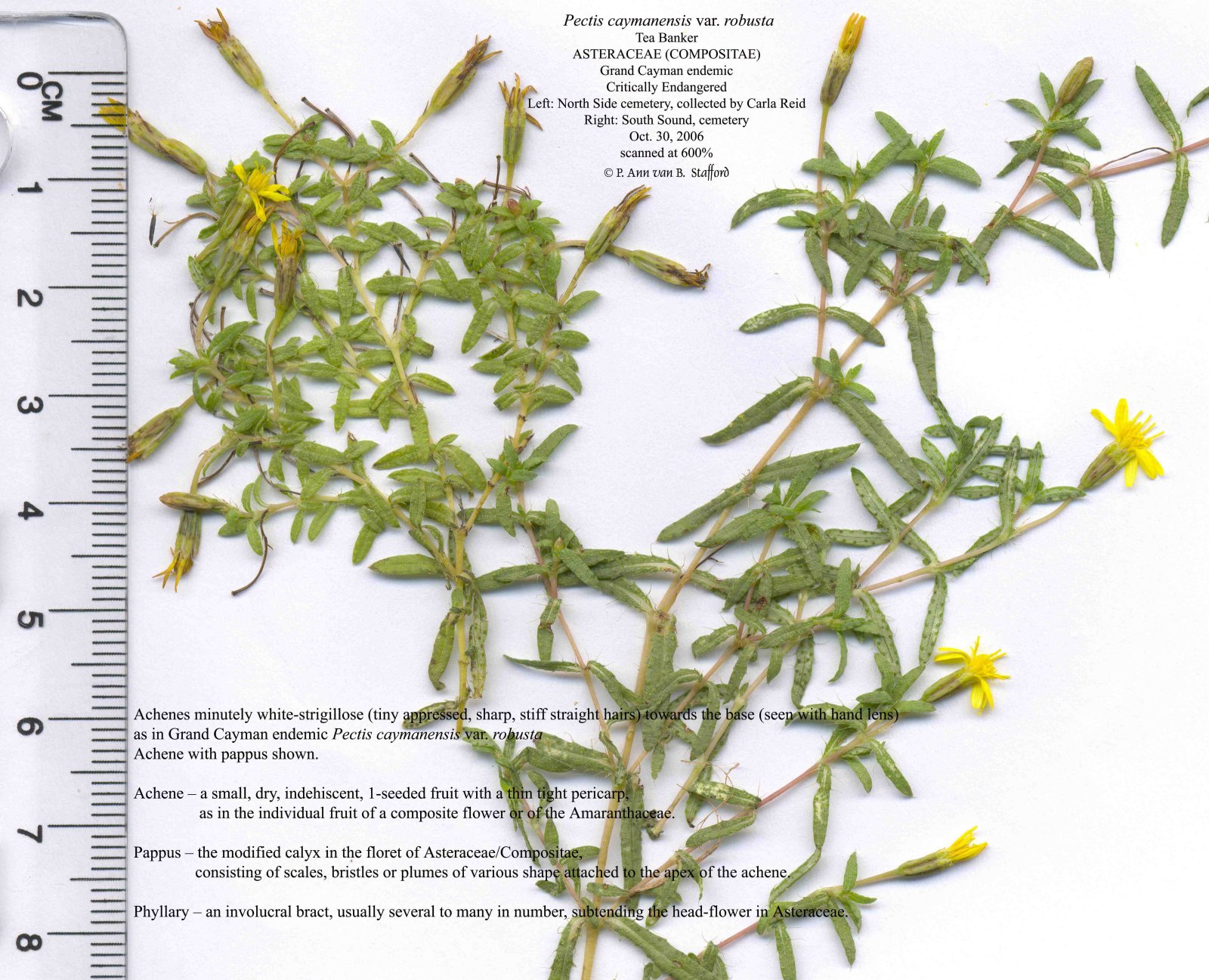
Conservation – Tea Banker is difficult to transplant. Although it can be grown from seed, it seems to require salt, such as at a beach ridge habitat, and fresh water, (when rain falls after the dry season), for the seeds to germinate.
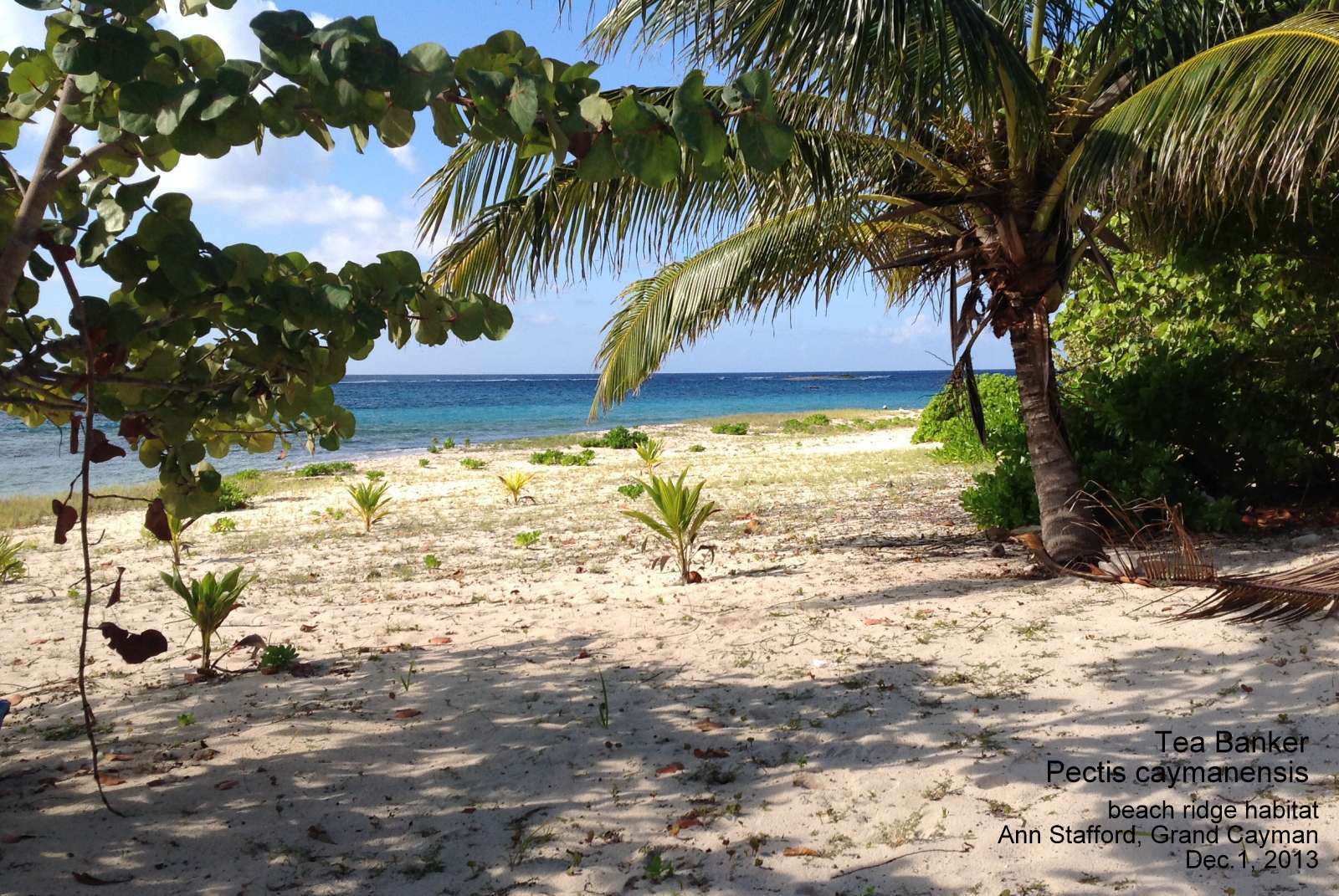
Thom Thistle – Argemone mexicana
Tittie Mollie – Euphorbia mesembrianthemifolia (syn. Chamaesyce mesembrianthemifolia)
Tobacco, Wild – Crossopetalum rhacoma
Vervine, “Worry Vine” – Stachytarpheta jamaicensis
Wormwood – Ambrosia hispida
The above list is based on HEALING PLANTS in the CAYMAN ISLANDS
compiled by Lorna McCubbin, March 15, 1995.
 Lorna McCubbin in her Wattle and Daub house, with Ironwood posts, Cousin Cora’s Cottage, Boggy Sand Road, West Bay, Jan. 19. 2003.
Lorna McCubbin in her Wattle and Daub house, with Ironwood posts, Cousin Cora’s Cottage, Boggy Sand Road, West Bay, Jan. 19. 2003.
Other Healing Plants
“Caymania”, Desmodium – Desmodium adscendens
LOOK, DON’T TOUCH!
Beware of these plants!


LOOK, don’t touch SEP20-06 text
Other Cayman Plants
native, non-native, cultivated, invasive
Bellyache Bush – Jatropha gossypiifolia, pantropical. Low shrub, leaves deeply divided, flowers deep crimson or purple. Proctor p.448 – Bitter Cassava, Wild Cassava
 Bellyache Bush – Jatropha gossypiifolia. Photo: Ann Stafford, Camana Way, Grand Cayman, April 10, 2009.
Bellyache Bush – Jatropha gossypiifolia. Photo: Ann Stafford, Camana Way, Grand Cayman, April 10, 2009.
Bulrush, Bull Rush, Rush, Cat-tail – Typha domingensis TYPHACEAE Vulnerable Wetland reed-like herb, with creeping rhizome (underground stem). In some countries, fibrous stems and leaves used for many purposes, eg thatch, soft matting, ropes and baskets. Downy wool of inflorescence can be applied like cotton to wounds and ulcers. Edible young shoots, said to taste like asparagus. Pollen can be used as flour to make bread, highly flammable.
Kings GC 216



Bulrush, Bull Rush, Zamia (Coontie, Florida Arrowroot – US) – Zamia integrifolia CYCADACEAE. Critically Endangered. Zamia is DIOECIOUS. It is the larval food plant of the Atala butterfly, which flies on Cayman Brac, but not Grand Cayman or Little Cayman although Zamia grows on all three islands. Florida, Jamaica and Puerto Rico
Kings GC 256; PCB 1
Underground root-like stem/root used to make Bulrush Porridge, Bulrush starch, which was on display at the Jamaica Exhibition of 1891.
 Zamia plant on left bears male cones, plant on right bears female cones which have bright scarlet seeds.
Zamia plant on left bears male cones, plant on right bears female cones which have bright scarlet seeds.

Jamaica International Exhibition 1891
Ref. A History of the Cayman Islands by Neville Williams 1970, p.65
 Bulrush, Zamia, starchy root and underground stem.
Bulrush, Zamia, starchy root and underground stem.
Candlenut, called ‘Walnut’ in Cayman – Aleurites moluccanus = A. moluccana (It is not related to the true Walnut – Juglans regia)
Cassava, Tapioca, Manioc, Tapioca, Yuca – Manihot esculenta. Native to Brazil. Kings GC 309, Proctor p.450

Cassava, Tapioca, Manioc, Tapioca, Yuca – Manihot esculenta
Cassava – Manihot esculenta Extract: There are several named cultivars available. The primitive “bitter cassavas” contain large amounts of cyanide and need a great deal of processing to make their roots edible. The modern “sweet” cultivars require only peeling and cooking.
Cassava meal and tapioca are made by grinding the roots in water and then evaporating off the liquid which includes the cyanide compounds. Products made from the cassava root include yuca, tapioca pudding, farinha, starch, soaps, glue, sugar, alcoholic drinks, acetone and cyanide. In tropical Asia the tender young leaves are boiled and eaten. In the Caribbean, juice extracted from cassava roots is flavored with cinnamon, cloves and sugar and called cassareep; it is used for preserving and flavoring meats, and is an essential ingredient in pepperpot stew.
Warning: All parts of the cassava plant are poisonous and must be processed by peeling, pressing or cooking before eating. It is reported that the Caribbean Arawak Indians committed suicide be eating raw cassava rather than face slavery under the Spanish invaders.
Coral Plant – Jatropha multifida, ornamental, butterfly nectar plant
Ghost Orchid* – Dendrophylax fawcettii* Grand Cayman endemic Critically Endangered
Kings GC 19, GC 19a

 Ghost Orchid – Dendrophylax fawcettii, Grand Cayman endemic, has no pseudobulbs or leaves. The very fragrant night-scented flowers may attract Sphinx (Hawk) Moths to pollinate them, probably the Giant Sphinx Moth – Cocytius antaeus medor. The photo above shows a dead. unpollinated flower, a pollinated flower forming a fruit (capsule) and new roots, the beginning of a new plant, all on the same stolon (elongated stem). The larval food plant of this moth was likely to be native Pond Apple – Annona glabra, before other Annona species were introduced: Soursop – A. muricata, Sweetsop, Sugar Apple – A. squamosa and Custard Apple, Bullock’s Heart – A. reticulata.
Ghost Orchid – Dendrophylax fawcettii, Grand Cayman endemic, has no pseudobulbs or leaves. The very fragrant night-scented flowers may attract Sphinx (Hawk) Moths to pollinate them, probably the Giant Sphinx Moth – Cocytius antaeus medor. The photo above shows a dead. unpollinated flower, a pollinated flower forming a fruit (capsule) and new roots, the beginning of a new plant, all on the same stolon (elongated stem). The larval food plant of this moth was likely to be native Pond Apple – Annona glabra, before other Annona species were introduced: Soursop – A. muricata, Sweetsop, Sugar Apple – A. squamosa and Custard Apple, Bullock’s Heart – A. reticulata.

Old George* – Wittmackia caymanensis* syn. Hohenbergia caymanensis
Grand Cayman endemic, Critically Endangered giant Bromeliad, that grows on the rocks or in trees.
Rothrock Winter of 1890-1891; Kings GC 196
 Old George – Wittmackia caymanensis syn. Hohenbergia caymanensis in its natural habitat in the Ironwood Forest, SE of George Town.
Old George – Wittmackia caymanensis syn. Hohenbergia caymanensis in its natural habitat in the Ironwood Forest, SE of George Town.
 Old George, growing on phytokarst and on trees, and Ghost Orchid, in their natural habitat. Both are Grand Cayman endemics.
Old George, growing on phytokarst and on trees, and Ghost Orchid, in their natural habitat. Both are Grand Cayman endemics.
Peregrina – Jatropha integerrima, native to Cuba; ‘Compacta’ is a smaller, more compact cultivar, ornamental, butterfly nectar plant
Physic Nut – Jatropha curcas, shrub or small tree with viscid milky or reddish sap. Proctor p.448


The Whole Truth by C. Dennis Adams
It is quite true that if you cut the bark of the Physic Nut Tree, Jatropha curcas, at noon on Good Friday it will bleed red. It is also true that if you cut it at 10am on August 28 or 3pm on January 5 it will bleed red. This does not of course bear on any conflict between Science and Religion; the matter has little to do with either, but is one of stating what is true and, by omission and implication, what is false. An incomplete statement can be as misleading as a purposely inaccurate one.
What in effect we have here is a trick to impress the gullible. Those who carry out a simple investigation can find out how the trick is made to work convincingly.
 Physic Nut – Jatropha curcas, 10 minutes later. Photo: Lois Blumenthal, April 18, 2003.
Physic Nut – Jatropha curcas, 10 minutes later. Photo: Lois Blumenthal, April 18, 2003.
Wild Oil Nut – Jatropha divaricata, monoecious shrub, native to Jamaica and Grand Cayman only. Found near Forest Glen and along the Mastic Trail. Critically Endangered. Proctor p.448

Wild Oil Nut – Jatropha divaricata
 Wild Oil Nut Jatropha divaricata fruit, Mastic Trail, May 19, 2004
Wild Oil Nut Jatropha divaricata fruit, Mastic Trail, May 19, 2004
Botanists and collectors
William Fawcett May 1888
John T. Rothrock “Winter of 1890-1891”
A. S. Hitchcock Jan. 1891
Charles F. Millspaugh Feb. 1889
C. A. Mately Jan. 1924
Wilfred Kings May-Aug. 1938
C. Bernard Lewis Apr. 1938, Dec. 1944, Mar. 1945, Dec. 1945
C. M. Maggs June 1938
George R. Proctor Feb. 1948, Apr.-May 1956, June-July 1967, Aug. 1968, Nov. 1968, Sep. 1969, Aug. 1975, Nov. 1991-Apr. 2004 (15 short collecting trips)
Marie-Helene Sachet Sep. 1958
Robert A. Dressler May 1964
Richard A. Howard & B. Wagenknecht Jan. 1969
Martin Brunt May-June 1967
Jonathan Sauer June 1967
John Popenoe Apr. 1969
Donovan S. & Helen B. Correll Nov. 1979
G. F. Guala June 1998
 Flora of the Cayman Islands
Flora of the Cayman Islands
by George R. Proctor 2012 Kew Publishing

Dr. Proctor, nearly 84 years old, with his specimen box, on the Mastic Trail, Grand Cayman. Photo: P. Ann van B. Stafford, April 6, 2004.
 Wild Trees in the Cayman Islands
Wild Trees in the Cayman Islands
by Fred Burton, illustrated by Penny Clifford, first published 1997
 Threatened Plants of the Cayman Islands The Red List
Threatened Plants of the Cayman Islands The Red List
by Frederic J. Burton, Kew Publishing 2008.

 Butterflies of the Cayman Islands
Butterflies of the Cayman Islands
by R. R. Askew and P. A. van B. Stafford, Apollo Books 2008
This book includes the butterfly larval food plants in Cayman.

Caribbean Sea
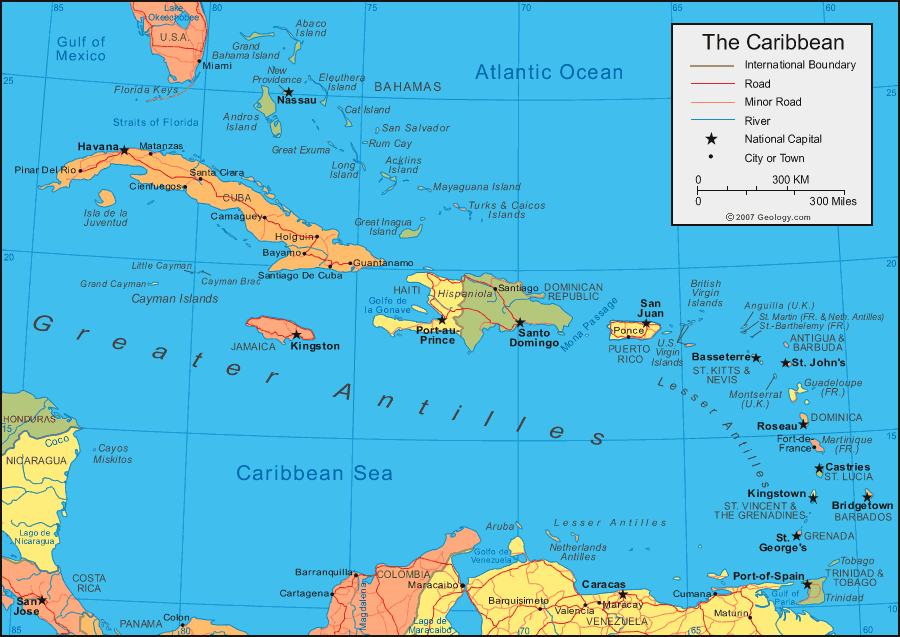

1773 Gauld map of Grand Cayman
Dates of Importation of Plants to Bermuda
from 1593.
Bermuda Plants Importation dates


1975 Royal Society – CI Gov. Little Cayman Expedition
Joint Royal Society and Cayman Islands Government Expedition to Little Cayman in 1975, when the island was little known scientifically.
Team of scientists:
D.R. Stoddart (Cambridge): geomorphology, leader
R.R. Askew (Manchester): entomology
A.W. Diamond (Nairobi): orthnithology
M.E.C. Giglioli (George Town): marine studies and liaison
M.V. Hounsome (Manchester) land fauna other than insects
G.W. Potts (Plymouth: marine ecology
G.R. Proctor (Kingston): botany
C. Woodruffe (Cambridge): Mangroves (part-time)
2015 is the 40th. Anniversary of the 1975 Little Cayman Expedition (July and August).
Atoll Research Bulletin
241. Geography and Ecology of Little Cayman
Edited by D.R. Stoddart and M.E.C. Giglioli
Issued by The Smithsonian Institution, Washington, D.C. U.S.A.
March, 1980
241. Geography and Ecology of Little Cayman
Little Cayman is the smallest of the three Cayman Islands, emergent sections of the Cayman Ridge along the northern margin of the Cayman Trench between the Sierra Maestra of Cuba and the coast of Belize. The Trench itself is 1700 km long, and has maximum depths south of the Cayman Islands of more than 6000 m. Little Cayman lies 230 km from Cabo Cruz, Cuba; the same distance from the nearest point of Jamaica; and 740 km from the mainland of Yucatan. The Caymans themselves are well separated from each other: Little Cayman is 117 km ENE from Grand Cayman, though only 7.5 km from Cayman Brac.
Little Cayman’s permanent population consisted of 18 people in 1975.
David R. Stoddart (Cambridge): geomorphology, leader
Little Cayman Atoll Research Bulletin No.241 1980
Atoll Research Bulletin March 1980. No. 241. Geography and Ecology of Little Cayman.
Edited by D.R. Stoddart and M.E.C. Giglioli
Issued by the Smithsonian Institution, Washington, DC, USA
Little Cayman Scientific Survey 1980
Marco E.C. Giglioli (George Town): marine studies and liaison
The Mosquito Research & Control Unit (MRCU) was established in 1965 when Marco Giglioli arrived from London with instructions ‘to establish a laboratory and conduct research with a view to advising the Cayman Government on suitable methods of control.’
Mosquito Research and Control Unit
Mosquito Research and Control Unit
G.W. Potts (Plymouth: marine ecology
George R. Proctor (Kingston): botany
Little Cayman Plants Proctor 1980
Michael V. Hounsome (Manchester) land fauna other than birds and insects
THE TERRESTRIAL FAUNA (EXCLUDING BIRDS AND INSECTS) OF LITTLE CAYMAN
Little Cayman Terrestrial Fauna Hounsome
Richard R. Askew (Manchester): entomology
Little Cayman is seldom mentioned in entomological literature. The 1938 Oxford University Biological Expedition spent thirteen days on the island and reports on the resulting collection deal with Odonata (Fraser, 1943), water-bugs (Hungerford, 1940), Nemoptera (Banks, 1941), cicadas (Davis, 1939), Carabidae (Darlington, 1947), Cerambycidae (Fisher, 1941, 1948), butterflies (Carpenter and Lewis, 1943) and Sphingidae (Jordan, 1940). During the 1975 expedition, insects of all orders were studied, over a period of about five weeks, and many additions will eventually be made to the island’s species list. At present, however, identification of the insects collected has, with the exception of the butterflies which have been considered separately, proceeded in the majority of cases as far as the family level. Application of the family names for the most part follows Borror and DeLong (1966). In this paper the general characteristics of the insect fauna are described.
Anthony W. Diamond (Nairobi): orthnithology
Little Cayman Birds
Ecology and species turnover of the birds of Little Cayman
1980a Atoll Research bulletin 241: 141- 164
The Red-footed Booby colony on Little Cayman; size, structure and significance
1980b Atoll Research bulletin 241: 165 -170
Colin Woodruffe (Cambridge): Mangroves
BE OF GOOD CHEER MY WEARY READERS, FOR I HAVE ESPIED LAND
By David R. Stoddart
Department of Geography, University of California, Berkeley, CA 94720.
Be of Good Cheer…..by David Stoddart
by Pat Shipman
extract:
….That’s how we learned about Cerion nanus, the rarest snail in the world. That’s a big claim for a little snail only about a centimeter long. Cerion is a common genus of air-breathing land snails in the West Indies and the Florida Keys. Different species within the genus either have no common name or are lumped together as “peanut snails” for their general shape. The most common species on Little Cayman, Cerion pannosum, is everywhere: on grasses, bushes and trees, and lying dead on the beach. The second species on Little Cayman, C. nanus, is a most uncommon snail. When we read about C. nanus in Mike Hounsome’s chapter on terrestrial invertebrates in The Cayman Islands, we were hooked. As a young man, Mike had participated in the joint Royal Society and Cayman Islands Government Expedition to Little Cayman in 1975, when the island was little known scientifically.
…Not only did Maynard conclude that Cerion nanus existed in a single, small population, he also found it almost exclusively on one plant species now known as Evolvulus squamosus. Also called the rockyplains dwarf morning glory, the species is patchily distributed on Little Cayman but also lives on many other Caribbean islands and in Florida. Maynard pronounced C. nanus “dwarfed to an extreme degree, from feeding on the pungent leaves of the plant described.” At only about half the length of C. pannosum, C. nanus seemed to compete with the larger, more ubiquitous snail.
Crab Bush – Evolvulus squamosus, Family: CONVOLVULACEAE, Endangered.
A knee-high, brushy shrub with minute leaves and white flowers. Little Cayman and the Bahamas.
It is the sole host of the diminutive land-snail, Cerion nanus, Critically Endangered Little Cayman endemic.
Photo: Ann Stafford, Grand Cayman (introduced from Little Cayman), June 9, 2002.
Flora of the Cayman Islands by George R. Proctor, 2012 p.541, Pl.51.
9. Cerion nanus (Maynard) (Mollusca: CERIONIDAE) on Little Cayman
by M.V. Hounsome and R.R. Askew
http://www.doe.ky/terrestrial/animals/snails/
Butterflies of the Cayman Islands book
R. R. Askew and P. A. van B. Stafford
published by Apollo Books Nov. 2008, available locally at
National Trust for the Cayman Islands, Dart Family Park, South Church St, Grand Cayman – US$30.00 or CI$24.00,
and local book stores.
http://www.brill.com/butterflies-cayman-islands
 FLORA of the CAYMAN ISLANDS by George R. Proctor, 2nd. Edition 2012,
FLORA of the CAYMAN ISLANDS by George R. Proctor, 2nd. Edition 2012,
published by Royal Botanic Gardens, KEW, was launched on Oct. 22, 2012.
The book is available for purchase, price CI$30, at the National Trust for the Cayman Islands and local bookstores.
The Cayman Islands (Grand Cayman, Little Cayman, and Cayman Brac) support 415 native taxa
in a land area little over 100 square miles, 29 of which are uniquely Caymanian.
Accessible and informative, this field guide satisfies the needs of the professional botanist,
while providing the non-expert and eco-tourist with an attractive introduction to the unique endemic flora of the Cayman Islands.
724 pages | 400 color plates, 250 line drawings | 6 x 9 1/5 | © 2012
Flora Gallery:

A Photographic Guide to the BIRDS of the CAYMAN ISLANDS
by Patricia E. Bradley and Yves-Jacques Rey-Millet 2013
Mangrove Skipper – Phocides pigmalion batabano, Family: HESPERIIDAE nectaring on Sea Lavender – Argusia gnaphalodes Family: BORAGINACEAE. This Mangrove Skipper subspecies is known from Andros in the Bahamas, Cuba, the Isle of Pines and Little Cayman. It has not been recorded on Grand Cayman or Cayman Brac. Photo: R.R. Askew, Little Cayman, Jan. 23, 2008. Butterflies of the Cayman Islands book, 2008 , by R. R. Askew and P. A. van B. Stafford, p.115.
Astrocasia, Chascotheca and Chinese Lantern
Flowers without petals
Family: EUPHORBIACEAE (subfamily Phyllanthoideae) / PHYLLANTHACEAE
Astrocasia tremula (Griseb.) G.L. Webster
Endangered
Dioecious arborescent glabrous shrub or small tree.
Leaves Alternate on long slender petioles, pinnate-veined, whitish-glaucous on the underside, often deciduous before flowering.
Chascotheca neopeltandra (Griseb.) Urb. synonym C. domingensis
Vulnerable
Dioceous shrub, branchlets with horizontal frond-like habit;
Leaves Alternate, 3 veined from the base, petioles 2-6mm long, blades 1-4cm long, pale or glaucous beneath
Grand Cayman, Cuba and Hispaniola in rocky limestone thickets
Phyllanthus nutans ssp. nutans Sw. Chinese Lantern
Vulnerable
Monoecious shrub
Leaves Alternate, always pinnate-veined, short-petiolate, blades up to 8 cm long, often somewhat glaucous or purple-tinged beneath.
Grand Cayman, Jamaica and the Swan Islands, in various habitats, the Cayman plants in dry, rocky woodlands
 Phyllanthus nutans ssp. nutans
Phyllanthus nutans ssp. nutans
Phyllanthus nutans IUCN Red List of Threatened Species
Click here for details and pictures:
Astrocasia, Chascotheca and Chinese Lantern
LOOK, DON’T TOUCH!

LOOK, DON’T TOUCH!
BEWARE of these PLANTS
in the Cayman Islands,
on trails, in woodlands, open areas and roadsides.
Maiden Plum – Comocladia dentata,
Bahama Nightshade – Solanum bahamense,
Manchineel – Hippomane mancinella,
Lady Hair – Malpighia cubensis,
Poison Wood, Poison Tree – Metopium toxiferum.
Shake Hand Tree – Xylosma bahamense,
Shake Hand Tree – Zanthoxylum coriaceum,
Cow Itch – Mucuna pruriens,
Vine Pear Cactus – Selenicereus grandiflorus,
Licorice, John Crow Bead, Rosary Pea, Crab’s Eyes –
Abrus precatorius,
Wire Wiss – Smilax havanensis,
Itching Vine – Tragia volubilis,
Cockspur, Gray Nickel, Nickers (the seeds) – Caesalpinia bonduc
LOOK, don’t touch Sep20-06 text
Grand Cayman NATURE TOURS

Broadleaf (Cordia sebestena var. caymanensis) and Spanish Elm (Cordia gerascanthus), Family: BORAGINACEAE
PIX – Ann Stafford, Sept. 2005
Cayman Nature Tours
The Cayman Islands were discovered by Columbus over 500 years ago. Permanent settlement came later. Indigenous plants were used for shelter, food, clothing, healing, everyday utility, boatbuilding, livelihood and export. They are part of the history, culture and identity of the Cayman Islands and what makes them unique. We don’t have large wild animals, but we do have an interesting diversity of wildlife, for which plants provide food and shelter.

Spanish Elm – Cordia gerascanthus, Family: BORAGINACEAE.
Endangered, grows on all three Cayman Islands, Greater Antilles, Mexico, Central America and Columbia.
Photo: Ann Stafford, Mar.19, 2005
Spanish Elm – Cordia gerascanthus, Family: BORAGINACEAE, is an Endangered tree that grows in dry, rocky woodlands on Grand Cayman, Little Cayman and Cayman Brac. The wood was used for making Catboat mast, gaff and boom and in general construction. The tree has showy white flowers early in the year. They soon turn brown and act as little parachutes to help seed dispersal. Range: Greater Antilles, Mexico, Central America and Columbia.

Julia butterflies – Dryas iulia zoe, Family: HELICONIIDAE, Cayman Islands endemic subspecies.
Photo: Ann Stafford. Jan. 30, 2013.
Native plants and animals are interdependent, and are part of intricate food webs. There’s a fascinating world of little-known plants and the creatures which are dependent on them – birds, bats, butterflies, dragonflies, reptiles and amphibians, hickatees, crabs and so on.
3 Julias nectaring on Roundleaf Sage/Bitter Sage – Lantana involucrata, Family: VERBENACEAE.
Click here for more information:
Grand Cayman Nature Tours
Half day Private Island Overview
or
Full Day Private Up-Close with more time to explore on foot
World Wetlands Day Feb. 2, 2013
What is World Wetlands Day?
February 2 each year is World Wetlands Day. This day marks the date of the adoption of the Convention on Wetlands on 2 February 1971, in the Iranian city of Ramsar on the shores of the Caspian Sea. Each year since 1997, the Ramsar Secretariat has provided materials so that government agencies, non-governmental organizations, conservation organizations, and groups of citizens can help raise public awareness about the importance and value of wetlands.
Midlands Acres

Black-necked Stilts, Midland Acres wetland, Grand Cayman. The pond, surrounded by Red, Black and White Mangroves, green Buttonwood and Bulrush/Cat-tail – Typha domingensis is a habitat for resident as well as migratory and Winter Visitor birds. Photo: Ann Stafford, Jan.30, 2013

Mangrove Buckeye – Junonia evarete, Family: NYMPHALIDAE, nectaring on White Mangrove – Laguncularia racemosa. Photo: Ann Stafford, Aug.10, 2008
Mangrove Buckeye – Junonia evarete, Family: NYMPHALIDAE, its only larval food plant is Black Mangrove – Avicennia germinans, Family: AVICENNIACEAE.
Meagre Bay Pond
Meagre Bay Pond, east of Bodden Town, Grand Cayman, is a protected area designated as an Animal Sanctuary. This large saline lagoon is part of the larger Central Mangrove Wetlands, which have been proposed as a Ramsar site. It is a favorite spot to watch resident and migratory birds, ducks, waders, shorebirds, Osprey and Merlin.




























































